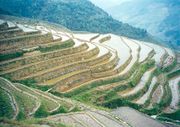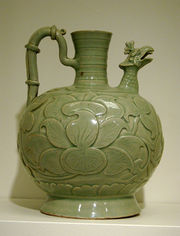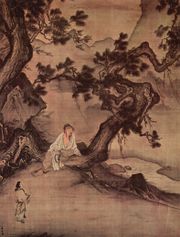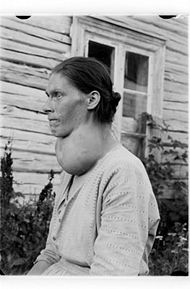List of Chinese inventions
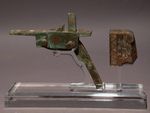
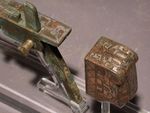
China has been the source of many significant inventions, including the Four Great Inventions of ancient China: papermaking, the compass, gunpowder, and printing (both woodblock and movable type). The list below contains these and other inventions.
The Chinese invented technologies involving mechanics, hydraulics, and mathematics applied to horology, metallurgy, astronomy, agriculture, engineering, music theory, craftsmanship, nautics, and warfare. By the Warring States Period (403–221 BC), they had advanced metallurgic technology, including the blast furnace and cupola furnace, while the finery forge and puddling process were known by the Han Dynasty (202 BC – AD 220). A sophisticated economic system in China gave birth to inventions such as paper money during the Song Dynasty (960–1279). The invention of gunpowder by the 10th century led to an array of inventions such as the fire lance, land mine, naval mine, hand cannon, exploding cannonballs, multistage rocket, and rocket bombs with aerodynamic wings and explosive payloads. With the navigational aid of the 11th-century compass and ability to steer at high sea with the 1st-century sternpost rudder, premodern Chinese sailors sailed as far as East Africa and Egypt.[1][2][3] In water-powered clockworks, the premodern Chinese had used the escapement mechanism since the 8th century and the endless power-transmitting chain drive in the 11th century. They also made large mechanical puppet theaters driven by waterwheels and carriage wheels and wine-serving automatons driven by paddle wheel boats.
The contemporaneous Peiligang and Pengtoushan cultures represent the oldest Neolithic cultures of China and were formed around 7000 BC.[4] Some of the first inventions of Neolithic, prehistoric China include semilunar and rectangular stone knives, stone hoes and spades, the cultivation of millet, rice and the soybean, the refinement of sericulture, the building of rammed earth structures with lime-plastered house floors, the creation of the potter's wheel, the creation of pottery with cord-mat-basket designs, the creation of pottery tripods and pottery steamers, and the development of ceremonial vessels and scapulimancy for purposes of divination.[5][6] Francesca Bray argues that the domestication of the ox and buffalo during the Longshan culture (c. 3000–c. 2000 BC) period, the absence of Longshan-era irrigation or high-yield crops, full evidence of Longshan cultivation of dry-land cereal crops which gave high yields "only when the soil was carefully cultivated," suggest that the plow was known at least by the Longshan culture period and explains the high agricultural production yields which allowed the rise of Chinese civilization during the Shang Dynasty (c. 1600–c. 1050 BC).[7] With later inventions such as the multiple-tube seed drill and heavy moldboard iron plow, China's agricultural output could sustain a much larger population.
For the purposes of this list, inventions are regarded as technological firsts developed in China, and as such does not include foreign technologies which the Chinese acquired through contact, such as the windmill from the Middle East or the telescope from Early modern Europe. It also does not include technologies developed elsewhere and later invented separately by the Chinese, such as the odometer and chain pump. Scientific, mathematic or natural discoveries, changes in minor concepts of design or style and artistic innovations cannot be regarded as inventions and do not appear on the list.
| Contents: |
|---|
Four Great Inventions
The following is a list of the Four Great Inventions of ancient China—as designated by Joseph Needham (1900–1995), a sinologist known for his research on the history of Chinese science—in the chronological order that they were established in China.
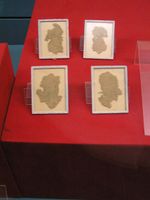
Fragments of hemp wrapping paper dated to the reign of Emperor Wu of Han (141–87 BC)
|
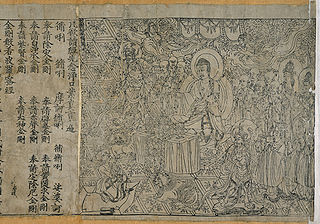
The Diamond Sutra, the oldest printed book, published in AD 868 during the Tang Dynasty (618–907)
|
Paper
- This sub-section is about papermaking; for the writing material first used in ancient Egypt, see papyrus.
Although it is recorded that the Han Dynasty (202 BC–AD 220) court eunuch Cai Lun (b.c.50–AD 121) invented the pulp papermaking process and established the use of new raw materials used in making paper, ancient padding and wrapping paper artifacts dating to the 2nd century BC have been found in China, the oldest example of pulp papermaking being a map from Fangmatan, Tianshui;[8] by the 3rd century, paper as a writing medium was in widespread use, replacing traditional but more expensive writing mediums such as strips of bamboo rolled into threaded scrolls, scrolls and strips of silk, wet clay tablets hardened later in a furnace, and wooden tablets.[9][10][11][12][13] The earliest known piece of paper with writing on it was discovered in the ruins of a Chinese watchtower at Tsakhortei, Alxa League, where Han Dynasty troops had deserted their position in AD 110 following a Xiongnu attack.[14] In the papermaking process established by Cai in 105, a boiled mixture of mulberry tree bark, hemp, old linens, and fish nets created a pulp that was pounded into paste and stirred with water; a wooden frame sieve with a mat of sewn reeds was then dunked into the mixture, which was then shaken and then dried into sheets of paper that were bleached under the exposure of sunlight; K.S. Tom says this process was gradually improved through leaching, polishing and glazing to produce a smooth, strong paper.[11][12]
Printing
Woodblock printing: The earliest specimen of woodblock printing a single-sheet dharani sutra in Sanskrit that was printed on hemp paper between 650 and 670 AD; it was unearthed in 1974 from a Tang tomb near Xi'an.[15] A Korean miniature dharani Buddhist sutra discovered in 1966, bearing extinct Chinese writing characters used only during the reign of China's only self-ruling empress, Wu Zetian (r.690–705), is dated no earlier than 704 and preserved in a Silla Korean temple stupa built in 751.[16] The first printed periodical, the Kaiyuan Za Bao was made available in AD 713. However, the earliest known book printed at regular size is the Diamond Sutra made during the Tang Dynasty (618–907), a 5.18 m (17 ft) long scroll which bears the date 868 AD, or the "fifteenth day of the fourth moon of the ninth year" of Emperor Yizong's (859–873) Xiantong 咸通 reign period.[17] Joseph Needham and Tsien Tsuen-Hsuin write that the cutting and printing techniques used for the delicate calligraphy of the Diamond Sutra book are much more advanced and refined than the miniature dharani sutra printed earlier.[17] The two oldest printed Chinese calendars are dated 877 and 882; they were found at the Buddhist pilgrimage site of Dunhuang; Patricia Ebrey writes that it is no surprise that some of the earliest printed items were calendars, since the Chinese found it necessary to calculate and mark which days were auspicious and which were not.[17][18]
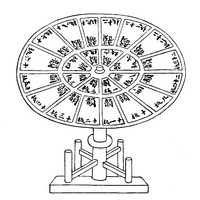
Movable type: The polymath scientist and official Shen Kuo (1031–1095) of the Song Dynasty (960–1279) was the first to describe the process of movable type printing in his Dream Pool Essays of 1088, attributing this innovation to a little-known artisan named Bi Sheng (990–1051).[19][20][21][22] With the use of fired clay characters, Shen described Bi's technical process of making the type, type-setting, printing, and breaking up the type for further use.[22][23] Bi had experimented with wooden type characters, but their use was not perfected until 1297 to 1298 with the model of the official Wang Zhen (fl. 1290–1333) of the Yuan Dynasty (1271–1368), who also arranged written characters by rhyme scheme on the surface of round table compartments.[20][24] It was not until 1490 with the printed works of Hua Sui (1439–1513) of the Ming Dynasty (1368–1644) that the Chinese perfected metal movable type characters, namely bronze.[25][26] The Qing Dynasty (1644–1912) scholar Xu Zhiding of Tai'an, Shandong developed vitreous enamel movable type printing in 1718.[27]
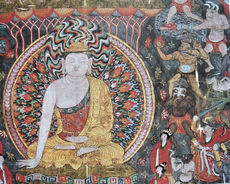
Effects on bookbinding: The advent of printing in the 9th century revolutionized bookbinding, as late Tang Dynasty paper books evolved from rolled scrolls of paper into folded leaves like a pamphlet, which developed further in the Song Dynasty (960–1279) into 'butterfly' bindings with leaves of paper folded down the center like a common book, then during the Yuan Dynasty (1271–1368) wrapped back bindings had two edges of the leaves attached to the spine and secured with a stiff paper cover on the back, and during the Ming Dynasty (1368–1644) books finally had thread-stitched bindings in the back.[28] It was not until the early 20th century that traditional Chinese thread-stitched bookbinding was replaced by Western-style bookbinding, a parallel to the replacement of traditional Chinese print methods with the modern printing press, in the tradition of Johannes Gutenberg (c. 1400–1468).[29]
Gunpowder
Although evidence of gunpowder's first use in China comes from the Five Dynasties and Ten Kingdoms Period (907–960),[30] the earliest known recorded recipes for gunpowder were written by Zeng Gongliang, Ding Du, and Yang Weide in the Wujing Zongyao military manuscript compiled in 1044 during the Song Dynasty (960–1279); the gunpowder formulas described were used in incendiary bombs lobbed from catapults, thrown down from defensive walls, or lowered down the wall by use of iron chains operated by a swape lever.[31][32][33] Bombs launched from trebuchet catapults mounted on forecastles of naval ships ensured the victory of Song over Jin forces at the Battle of Caishi in 1161, while the Mongol Yuan Dynasty (1271–1368) used gunpowder bombs during their failed invasion of Japan in 1274 and 1281.[32] During the 13th and 14th centuries, gunpowder formulas became more potent (with nitrate levels of up to 91%) and gunpowder weaponry more advanced and deadly, as evidenced in the Ming Dynasty (1368–1644) military manuscript Huolongjing compiled by Jiao Yu (fl. 14th to early 15th century) and Liu Ji (1311–1375), completed before the latter's death with a preface added by the former in a 1412 Nanyang publication of the work.[34]
Compass
Although an ancient hematite artifact from the Olmec era in Mexico dating roughly 1000 BC indicates the possible use of the lodestone compass long before it was described in China, the Olmecs did not have iron which the Chinese would discover could be magnetized by contact with lodestone.[36] Descriptions of lodestone attracting iron were made in the Guanzi, Master Lu's Spring and Autumn Annals and Huainanzi.[37][38][39] The Chinese by the Han Dynasty (202 BC–220 AD) began using north-south oriented lodestone ladle-and-bowl shaped compasses for divination and geomancy and not yet for navigation.[40][41][42] The Lunheng, written by Wang Chong (27–c. 100 AD) stated in chapter 52: "This instrument resembles a spoon, and when it is placed on a plate on the ground, the handle points to the south".[43][44] There are, however, another two references under chapter 47 of the same text to the attractive power of a magnet according to Needham (1986),[45] but Li Shu-hua (1954) considers it to be lodestone, and states that there is no explicit mention of a magnet in Lunheng.[35] Shen Kuo (1031–1095) of the Song Dynasty (960–1279) was the first to accurately describe both magnetic declination (in discerning true north) and the magnetic needle compass in his Dream Pool Essays of 1088, while the author Zhu Yu (fl. 12th century) was the first to mention use of the compass specifically for navigation at sea in his book published in 1119.[21][41][46][47][48][49][50] Even before this, however, the Wujing Zongyao military manuscript compiled by 1044 described a thermoremanence compass of heated iron or steel shaped as a fish and placed in a bowl of water which produced a weak magnetic force via remanence and induction; the Wujing Zongyao recorded that it was used as a pathfinder along with the mechanical South Pointing Chariot.[51][52][53]
Pre-Shang
Inventions which originated in what is now China during the Neolithic age and prehistoric Bronze Age are listed in alphabetical order below.
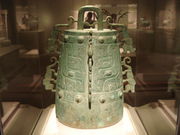
- Bell: Clapper-bells made of pottery have been found in several archaeological sites; 1 in a Yangshao site at Dahecun, Henan; 1 in a Daxi site at Yijiashan, Hubei; 7 in the Majiayao sites in Gansu; 2 in the Longshan sites at Baiying and Wadian, Henan; 1 in a Shijiahe site at Tianmen, Hubei; 2 in a Qijia site at Dahezhuang, Gansu.[54] The earliest metal bells, with one found in the Taosi site, and four in the Erlitou site, dated to about 2000 BC, may have been derived from the earlier pottery prototype.[55] Early bells not only have an important role in generating metal sound, but arguably played a prominent cultural role. With the emergence of other kinds of bells during the Shang Dynasty (c.1600–c.1050 BC), they were relegated to subservient functions; at Shang and Zhou sites, they are also found as part of the horse-and-chariot gear and as collar-bells of dogs.[56]
- Coffin, rectangular wooden: The earliest evidence of wooden coffin remains, dating from the 5000 BC are found in the Tomb 4 at Beishouling, Shaanxi. Clear evidence of wooden coffin in forms of rectangular shape are found in Tomb 152 in an early Banpo site. The Banpo coffin belongs to a four years old girl, measuring 1.4 m (4.5 ft) by 0.55 m (1.8 ft) and 3–9 cm thick. By 3000 BC, as much as 10 wooden coffins are found in the late phase of Dawenkou culture (4100–2600 BC) site at Chengzi, Shandong.[57][58] The thickness of a wooden coffin composing by more than one timber frame also emphasized the level of nobility, as mentioned in the Classic of Rites,[59] Xunzi[60] and Zhuangzi,[61] and have been found at several Neolithic sites; double coffin, consisting an outer and inner coffins, with the earliest finds in the Liangzhu culture (3400–2250 BC) site at Puanqiao, Zhejiang; triple coffin, consisting of two outer and one inner coffins, are found in the Longshan culture (3000–2000 BC) sites at Xizhufeng and Yinjiacheng in Shandong.[62] The double coffin remained used during the Warring States Period (403–221 BC), such as the lacquered double coffin of Marquis Yi of Zeng,[63] and have also found in an archaeologial site of Xiongnu's aristocracy in Inner Mongolia.[64]
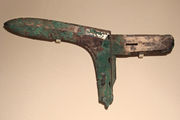
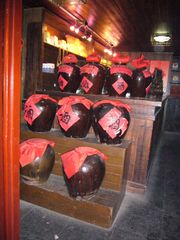
- Dagger-axe: The dagger-axe or ge was developed from agricultural stone implement during the Neothilic, dagger-axe made of stone are found in the Longshan culture (3000–2000 BC) site at Miaodian, Henan. It also appeared as ceremonial and symbolic jade weapon at around the same time, two being dated from about 2500 BC, are found at the Lingjiatan site in Anhui.[65] The first bronze ge appeared at the early Bronze Age Erlitou site,[65] where two were being found among the over 200 bronze artifacts (as of 2002) at the site,[66] three jade ge were also discovered from the same site.[67] Total of 72 bronze ge in Tomb 1004 at Houjiazhuang, Anyang,[68] 39 jade ge in tomb of Fu Hao and over 50 jade ge at Jinsha site were found alone.[65] It was the basic weapon of Shang (c.1600–1050 BC) and Zhou (c.1050 –256 BC) infantry, although it was sometimes used by the "striker" of charioteer crews. It consisted of a long wooden shaft with a bronze knife blade attached at a right angle to the end. The weapon could be swung down or inward in order to hook or slash, respectively, at an enemy.[69] By the early Han Dynasty (202 BC–220 AD), military use of the bronze ge had become limited (mostly ceremonial); they were slowly phased out during the Han Dynasty by iron spears and iron ji halberds.[70]
- Drum, alligator hide: Drums (made from clay) have been found over a broad area at the Neolithic sites from modern Shandong in the east to Qinghai in the west, dating to a period of 5500–2350 BC. In literary records, drums manifested shamanistic characteristics and were often used in ritual ceremonies.[71] Drums covered with alligator skin for ceremonial use are mentioned in the Shijing.[72][73] During the archaic period, alligators probably lived along the east coast of China, including southern Shandong. The earliest alligator drums, comprising a wooden frame covered with alligator skin are found in the archaeological sites at Dawenkou (4100 BC–2600 BC), as well as several sites of Longshan (3000 BC–2000 BC) in Shandong and Taosi (2300 BC–1900 BC) in southern Shanxi.[74]
- Fermented beverage: The discovery of late Stone Age beer jugs has established the fact that purposely fermented beverages existed in the Ancient Near East (Fertile Crescent) at least as early as c. 10,000 BC. It has been suggested that beer may have preceded bread as a staple. [75] In China, archaeologists have discovered residue of a fermented beverage that was 7,000-years old in pottery jars from the Neolithic site of Jiahu, Henan.[76][77][78][79] Chemical tests (including gas and liquid chromatography-mass spectrometry, infrared spectrometry, and stable isotope analysis) have revealed a fermented beverage of hawthorn fruit and wild grape, beeswax associated with honey, and rice. Herbal wine and a filtered rice or millet beverage was found 5000 years later in sealed Shang and Western Zhou bronze containers and has been identified as containing specialized rice or millet, flavored with herbs, flowers, and possibly tree resins.[79][80] It was found that the chemical composition of the samples is similar to those in modern rice, rice wine, grape wine, beehive wax, tannins, several herbal medicines and hawthorn.[81]
- Fork: The fork had been used in China long before the chopstick; a bone fork has been discovered by archaeologists at a burial site of the early Bronze Age Qijia culture (2400–1900 BC), and forks have been found in tombs of the Shang Dynasty (c. 1600–c. 1050 BC) and subsequent Chinese dynasties.[82]

- Lacquer: Lacquer was used in China since the Neolithic period and came from a substance extracted from the lac tree found in China.[83] A red wooden bowl, which is believed to be the earliest known lacquer container,[84] was unearthed at a Hemudu (c. 5000 BC–c. 4500 BC) site.[85] Michael Loewe says coffins at many early Bronze Age sites seem to have been lacquered, and articles of lacquered wood may also have been common, but the earliest well-preserved examples of lacquer come from Eastern Zhou Dynasty (771–256 BC) sites.[86] However, Wang Zhongshu disagrees, stating that the oldest well-preserved lacquerware items come from a Xiajiadian (c.2000–c.1600 BC) site in Liaoning excavated in 1977, the items being red lacquered vessels in the shape of Shang Dynasty bronze gu vessels.[85] Wang states that many lacquerware items from the Shang Dynasty (c.1600–c.1050 BC), such as fragments of boxes and basins, were found, and had black designs such as the Chinese dragon and taotie over a red background.[85] Queen Fu Hao (died c. 1200 BC) was buried in a lacquered wooden coffin.[87] There were three imperial workshops during the Han Dynasty (202 BC–220 AD) established solely for the purpose of crafting lacquerwares; fortunately for the historian, Han lacquerware items were inscribed with the location of the workshop where they were produced and the date they were made, such as a lacquerware beaker found in the Han colony in northwestern Korea with the inscription stating it was made in a workshop near Chengdu, Sichuan and dated precisely to 55 AD.[88]
- Millet, cultivation of: The discovery in northern China of domesticated varieties of broomcorn and foxtail millet from 8500 BC, or earlier, suggests that millet cultivation might have predated that of rice in parts of Asia.[89] Clear evidence of millet began to cultivate by 6500 BC at sites of Cishan, Peiligang, and Jiahu.[90] Archaeological remains from Cishan sum up to over 300 storeage pits, 80 with millet remains, with a total millet storage capacity estimated for the site of about 100,000 kg of grain.[91] By 4000 BC, most Yangshao areas were using an intensive form of foxtail millet cultivation, complete with storage pits and finely prepared tools for digging and harvesting the crop. The success of the early Chinese millet farmers is still reflected today in the DNA of many east Asian populations, such studies have shown that the ancestors of those farmers probably arrived in the area between 30,000 and 20,000 BP, and their bacterial haplotypes are still found in today populations throughout eastern Asia.[92]
- Noodle: In 2005, an archaeological excavation at the Lajia site of the Qijia culture (2400–1900 BC) revealed 4,000-year-old noodles made of millet (instead of traditional wheat flour) preserved by an upturned earthenware bowl that had created an airtight space between it and the sediment it was found on; the noodles resemble the traditional lamian noodle of China, which is made by "repeatedly pulling and stretching the dough by hand," according to a BBC News report on the find.[93]
- Oar, rowing: Rowing oars have been used since the early Neothilic period; a canoe-shaped pottery and six wooden oars dating from the 6000 BC have been discovered in a Hemudu culture site at Yuyao, Zhejiang.[94][95] In 1999, an oar measuring 63.4 cm (2 ft) in length, dating from 4000 BC, has also been unearthed at Ishikawa Prefecture, Japan.[96]
- Plastromancy: The earliest use of turtle shells comes from the archaeological site in Jiahu site. The shells, containing small pebbles of various size, color, and quantity, were drilled with small holes, suggesting that each pair of them was tied together originally. Similar finds have also been found in the Dawenkou burial sites of about 4000–3000 BC, as well as in Henan, Sichuan, Jiangsu and Shaanxi.[97] The turtle-shell shakers for the most part are made of the shell of land turtles,[98] identified as Cuora flavomarginata.[99] These rattles have been unearthed in quantity, with 70 being found in the Jiahu site, and another 52 being found in the Dawenkou culture sites at Dadunzi, Jiangsu, and type site, Liulin and Wangyin in Shandong.[54] Archaeologists believe that these shells were used either as rattles in ceremonial dances, shamantic healing tools or ritual paraphernalia for divinational purposes.[100]
- Plowshare, triangular-shaped: Triangular-shaped stone plowshares are found at the sites of Majiabang culture dated to 3500 BC around Lake Taihu. Plowshares have also been discovered at the nearby Liangzhu and Maqiao sites roughly dated to the same period. David R. Harris says this indicates that more intensive cultivation in fixed, probably bunded, fields had developed by this time. According to Mu Yongkang and Song Zhaolin’s classification and methods of use, the triangular plow assumed many kinds and were the departure from the Hemudu and Luojiajiao spade, with the Songze small plough in mid-process. The post-Liangzhu plows used draft animals.[101][102]
- Rice, cultivation of: In 2002, a Chinese and Japanese group reported the discovery in eastern China of fossilized phytoliths of domesticated rice apparently dating back to 11,900 BC or earlier. However, phytolith data are controversial in some quarters due to potential contamination problems.[103] It is likely that demonstrated rice was cultivated in the middle Yangtze Valley by 7000 BC, as shown in finds from the Pengtoushan culture at Bashidang, Changde, Hunan. By 5000 BC, rice had been domesticated at Hemudu culture near the Yangtze Delta and was being cooked in pots.[104] Although millet remained the main crop in northern China throughout history, several sporadic attempts were made by the state to introduce rice around the Bohai Gulf as early as 1st century.[105] At present, rice remains the main diet in southern and northeastern China as well as Korea and Japan.
- Salt, use of: The earliest salt use is argued to have taken place on Lake Yuncheng, Shanxi by 6000 BC.[106] Strong archaeological evidence of salt making dating to 2000 BC is found in the ruins of Zhongba at Chongqing. The historical records show that salt and iron monopolies often provided the bulk of state revenue, and remained important to state finance until the 20th century.[107][108] The Discourse on Salt and Iron, written by Huan Kuan during the 1st century BC relates a debate on the state monopoly over salt and iron production and distribution.
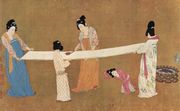
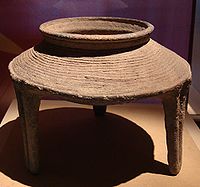
- Silk: The oldest silk found in China comes from the Chinese Neolithic period and is dated to about 3630 BC, found in Henan province.[109] Silk items excavated from the Liangzhu culture site at Qianshanyang, Wuxing District, Zhejiang date to roughly 2570 BC, and include silk threads, a braided silk belt, and a piece of woven silk.[109] A bronze fragment found at the Shang Dynasty (c. 1600–c. 1050 BC) site at Anyang (or Yinxu) contains the first known written reference to silk.[110]
- Soybean, cultivation of: The cultivation of soybeans began in the eastern half of northern China by 2000 BC, but is almost certainly much older.[111] Liu et al. (1997) stated that soybean was first originated in China and was domesticated about 3500 BC.[112] By the 5th century, soybeans were being cultivated in much of eastern Asia, but the crop did not move beyond this region until well into the 20th century.[113] Written records of the cultivation and use of the soybean in China date back at least as far as the Western Zhou Dynasty.[114]
- Steamer, pottery appliance for cooking: Archaeological excavations shown that using steam to cook began with the pottery cooking vessels known as yan steamer; a yan composed of two vessesl, a zeng with perforated floor surmounted on a pot or caldron with a tripod base and a top cover. The earliest yan steamer dating from about 5000 BC was unearthed in the Banpo site.[115] In the lower Yangzi River, zeng pots first appeared in the Hemudu culture (5000–4500 BC) and Liangzhu culture (3200–2000 BC) and used to steam rice; there are also yan steamers unearthed in several Liangzhu sites, including 3 found at the Chuodun and Luodun sites in southern Jiangsu.[116] In the Longshan culture (3000–2000 BC) site at Tianwang in western Shandong, 3 large yan steamers were discovered.[117] During the Shang Dynasty (c. 1600–c. 1050 BC), symbols for different kinds of food appliances, including the yan steamer, were inscribed on the bronze vessels.[118] They were also found in the 13th century BC tomb of Fu Hao.[119]
- Treetrunk coffin: The treetrunk coffin, single trunk coffin or boat coffin was one of the common burials found mainly in the southern China. One of the few earliest boat coffins are found among the 92 burial tombs in the Songze culture (4000–3000 BC) site at Jiaxing, Zhejiang, similar finds can also be found in the middle phase of Dawenkou culture (4100–2600 BC) sites.[62] In 2006, a treetrunk coffin measuring 6.84 m in length, dating back to the Warring States Period (403–221 BC), are found in a site at Chengdu, Sichuan.[120]
.jpg)
- Urn, pottery burial: The first evidence of pottery urn dating from about 7000 BC comes from the early Jiahu site, where a total of 32 burial urns are found,[121] another early finds are in Laoguantai, Shaanxi.[62] There are about 700 burial urns unearthed over the Yangshao (5000–3000 BC) areas and consisting more than 50 varieties of form and shape. The burial urns were used mainly for childs, but also sporadically for adults, as shown in the finds at Yichuan, Lushan and Zhengzhou in Henan.[57] A secondary burials containing bones from child or adult are found in the urns in Hongshanmiao, Henan.[122] Small hole was drilled in most of the child and adult burial urns, and is believe to enable the spirit to access.[123] It is recorded in the Classic of Rites that the earthenware coffins were used in the time of legendary period,[124] the tradition of burying in pottery urns lasted until the Han Dynasty (202 BC–220 AD) when it gradually disappered.[62] Most of the burial urns, starting from the Warring States Period (403–221 BC), are found in areas of Hebei and Liaoning.[125]
Shang and later
Inventions which made their first appearance in China after the Neolithic age, specifically during and after the Shang Dynasty (c. 1600–1050 BC), are listed in alphabetical order below.
A
- Acupuncture: Acupuncture, the traditional Chinese medicinal practice of inserting needles into specific points of the body for therapeutic purposes and relieving pain, was first mentioned in the Huangdi Neijing compiled from the 3rd to 2nd centuries BC (Warring States Period to Han Dynasty).[126] The oldest known acupuncture needles made of gold, found in the tomb of Liu Sheng (d. 113 BC), date to the Western Han (202 BC–9 AD); the oldest known stone-carved depiction of acupuncture was made during the Eastern Han (25–220 AD); the oldest known bronze statue of an acupuncture mannequin dates to 1027 during the Song Dynasty (960–1279).[127] Acupuncture is still used to treat pediatric nocturnal enuresis, i.e. bedwetting.[128]
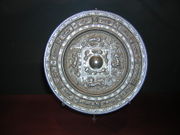
Bronze mirror of the Sui Dynasty (581–618) showing the twelve divisions of the Chinese zodiac, the latter of which goes back to the Warring States Period (403–221 BC) in China
|
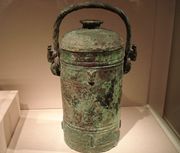
A cylindrical bronze wine container made during the late Shang Dynasty (c. 1600–c. 1050 BC); such items were excavated by gentry scholars of the Song Dynasty (960–1279).[129]
|
- Animal zodiac: The earliest and most complete version of the animal zodiac mentions twelve animals which differ slightly (for instance, the dragon is absent, represented by a worm).[130] Each animal matches the earthly branches and were written on bamboo slips from Shuihudi, dated to the late 4th century BC,[131] as well as from Fangmatan, dating to the late 3rd century BC.[131] Before these archaeological finds, the Lunheng written by Wang Chong (27–c. 100 AD) during the 1st century provided the earliest transmitted example of a complete duodenary animal cycle.[132]
- Archaeology, catalogues and epigraphy: During the Song Dynasty (960–1279), the scholar Ouyang Xiu (1007–1072) analyzed alleged ancient artifacts bearing archaic inscriptions in bronze and stone, which he preserved in a collection of some 400 rubbings;[133] Patricia Ebrey writes that he pioneered early ideas in epigraphy.[134] The Kaogutu (考古圖) or "Illustrated Catalogue of Examined Antiquity" (preface dated 1092) compiled by Lü Dalin (呂大臨) (1046–1092) is one of the oldest known catalogues to systematically describe and classify ancient artifacts which were unearthed; it featured in writing and illustrations an assortment of 210 bronze items and 13 jade items of government and private collections that dated to the Shang (c. 1600–c. 1050 BC) to Han (202 BC–220 AD) dynasties.[135] Another catalogue was the Chong xiu Xuanhe bogutu (重修宣和博古圖) or "Revised Illustrated Catalogue of Xuanhe Profoundly Learned Antiquity" (compiled from 1111 to 1125), commissioned by Emperor Huizong of Song (r. 1100–1125), and also featured illustrations of some 840 vessels and rubbings.[129][133][136] This catalogue was criticized by Hong Mai (洪迈) (1123–1202), who found that descriptions of certain ancient vessels dating to the Han Dynasty were incorrect when he compared them to actual Han Dynasty specimens he obtained for study.[136] Song scholars established a formal system of dating these artifacts by examining their inscriptions, decorative motif styles, and physical shapes.[135] Zhao Mingcheng (趙明誠) (1081–1129) stressed the importance of utilizing ancient inscriptions to correct discrepancies and errors in later texts discussing ancient events, such as with dates, geographical locations of historical events, genealogies, and official titles.[133][135][137] Ancient inscriptions on vessels were also used to revive ancient rituals for use in ceremonies.[135][138] Instead of stressing the revival of ancient rituals, Shen Kuo (1031–1095) was more interested in discovering ancient manufacturing techniques and functionality.[138] Unlike many of his peers who attributed the crafting of ancient ritual vessels to sages of old, Shen asserted that they were merely products of ancient artisans, just like in his time.[138] Shen also incorporated his study of ancient relics into other disciplines, such as music, mathematics, and optics.[138] Shen examined carved reliefs of the Zhuwei Tomb and concluded that they displayed Han Dynasty era clothing.[138] Shen unearthed a surveying tool in a garden of Jiangsu which Joseph Needham asserts was Jacob's staff.[139] Bruce G. Trigger writes that interests in antiquarian studies of ancient inscriptions and artifacts waned after the Song Dynasty, but were revived by early Qing Dynasty (1644–1912) scholars such as Gu Yanwu (1613–1682) and Yan Ruoju (1636–1704).[129] Craig Clunas also states that epigraphic studies weren't revived until the Qing Dynasty, but that printed copies of the Chong xiu Xuanhe bogutu were widely circulated in the 16th century during the Ming Dynasty (1368–1644).[140] Trigger asserts that archaeology as a discipline of its own never developed in China and was always considered a branch of historiography instead.[141]
- Anti-malarial properties of artemisia: The antimalarial drug of compound artemisinin found in Artemisia annua, the latter being a plant long used in traditional Chinese medicine, was discovered in 1972 by Chinese scientists in the People's Republic led by Tu Youyou (屠呦呦) and has been used to treat multi-drug resistant strains of Plasmodium falciparum malaria.[142][143]
- Armillary sphere, hydraulic-powered: Hipparchus (c. 190–c. 120 BC)[144] (probably in Geographica from 1st century AD)[145] credited the Greek Eratosthenes (276–194 BC) as the first to invent the armillary sphere representing the celestial sphere. However, the Chinese astronomer Geng Shouchang of the Han Dynasty (202 BC–220 AD) invented it separately in China in 52 BC, while the polymath Zhang Heng (78–139 AD) was the first to apply motive power to the rotating armillary sphere by a set of complex gears rotated by a waterwheel which in turn was powered by the constant pressure head of an inflow clepsydra clock, the latter of which he improved with an extra compensating tank between the reservoir and the inflow vessel.[146][147][148][149][150][151]
- Automatic opening doors, foot-activated trigger: Emperor Yang (r. 604–617) of the Sui Dynasty (581–618) had a private library installed in the Guanwen Hall of the palace at the capital of Daxing (modern Xi'an), having a total of fourteen studies with luxurious apparel and furniture.[152] At every third study there was a square door with curtains suspended above it as well as two figurine statues of flying immortals.[152] In the emperor's entourage were serving maids holding "perfume burners"; as he walked towards any of these entrances, they would walk in front of him and press their feet down on a trigger mechanism which not only caused the flying immortals to sweep down and pull the curtains out of the way, but made the door-halves swing backwards and opened all the cabinet doors to the book cases within the study.[152] When the emperor exited the study, the trigger was activated again and everything returned to its closed original state.[152] The Chinese were not the first to invent automatic opening doors, which were invented for a 1st century Roman temple designed by Heron of Alexandria (c. 10–70 AD), although his did not involve a foot-activated trigger mechanism,[152] but worked with the aid of steam power.[153]
B
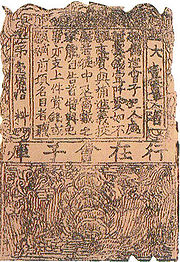
Huizi currency, issued in 1160
|
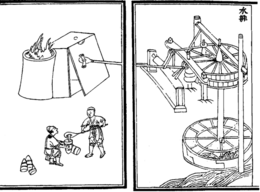
Blast furnace bellows operated by waterwheels, from a book published by Wang Zhen in 1313, Yuan Dynasty
|
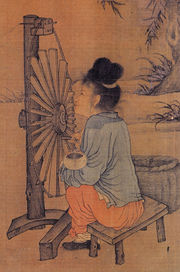
The Spinning Wheel, by Northern Song (960–1127) artist Wang Juzheng. The Chinese invented the belt drive by the 1st century BC for silk quilling devices. This was essential for the invention of the later spinning wheel, the latter invented in either China or India.[154]
|

A print illustration from an encyclopedia published in 1637 by Song Yingxing (1587–1666), showing two men working a blast furnace on the right and the puddling process on the left.
|
- Banknote: Paper currency was first developed in China. Its roots were in merchant receipts of deposit during the Tang Dynasty (618–907), as merchants and wholesalers desired to avoid the heavy bulk of copper coinage in large commercial transactions.[155][156][157] During the Song Dynasty (960–1279), the central government adopted this system for their monopolized salt industry, but a gradual reduction in copper production—due to closed mines and an enormous outflow of Song-minted copper currency into the Japanese, Southeast Asian, Western Xia, and Liao Dynasty economies—encouraged the Song government in the early 12th century to issue government-printed paper currency alongside copper to ease the demand on their state mints and debase the value of copper.[158] In the early 11th century, the Song Dynasty government authorized sixteen private banks to issue notes of exchange in Sichuan, but in 1023 the government commandeered this enterprise and set up an agency to supervise the manufacture of banknotes there.[159] The earliest paper currency was limited to certain regions and could not be used outside specified bounds, but once paper was securely backed by gold and silver stores, the Song Dynasty government initiated a nationwide paper currency, between 1265 and 1274.[157] The concurrent Jin Dynasty (1115–1234) also printed paper banknotes by at least 1214.[160]
- High-alcohol Beer: Ordinary beer in the ancient world, from Babylonia to Ancient Egypt, had an alcoholic content of 4% to 5%, while no beer in the West reached an alcohol content above 11% until the 12th century, when distilled alcohol was made in Italy.[161] Ordinary beer was consumed in China during the Shang Dynasty (c. 1600–c. 1050 BC) and was even mentioned on Shang oracle bone inscriptions as offerings to spirits during sacrifices.[162] Robert Temple writes: "The major problem with ordinary beer is that the starch in grain cannot be fermented. Thousands of years ago, it was found that sprouting grain contains a substance (the enzyme now known as amylase) which degrades the starch of grain into sugars which can then be fermented. This was the basis of ancient beer around the world."[162] Yet, around 1000 BC the Chinese created an alcoholic beverage which was stronger than 11%, a new drink which was mentioned in poetry throughout the Zhou Dynasty (c. 1050–256 BC).[162] The new process created xiao mi jiu (小米酒), which Temple describes: "This consisted of ground, partially cooked wheat (or occasionally millet) grains which had been allowed to go mouldy. These molds produce the starch-digestive enzyme amylase more efficiently than does sprouting grain. [This drink] therefore was a mixture of molds plus yeast. The Chinese would mix it with cooked grain in water, which resulted in beer. The amylase broke the starch down into sugar and the yeast fermented this into alcohol."[162] The Chinese discovered that adding more cooked grain in water during fermentation increased alcohol content.[163] This process is the same one that later Japanese utilized to make sake, or Nihonshu 日本酒.[164]
- Bellows, hydraulic-powered: Although it is unknown if metallurgic bellows (i.e. air-blowing device) in the Han Dynasty (202 BC–220 AD) were of the leather bag type or the wooden fan type found in the later Yuan Dynasty (1279–1368), the Eastern Han official Du Shi (d. 38 AD) applied the use of rotating waterwheels to power the bellows of his blast furnace smelting iron, a method which continued in use in China thereafter, as evidenced by subsequent records; it is a significant invention in that iron production yields were increased and it employed all the necessary components for converting rotary motion into reciprocating motion.[150][165][166][167][168]
- Belt drive: The mechanical belt drive, with a large wheel and small pulley, was first mentioned by the Han Dynasty (202 BC–220 AD) author Yang Xiong (53–18 BC) in 15 BC, used for a quilling machine that wound silk fibers on to bobbins for weavers' shuttles.[169] It was also featured in a Three Kingdoms era book of 230–232, and was not only later refined as the chain drive, but is an essential component to the invention of the spinning wheel.[170] In 1090, Qin Guan's book on textiles and sericulture written during the Song Dynasty (960–1279) described a mechanical belt drive for a silk-reeling device.[171] An illustration of a woman operating a multiple-spindle spinning wheel with a continuous driving belt is featured in the Book of Agriculture published in 1313 by Wang Zhen (fl. 1290–1333).[172] This silk-handling machinery was a type of flyer which laid thread evenly on reels.[173] By the 14th century, hydraulic power was applied to spinning mills in China for this purpose.[173]
- Blast furnace: Although cast iron tools and weapons have been found in China dating to the 5th century BC, the earliest discovered Chinese blast furnaces, which produced pig iron that could be remelted and refined as cast iron in the cupola furnace, date to the 3rd and 2nd centuries BC, while the vast majority of early blast furnace sites discovered date to the Han Dynasty (202 BC–220 AD) period immediately following 117 BC with the establishment of state monopolies over the salt and iron industries during the reign of Emperor Wu of Han (r. 141–87 BC); most ironwork sites discovered dating before 117 BC acted merely as foundries which made castings for iron that had been smelted in blast furnaces elsewhere in remote areas far from population centers.[174][175]
- Bomb, cast iron: The first accounts of bombs made of cast iron shells packed with explosive gunpowder—as opposed to earlier types of casings—was written in the 13th century in China.[176] The term was coined for this bomb (i.e. "thunder-crash bomb") during a Jin Dynasty (1115–1234) naval battle of 1231 against the Mongols.[177] The History of Jin 《金史》 (compiled by 1345) states that in 1232, as the Mongol general Subutai (1176–1248) descended on the Jin stronghold of Kaifeng, the defenders had a "thunder-crash bomb" which "consisted of gunpowder put into an iron container...then when the fuse was lit (and the projectile shot off) there was a great explosion the noise whereof was like thunder, audible for more than a hundred li, and the vegetation was scorched and blasted by the heat over an area of more than half a mou. When hit, even iron armour was quite pierced through."[177] The Song Dynasty (960–1279) official Li Zengbo wrote in 1257 that arsenals should have several hundred thousand iron bomb shells available and that when he was in Jingzhou, about one to two thousand were produced each month for dispatch of ten to twenty thousand at a time to Xiangyang and Yingzhou.[178] The significance of this, as Joseph Needham states, is that a "high-nitrate gunpowder mixture had been reached at last, since nothing less would have burst the iron casing."[179]
- Borehole drilling: By at least the Han Dynasty (202 BC–220 AD), the Chinese used deep borehole drilling for mining and other projects, such as using a derrick to lift liquid brine to the surface through a bamboo pipeline that led to a distilling furnace (which Michael Loewe says was heated by natural gas) where salt could be processed; scenes of this entire process are featured in artwork on Han tomb brick reliefs of Sichuan province, while Loewe states that borehole sites could reach as deep as 600 m (2000 ft).[180] K.S. Tom describes the drilling process: "The Chinese method of deep drilling was accomplished by a team of men jumping on and off a beam to impact the drilling bit while the boring tool was rotated by buffalo and oxen."[181] This was the same method used for extracting petroleum in California during the 1860s (i.e. "Kicking Her Down").[181] A Western Han Dynasty bronze foundry discovered in Xinglong, Hebei had nearby mining shafts (built to extract copper which could be smelt with tin to make bronze) which reached depths of 100 m (328 ft) into the earth with spacious mining areas; the shafts and rooms were complete with a timber frame, ladders, and iron tools.[182][183]
- Bristle toothbrush: According to a Library of Congress website, the Chinese have used the bristle toothbrush since 1498, during the reign of the Hongzhi Emperor (r. 1487–1505) of the Ming Dynasty (1368–1644); it also adds that the toothbrush was not mass-produced until 1780, when they were sold by a William Addis of Clerkenwald, England.[184] In accordance with the Library of Congress website, scholar John Bowman also writes that the bristle toothbrush using pig bristles was invented in China during the 1490s.[26] While Bonnie L. Kendall agrees with this, she noted that a predecessor existed in ancient Egypt in the form of a twig that was frayed at the end.[185]

- Bulkhead partition: The 5th century book Garden of Strange Things by Liu Jingshu mentioned that a ship could allow water to enter the bottom without sinking, while the Song Dynasty (960–1279) author Zhu Yu (fl. 12th century) wrote in his book of 1119 that the hulls of Chinese ships had a bulkhead build; these pieces of literary evidence for bulkhead partitions are confirmed by archaeological evidence of a 24 m (78 ft) long Song Dynasty ship dredged from the waters off the southern coast of China in 1973, the hull of the ship divided into twelve walled compartmental sections built watertight, dated to about 1277.[186][187] Western writers from Marco Polo (1254–1324), to Niccolò Da Conti (1395–1469), to Benjamin Franklin (1706–1790) commented on bulkhead partitions, which they viewed as an original aspect of Chinese shipbuilding, as Western shipbuilding did not incorporate this hull arrangement until the early 19th century.[188][189]
C
|
Guo Shoujing (1233–1316) established a calendar in 1281 which measured a year in roughly the same length as the Western Gregorian calendar of 1582
|
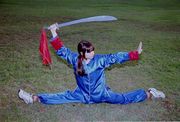
A Chinese dao (sabre); co-fusion steel, a mixture of wrought iron and cast iron, was used to craft these swords as well as sickles by the 6th century
|
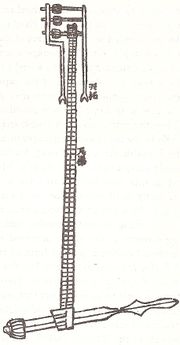
The endless power-transmitting chain drive from Su Song's book of 1094 describing his clock tower[190]
|
.svg.png)
Bellows were used not only in metallurgy by the ancient Chinese, but also in chemical warfare.
|
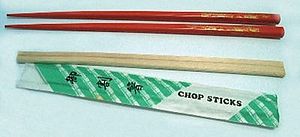
Wooden and plastic chopsticks
|

The Xuande Emperor (r. 1425–1435) playing chuiwan with his eunuchs
|
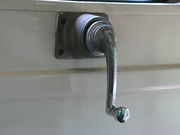
A window crank; the Chinese have used the crank since the last 2,000 years at least
|
|
A 15th-century Ming Dynasty (1368–1644) woodblock print of the Water Margin novel showing a game of cuju football being played
|
|
An earthenware model of a stove furnace from the Eastern Han Dynasty (25–220 AD); the Chinese have been using the cupola furnace since antiquity.
|
- Calendar year at 365.2425 days: In the late Spring and Autumn Period (722–481 BC), the former Sifen calendar (古四分历) was established, and set the tropical year at 365.25 days, the same length as the Julian calendar which was introduced in 46 BC. [192] The Taichu calendar (太初历) of 104 BC under Emperor Wu of Han rendered the tropical year at roughly the same (365
 ).[192] Many other calendars were established between then and the Yuan Dynasty (1271–1368), including those established by Li Chunfeng (602–670) and Yi Xing (683–727).[192] In 1281, the Yuan astronomer Guo Shoujing (1233–1316) fixed the calendar at 365.2425 days, the same as the Gregorian calendar established in 1582; this calendar, the Shoushi calendar (授時曆), would be used in China for the next 363 years.[193][194] Guo Shoujing established the new calendar with the aid of his own achievements in spherical trigonometry, which he derived largely from the work of Shen Kuo (1031–1095) who established trigonometry in China.[195][196][197]
).[192] Many other calendars were established between then and the Yuan Dynasty (1271–1368), including those established by Li Chunfeng (602–670) and Yi Xing (683–727).[192] In 1281, the Yuan astronomer Guo Shoujing (1233–1316) fixed the calendar at 365.2425 days, the same as the Gregorian calendar established in 1582; this calendar, the Shoushi calendar (授時曆), would be used in China for the next 363 years.[193][194] Guo Shoujing established the new calendar with the aid of his own achievements in spherical trigonometry, which he derived largely from the work of Shen Kuo (1031–1095) who established trigonometry in China.[195][196][197] - Cast iron: Confirmed by archaeological evidence, cast iron, made from melting pig iron, was developed in China by the early 5th century BC during the Zhou Dynasty (1122–256 BC), the oldest specimens found in a tomb of Luhe County in Jiangsu province; despite this, most of the early blast furnaces and cupola furnaces discovered in China date after the state iron monopoly under Emperor Wu (r. 141–87 BC) was established in 117 BC, during the Han Dynasty (202 BC–220 AD); Donald Wagner states that a possible reason why no ancient Chinese bloomery process has been discovered thus far is because the iron monopoly, which lasted until the 1st century AD when it was abolished for private entrepreneurship and local administrative use, wiped out any need for continuing the less-efficient bloomery process that continued in use in other parts of the world.[174][198][199][200][201] Wagner states that most iron tools in ancient China were made of cast iron in consideration of the low economic burden of producing cast iron, whereas most iron military weapons were made of more costly wrought iron and steel, signifying that "high performance was essential" and preferred for the latter.[202]
- Celadon: Named after a pale-tinted spring green color, Wang Zhongshu (1982) asserts that shards having this type of ceramic glaze have been recovered from Eastern Han Dynasty (25–220 AD) tomb excavations in Zhejiang; he also asserts that this type of ceramic became well known during the Three Kingdoms (220–265).[203] Richard Dewar (2002) disagrees with Wang's classification, stating that true celadon—which requires a minimum 1260°C (2300°F) furnace temperature, a preferred range of 1285° to 1305°C (2345° to 2381°F), and reduced firing—was not created until the beginning of the Northern Song Dynasty (960–1127).[204] The unique grey or green celadon glaze is a result of iron oxide's transformation from ferric to ferrous iron (Fe2O3 → FeO) during the firing process.[204] Longquan celadon wares, which Nigel Wood (1999) writes were first made during the Northern Song, had bluish, blue-green, and olive green glazes and high silica and alkali contents which resembled later porcelain wares made at Jingdezhen and Dehua rather than stonewares.[205]
- Chain drive, endless power-transmitting: The Greek Philon of Byzantium (3rd or 2nd century BC)[206] described a chain drive and windlass used in the operation of a polybolos (a repeating ballista),[207][208] but the chain drive did not continuously transmit power from shaft to shaft.[190][209] A continuously driven chain drive first appeared in 11th-century China. Perhaps inspired by chain pumps which had been known in China since at least the Han Dynasty (202 BC–220 AD) when they were mentioned by the Chinese philosopher Wang Chong (27–c.100 AD),[210] the endless power-transmitting chain drive was first used in the gearing of the clock tower built at Kaifeng in 1090 by the official, mathematician, and astronomer Su Song (1020–1101) during the Song Dynasty (960–1279); in addition to the escapement mechanism invented earlier in the 8th century, the chain drive was used to mechanically rotate the tower's armillary sphere crowning the top (which imitated the movements of the stars in the celestial sphere) and move one of 600 mechanical gear teeth forward every 2 minutes and 24 seconds, thus each gear tooth represented
 of a 24 hour day, each hour announced by one of 133 clock jack figurines rotated on a mechanical wheel behind opening windows where they could be seen banging gongs, drums, bells, and holding plaques for special times of day.[211][212][213]
of a 24 hour day, each hour announced by one of 133 clock jack figurines rotated on a mechanical wheel behind opening windows where they could be seen banging gongs, drums, bells, and holding plaques for special times of day.[211][212][213] - Chemical warfare using bellows, mustard smoke, and lime: As written in the 4th century BC by the Mohists, followers of the philosophy of Mozi (c. 470–c. 391 BC), the Chinese of the Warring States Period (403–221 BC) applied the use of burnt balls of the mustard plant (not to be confused with modern sulfur mustard, or 'mustard gas') as a lethal agent in warfare.[214] During a siege, the besieging force would often dig mines under the walls to breach the fortifications of the defenders.[214] As written by the Mohists, the defenders also had the option of digging to meet the enemy's underground tunnel, where bellows connected to furnaces above could be used to pump toxic smoke of burnt mustard and other vegetable material into the shafts.[214] To fight off a peasant revolt in 178 AD during the late Han Dynasty (202 BC–220 AD), riding charioteers of the Imperial forces used portable bellows to pump lime smoke at the enemy, who were ultimately defeated.[215] Powdered lime was also used in lobbed tear gas bombs, such as when the Song Dynasty (960–1279) general Yue Fei (1103–1142) used them with great success against the bandit leader Yang Yao in 1135; when the lime formed a thick fog in the air, Yang's "rebel soldiers could not open their eyes" according to the account of his campaign.[215]
- Chopsticks: The historian Sima Qian (145–86 BC) wrote in the Records of the Grand Historian that King Zhou of Shang was the first to make chopsticks out of ivory in the 11th century BC; the most ancient archaeological find of a pair of chopsticks, made of bronze, comes from Shang Tomb 1005 at Houjiazhuang, Anyang, dated roughly 1200 BC. By 600 BC, the use of chopsticks had spread to Yunnan (Dapona in Dali),[216][217] and Töv Province by 1st century.[218] The earliest known textual reference to the use of chopsticks comes from the Han Feizi, a philosophical text written by Han Fei (c. 280–233 BC) in the 3rd century BC.[219]
- Chromium, use of: The use of chromium was invented in China no later than 210 BC, the date when the Terracotta Army was interred at a site not far from modern Xi'an; modern archaeologists discovered that bronze-tipped crossbow bolts at the site showed no sign of corrosion after more than 2,000 years of being interred, the reason being that the Chinese had coated the bronze tips of their crossbow bolts in chromium; chromium was not used anywhere else until the experiments of Louis Nicolas Vauquelin (1763–1829) in 1797–1798.[220]
- Chuiwan (Chinese golf): Chuiwan, a game similar to the Scottish-derived sport of golf, was first mentioned in China by Wei Tai (fl. 1050–1100) in his Dongxuan Records (東軒錄);[221] it was popular amongst men and women in the Song Dynasty (960–1279) and Yuan Dynasty (1279–1368), while it was popular among urban men in the Ming Dynasty (1368–1644) in much the same way that tennis was for urban Europeans during the Renaissance (according to Andrew Leibs).[222] In 1282, Ning Zhi published the Book of Chuiwan, which described the rules, equipment, and playing field of chuiwan, as well as included commentary of those who mastered its tactics.[222] Chuiwan clubs, 10 in all for each player, were stored in a brocaded case.[223] The chuiwan clubs used by the emperor were lavishly decked in gold and inlaid with jade.[223] The game was played on flat and sloping grassland terrain and—much like the tee of modern golf—had a "base" area where the first of three strokes were played.[224]
- Civil service examinations: In the Han Dynasty (202 BC–220 AD), the xiaolian system of recruiting government officials through formal recommendations was the chief method of filling bureaucratic posts, although there was an Imperial Academy to train potential candidates for office and some offices required its candidates to pass formal written tests before appointment.[225][226][227][228] However, it was not until the Sui Dynasty (581–618) that civil service examinations became open to all adult males not belonging to the merchant class (although having wealth or noble status were not requirements) and were used as a universal prerequisite for appointments to office, at least in theory.[229][230] During the Sui and Tang Dynasty (618–907), the civil service system was actually implemented on a much smaller scale than during the Song Dynasty (960–1279), when an elite core of dynastic-founding and professional families lost their majority in government to a broad strata of lesser gentry families from throughout the country.[231][232] To ensure that examinations were relatively fair (despite difficult requirements and privilege of the better educated), the authorities employed numerous methods such as hiring a bureau of copyists to copy each candidate's examination answers to avoid favoritism by graders who could recognize one's signature calligraphy style.[233][234]
- Co-fusion steel process: Although both Robert Temple and Joseph Needham speculate that it could have existed beforehand, the first clear written evidence of the fusion of wrought iron and cast iron to make steel comes from the 6th century AD in regards to the Daoist swordsmith Qiwu Huaiwen, who was put in charge of the arsenal of Northern Wei general Gao Huan (496–597, later honored as Emperor Xianwu by Northern Qi) from 543 to 550 AD.[235][236] The Tang Dynasty (618–907) Newly Reorganized Pharmacopoeia of 659 also described this process of mixing and heating wrought iron and cast iron together, stating that the steel product was used to make sickles and Chinese sabers.[235] In regards to the latter text, Su Song (1020–1101) made a similar description and noted the steel's use for making swords.[235] In his encyclopedia of 1637, the Ming Dynasty (1368–1644) author Song Yingxing (1587–1666) was the first to describe the process at length, stating that the wrought iron was first beaten into tiny thin plates, packed into wrought iron sheets, and then pressed down with cast iron piled on top.[235] The cast iron would melt first in the furnace, "dripping and soaking" into the wrought iron; once united, they were taken out and forged, heated, and hammered in a process repeated numerous times.[235] Temple and Needham both state that this anticipated the open hearth furnace later invented by Carl Wilhelm Siemens (1823–1883).[236][237]
- Coke as fuel: By the 11th century, during the Song Dynasty (960–1279), the demands for charcoal used in the blast and cupola furnaces of the iron industry led to large amounts of deforestation of prime timberland; to avoid excessive deforestation, the Song Chinese began using coke made from bituminous coal as fuel for their metallurgic furnaces instead of charcoal derived from wood.[238][239][240]
- Contour canal: After numerous conquests and consolidation of his empire, China's first emperor Qin Shi Huang (r. 221–210 BC) commissioned the engineer Shi Lu (fl. late 3rd century BC) to build a new waterway canal which would pass through a mountain range and link together the Xiang River and Lijiang River.[50][241] The result of this project was the Lingqu Canal, complete with thirty-six lock gates, and since it closely follows a contour line (i.e. following the contours of the natural saddle in the hills), it is the oldest known contour canal in the world.[50][242] According to Sima Qian (145–86 BC) in his Records of the Grand Historian (compiled by 91 BC), the canal project was initiated to effectively send supplies of grain south to the armies of Zhao Tuo in the conquest of the Yue peoples.[241]
- Crank handle: The earliest known depicted crank handle in art comes from a 1st century BC Han Dynasty (202 BC–220 AD) green-glazed pottery tomb model of a farmyard, complete with a rotary grain mill, a man operating a foot tilt hammer for pounding grain, and to his left a winnowing machine with a crank handle used to operate the fan.[243][244] The crank handle in later Imperial China (Tang and Song dynasties) was also used in grain mills, silk-reeling and hemp-spinning machines, the hydraulic-powered flour-sifter, the hydraulic powered bellows, the water well windlass, and other devices.[245]
- Crossbow, handheld: The earliest reliable date for the crossbow in the Greek world is from the 5th century BC.[246] The historian Diodorus Siculus (fl. 1st century BC), described the invention of a mechanical arrow firing catapult (katapeltikon) by a Greek task force in 399 BC.[247][248] In China, bronze crossbow bolts dating as early as mid 5th century BC were found at a State of Chu burial site in Yutaishan, Hubei.[249] The earliest handheld crossbow stocks with bronze trigger, dating from the 6th century BC, comes from Tomb 3 and 12 found at Qufu, Shandong, capital of the State of Lu.[191][250] Other early finds of crossbows were discovered in Tomb 138 at Saobatang, Hunan dated to mid 4th century BC.[251][252] Repeating crossbows, first mentioned in the Records of the Three Kingdoms, were discovered in 1986 in Tomb 47 at Qinjiazui, Hubei dated to around 4th century BC.[253] The earliest textual evidence of the handheld crossbow used in battle dates to the 4th century BC.[254] Handheld crossbows with complex bronze trigger mechanisms have also been found with the Terracotta Army in the tomb of Qin Shihuang (r. 221–210 BC) that are similar to specimens from the subsequent Han Dynasty (202 BC–220 AD), while crossbowmen described in the Han Dynasty learned drill formations, some were even mounted as cavalry units, and Han Dynasty writers attributed the success of numerous battles against the Xiongnu to massed crossbow fire.[255][256] Chao Cuo (d. 154 BC) wrote a memorial to the throne in 169 BC which included his assertion that the Chinese crossbow was superior to the Xiongnu bow.[257] In a cross comparison with a contemporary civilization which created an early crossbow, the ancient Greeks had a crossbow known as the gastraphetes ("belly-bow", so named because the shooter had to draw the bow by pressing his stomach against the concave rear), which was described in Heron's Belopoeica (1st century AD),[258] yet some scholars assert that the handheld crossbow (as invented in China) was not seen in Europe until the 10th century AD.[259][260][261] Unlike the Chinese crossbow, the heavy weight and bulk of the gastraphetes necessitated a prop to keep it standing, i.e. by mounting it on a defensive wall or using a portable prop.[262]
- Cuju (football): The game of football known as cuju was first mentioned in China by two historical texts; the Zhan Guo Ce (compiled from the 3rd to 1st centuries BC) and the Records of the Grand Historian (published in 91 BC) by Sima Qian (145–86 BC).[263] Both texts recorded that during the Warring States Period (403–221 BC) the people of Linzi city, capital of the State of Qi, enjoyed playing cuju along with partaking in many other pastimes such as cockfighting.[263] Besides being a recreational sport, playing cuju was also considered a military training exercise and means for soldiers to keep fit.[263] Both Sima Qian[264] and Ban Gu (32–92 AD) in his Book of Han wrote that the general Huo Qubing (140–117 BC), after leading his troops north to attack the nomadic Xiongnu, allowed his soldiers to construct a playing field for cuju football.[263]
- Cupola furnace: Vincent C. Pigott states that the cupola furnace existed in China at least by the Warring States Period (403–221 BC),[265] while Donald B. Wagner writes that some iron ore melted in the blast furnace may have been cast directly into molds, but most, if not all, iron smelted in the blast furnace during the Han Dynasty (202 BC–220 AD) was remelted in a cupola furnace; it was designed so that a cold blast injected at the bottom traveled through tuyere pipes across the top where the charge (i.e. of charcoal and scrap or pig iron) was dumped, the air becoming a hot blast before reaching the bottom of the furnace where the iron was melted and then drained into appropriate molds for casting.[266] Pigott states that even in modern cupola furnaces, sometimes an excess of injected oxygen will cause enough decarburization that a resulting lump of low-carbon iron will appear in the furnace, similar to the wrought iron of the bloomery; although the ancient Chinese had produced wrought iron (no doubt, Pigott says, from the cupola furnace) from about the same time (c. 500 BC) cast iron appeared during the very late Spring and Autumn Period (722–481 BC), there is no direct evidence that the bloomery ever existed in China.[267]
D
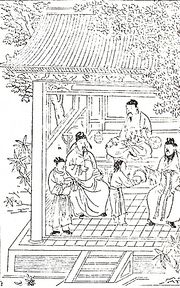
The frontispiece to Hu Sihui's Principles of Correct Diet published in 1330 (Yuan Dynasty); the caption reads "Many diseases can be cured by diet alone," a belief which spanned back to at least the 3rd century AD in China.[268]
|

A standard thirty-two-piece set of Chinese dominoes, which have existed since at least the Song Dynasty (960–1279).[269]
|
|
Ceramic models of watchtowers from the Han Dynasty (202 BC–220 AD) showing use of dougong brackets
|
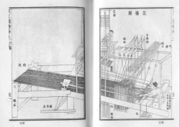
A giant drawloom for figure weaving, from the Chinese Tiangong Kaiwu encyclopedia published by Song Yingxing in 1637
|
- Deficiency diseases, correction by proper diet: As early as the 4th century BC, Warring States Period (403–221 BC), records indicate that Imperial Dieticians were appointed at royal courts.[268] The first explicit description of a regulated diet used to curb certain diseases is found in the Systematic Treasury of Medicine written by Zhang Zhongjing (c. 150–c. 219) during the late Han Dynasty (202 BC–220 AD).[268] Although Zhang did not understand the true nature of vitamins, he prescribed foods now known to be rich in certain vitamins, which were discovered to be useful after much trial and error.[268] The Tang Dynasty (618–907) official and poet Han Yu (768–824) observed that the deficiency disease beriberi (caused by lack of Vitamin B1) was far more prevalent south of the Yangzi River than north of it, an observation confirmed in the 20th century.[268] The Yuan Dynasty (1271–1368) physician and Imperial Dietician Hu Sihui (fl. 1314–1330) published his book Principles of Correct Diet which compiled a large amount of previous material written on the subject.[268] In it, Hu identified the two types of beriberi (today known as "wet" and "dry" types) and prescribed remedies of diets rich in Vitamin B1 and other vitamins.[268] Later, Christiaan Eijkman (1958–1930) was awarded the Nobel Prize in Physiology or Medicine in 1929 for discovering that beriberi was caused by a poor diet lacking the essential Vitamin B1.
- Diabetes, recognition and treatment of: In ancient China, diabetes was aptly called 'dissolutive thirst' due to diabetic patients' excessive thirst and passing of urine.[270] The Huangdi Neijing compiled by the 2nd century BC during the Han Dynasty (202 BC–220 AD) identified diabetes as a disease suffered by those who had made an excessive habit of eating sweet and fatty foods, while the Old and New Tried and Tested Perscriptions written by the Tang Dynasty (618–907) physician Zhen Quan (died 643) was the first known book to mention an excess of sugar in the urine of diabetic patients.[270][271] While his book is now lost, quotations of it were preserved in the Important Medical Formulae and Prescriptions Now Revealed by the Governor of a Distant Province, written by Wang Tao in 752.[270] The Tang physician Sun Simiao (581–682) wrote in his Thousand Golden Remedies of 655 that for diabetic patients "three things must be renounced, wine, sex, and eating salted, starchy cereal products; if this regimen can be observed, cure may follow without drugs."[272] Robert Temple writes that this is similar to the modern method of avoiding alcohol and starchy foods.[272] The sweetness of urine in diabetic patients is also noted in an ancient text of India, but unlike the Chinese texts its date is ambiguous.[272] Sweetness in urine of diabetic patients was discovered in Europe by Thomas Willis (1621–1675) around 1660 and published in 1679, yet this was not associated with sugar until 1776 in a work by Matthew Dobson; in 1815 this sugar was finally specified as glucose.[272]
- Dominoes, Chinese: The Ming Dynasty (1368–1644) author Xie Zhaozhe (1567–1624) initiated the legend that dominoes were first presented to the imperial court in 1112.[269] However, the oldest confirmed written mention of dominoes in China comes from the Former Events in Wulin (i.e. the capital Hangzhou) written by the Yuan Dynasty (1271–1368) author Zhou Mi (1232–1298), who listed "pupai" (gambling plaques or dominoes) as well as dice as items sold by peddlers during the reign of Emperor Xiaozong of Song (r. 1162–1189).[269] Andrew Lo asserts that Zhou Mi meant dominoes when referring to pupai, since the Ming author Lu Rong (1436–1494) explicitly defined pupai as dominoes (in regards to a story of a suitor who won a maiden's hand by drawing out four winning pupai from a set).[269] The earliest known manual written about dominoes is the Manual of the Xuanhe Period (1119–1125) written by Qu You (1347–1433).[269] In the Encyclopedia of a Myriad of Treasures, Zhang Pu (1602–1641) described the game of laying out dominoes as pupai, although the character for pu had changed (yet retained the same pronunciation).[269] Traditional Chinese domino games include Tien Gow, Pai Gow, Che Deng, and others. The thirty-two-piece Chinese domino set (made to represent each possible face of two thrown dice and thus have no blank faces) differs from the twenty-eight-piece domino set found in in the West during the mid 18th century (in France and Italy).[273]
- Dougong: A dougong is a building bracket which is unique to Chinese architecture. Since at least the Western Zhou Dynasty (c. 1050–771 BC), they were placed between the top of a column and a crossbeam to support the concave roofs of beam-in-tier buildings which were archetypal of Chinese architecture.[274] Each dougong is formed by double bow-shaped arms (拱, gong) supported by a wooden block (斗, dou) on each side.[274] Dougong were also used for decorative and ceremonial rather than entirely pragmatic purposes of support, such as on solid brick pagodas like the Iron Pagoda built in 1049. The Yingzao Fashi building manual published in 1103 by the Song Dynasty (960–1279) official Li Jie featured illustrations and descriptions of dougong.[275]
- Drawloom: The earliest confirmed drawloom fabrics come from the State of Chu and date circa 400 BC.[276] Most scholars attribute the invention of the drawloom to the ancient Chinese, although some speculate an independent invention from ancient Syria since drawloom fabrics found in Dura-Europas are thought to date before 256 AD.[276][277] Dieter Kuhn states that an analysis of texts and textiles from the Han Dynasty (202 BC–220 AD) proves that the figured fabrics of that era were also crafted with the use of a drawloom.[278] The drawloom was certainly known in Persia by the 6th century AD.[276] Eric Broudy asserts there is virtually no evidence of its use in Europe until the 17th century, while the button drawloom was allegedly invented by Jean le Calabrais in the 15th century.[279] Mary Carolyn Beaudry disagrees, stating that it was used in the medieval Italian silk industry.[278]
E
- Endocrinology, isolation of sex and pituitary hormones from urine: In 1110, a Chinese medical text specified the use of gypsum (containing calcium sulfate) as well as saponin from the beans of Gleditschia sinensis to extract hormones from urine, a process of using natural soaps which was not discovered elsewhere until the use of digitonin by Adolf Windaus (1876–1959) in 1909.[280] In 1927, Selmar Ascheim (1878–1965) and Bernhard Zondek (1891–1966) discovered that urine of pregnant women had a high concentration of steroid sex hormones; a subsequent discovery was made that urine contained sex hormones of androgens and estrogens, as well as the pituitary hormone gonadotrophin.[281] In modern medicine, the extraction of these hormones from urine is a standard practice, yet centuries before this the Chinese had used it to treat hypogonadism, impotence, spermatorrhea, dysmenorrhea, leukorrhea, and even stimulating the growth of beards (since they knew that castration resulted in the loss of ability to grow a beard).[282]
- Escapement (use in clockworks): Although the escapement mechanism was first invented by the Greek Philon of Byzantium for a mechanical washstand,[283] an escapement mechanism for clockworks was first developed by the Buddhist monk, court astronomer, mathematician and engineer Yi Xing (683–727) of the Tang Dynasty (618–907) for his water-powered celestial globe in the tradition of Zhang Heng (78–139), and could be found in later Chinese clockworks such as the clock towers of both Zhang Sixun (fl. late 10th century) and Su Song (1020–1101).[156][213][284][285][286][287] Yi Xing's escapement allowed for a bell to be rung automatically every hour, and a drum beaten automatically every quarter hour, essentially a striking clock.[288] Unlike the modern escapement which employs a suspended oscillating pendulum resting and releasing its hooks on a small rotating gear wheel, the early Chinese escapement employed the use of gravity and hydraulics.[289] In Su Song's clock tower, scoop containers fixed to the spokes of a vertical waterwheel (which acted like a gear wheel) would be filled one by one with siphoned water from a clepsydra tank.[290] When the weight of the water in the scoop filled to an excess, it overcame a counterweight that in turn tripped a lever allowing the scoop to rotate on a pivot and drain its water.[290] However, as the scoop fell, it tripped a coupling tongue that temporarily pulled down on a long vertical chain, the latter yanking down on a balancing lever which would pull upward on a small chain connected to a locking arm, the latter lifting momentarily to release the top arrested spoke before coming back down to repeat the entire process over again.[290] It should be pointed out that the Chinese intermittently working liquid-driven escapement had "only the name in common" with the true mechanical escapement of later medieval mechanical clocks which worked instead with weights, producing continuous but discrete beats.[291][292]
- Exploding cannonballs: The Huolongjing military manual compiled by Jiao Yu (fl. 14th to early 15th century) and Liu Ji (1311–1375) in the mid 14th century described the earliest known exploding cannonballs, which were made of cast iron with a hollow core packed with gunpowder; Jiao and Liu wrote that when fired, they could set enemy camps ablaze; the earliest evidence for exploding cannonballs in Europe date to the 16th century.[293][294] The Huolongjing also specified the use of 'blinding' and 'poison' gunpowder filled into exploding shells; the effects of this chemical warfare was described as such: "Enemy soldiers will get their faces and eyes burnt, and the smoke will attack their noses, mouths, and eyes."[215]
F
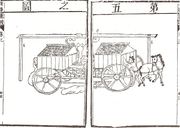
The field mill in the Chinese book Yuanxi Qiqi Tushuo Luzui (Collected Diagrams and Explanations of the Wonderful Machines of the Far West), by Johann Schreck and Wang Zheng, 1627
|
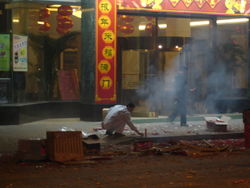
Local man setting off fireworks during Chinese New Year in Shanghai
|
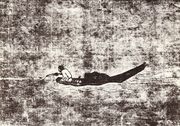
"Angler on a Wintry Lake", painted in 1195 by Ma Yuan, featuring the oldest known depiction of a fishing reel
|
|
Chinese flamethrower from the Wujing Zongyao manuscript of 1044, Song Dynasty
|
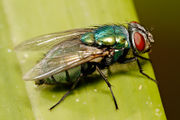
By the 13th century, the Chinese used the blow-fly as an agent to solve murder cases in early forensic entomology.
|
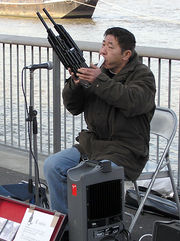
Sheng player Guo Yi beside the River Thames, London, England
|
- Field mill (carriage): In the Yezhongji ('Record of Affairs at the Capital Ye of the Later Zhao Dynasty') written by Lu Hui (fl. 350 AD), various mechanical devices are described which were invented by two Later Zhao (319–351) engineers known as Xie Fei, a Palace Officer, and Wei Mengbian, the Director of the Imperial Workshops.[295] One of these is the field mill, which was essentially a cart with millstones placed onto the frame; these were mechanically rotated by the movement of the cart's terrain wheels in order to grind wheat and other cereal crops.[296] A similar vehicle these two invented was the "pounding cart", which had wooden statues mounted on the top which were actually mechanical figures who operated real tilt hammers in order to hull rice; again, the device only functioned when the cart was moved forward and the wheels turned.[296] The field mill lost its use in China sometime after the Later Zhao, but it was invented separately in Europe in 1580 by the Italian military engineer Pompeo Targone.[297] It was featured in a treatise by Vittorio Zonca in 1607, and then in a Chinese book of 1627 (concerning Western technology) that was compiled and translated by the German Jesuit Johann Schreck (1576–1630) and the Ming Dynasty (1368–1644) Chinese author Wang Zheng (王徵 1571–1644), although by then it was considered by the Chinese to be an original Western contraption.[298]
- Finery forge: In addition to accidental lumps of low-carbon wrought iron produced by excessive injected air in Chinese cupola furnaces, the ancient Chinese also created wrought iron by using the finery forge at least by the 2nd century BC, the earliest specimens of cast and pig iron fined into wrought iron and steel found at the early Han Dynasty (202 BC–220 AD) site at Tieshengguo.[299] Pigott speculates that the finery forge existed in the previous Warring States Period (403–221 BC), due to the fact that there are wrought iron items from China dating to that period and there is no documented evidence of the bloomery ever being used in China.[300] The fining process involved liquifying cast iron in a fining hearth and removing carbon from the molten cast iron through oxidation.[299] Wagner writes that in addition to the Han Dynasty hearths believed to be fining hearths, there is also pictoral evidence of the fining hearth from a Shandong tomb mural dated 1st to 2nd century AD, as well as a hint of written evidence in the 4th century AD Daoist text Taiping Jing.[301] Both Wagner and Pigott write that the fining hearth was a key feature of traditional Chinese iron smelting in recent centuries.[299][302]
- Fire lance: The fire lance was a proto-gun developed in the 10th century with a tube of first bamboo and later on metal that shot a weak gunpowder blast of flame and shrapnel; its earliest representation comes from a painting found at Dunhuang.[303][304][305]
- Fireworks: Fireworks first appeared in China during the Song Dynasty (960–1279), in the early age of gunpowder. The common people in the Song era could purchase simple fireworks from market vendors; these were made of sticks of bamboo packed with gunpowder,[306] although grander displays were known to be held. In 1110, a large fireworks display in a martial demonstration was held to entertain Emperor Huizong (r. 1100–1125) and his court, accompanied by dancers moving through colored smoke.[307] In 1264, Empress Dowager Gong Sheng became frightened during a feast held in her honor (by her son Emperor Lizong) when a fast rocket-propelled "ground rat" was lit off.[308] Rocket propulsion was soon applied to warfare, and by the time of the mid 14th century there were many types of rocket launchers available.[309]
- Fishing reel: In literary records, the earliest evidence of the fishing reel comes from a 4th century AD[310][311] work entitled Lives of Famous Immortals.[312][313] The earliest known depiction of a fishing reel comes from a Southern Song (1127–1279) painting done in 1195 by Ma Yuan (c. 1160–1225) called "Angler on a Wintry Lake," showing a man sitting on a small sampan boat while casting out his fishing line.[314] Another fishing reel was featured in a painting by Wu Zhen (1280–1354).[314] The book Tianzhu lingqian (Holy Lections from Indian Sources), printed between 1208 and 1224, features two different woodblock print illustrations of fishing reels being used.[314] An Armenian parchment Gospel of the 13th century shows a reel (though not as clearly depicted as the Chinese ones).[314] The Sancai Tuhui, a Chinese encyclopedia published in 1609, features the next known picture of a fishing reel and vividly shows the windlass pulley of the device.[314] These five pictures mentioned are the only ones which feature fishing reels before the year 1651 (when the first English illustration was made); after that year they became commonly depicted in world art.[314]
- Flamethrower, double piston and gunpowder-activated: Although the single piston flamethrower was first developed in the Byzantine Empire during the 7th century,[315] the 10th century Chinese flamethrower, or Pen Huo Qi, boasted a continuous stream of flame by employing double piston syringes (which had been known since the Han Dynasty) spouting Greek fire which had been imported from China's maritime trade contacts in the Middle East. Its first use in battle was in 932 during the Five Dynasties and Ten Kingdoms Period (907–960), and its first drawn illustration is found in the early Song Dynasty (960–1279) military manuscript Wujing Zongyao of 1044, which also described the device in full.[316][317] Unlike the Greek model which employed a furnace, the Pen Huo Qi was ignited by an incendiary gunpowder fuse.[316]
- Flare, military signalling: The earliest recorded use of a flare for signalling purposes was the 'signal bomb' used by the Song Dynasty (960–1279) Chinese as the Mongol-led Yuan Dynasty (1271–1368) besieged Yangzhou in 1276.[318] These soft-shelled bombs, timed to explode in mid-air and perhaps producing a vibrant colored burst like contemporary Chinese fireworks produced, were used to send messages to a detachment of troops far in the distance.[318]
- Forensic entomology: The Song Dynasty (960–1279) forensic science work Collected Cases of Injustice Rectified published by Song Ci in 1247 contains the oldest known case of forensic entomology.[319] In a murder case of 1235, a villager was stabbed to death and authorities determined that his wounds were inflicted by a sickle; this was a tool used for cutting rice at harvest time, a fact which led them to suspect a fellow peasant worker was involved.[319] The local magistrate had the villagers assemble in the town square where they would temporarily relinquish their sickles.[319] Within minutes, a mass of blow flies gathered around one sickle and none other, attracted to the scent of traces of blood unseen by the naked eye.[319] It became apparent to all that the owner of that sickle was the culprit, the latter pleading for mercy as he was detained by authorities.[319]
- Free reed aerophone: The musical pipe organ employing metal piston bellows had a long history in the West.[320] It was an invention of the Hellenic Alexandrians and was described in minute detail by the Roman engineer Vitruvius in the late 1st century BC, although it is now more commonly associated with the Christian liturgy.[320] However, the Western pipe organ did not make use of the reed, which the ancient Chinese mouth organ employed.[320] The latter instrument, called a sheng and made traditionally of bamboo pipes, was first mentioned in the Shi Jing of the Zhou Dynasty (c. 1050–256 BC).[320] The Chinese sheng is considered the ancestor of the harmonica, harmonium, concertina, accordion, and all other reed organ instruments.[320] A free reed organ was invented in the Arab world in the 13th century, while the German Heinrich Traxdorf (fl. 15th century) of Nuremberg built one around 1460 AD.[321] It is thought that the classical Chinese sheng travelled west through Russia during the 19th century, as it was described then in Saint Petersburg.[320]
G
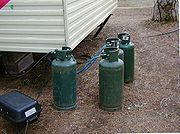
Modern gas cylinders; the Chinese used a bamboo version of this by at least the Tang Dynasty (618–907).
|

A set of three rotating gimbals
|

The go board game
|
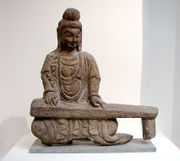
Rock carving of a bodhisattva playing a guqin, Northern Wei Dynasty (386–534 AD)
|
- Gas cylinder: From deep boreholes drilled during the Han Dynasty (202 BC–220 AD), the Chinese had used bamboo pipelines to transport natural gas to stoves where cast iron pans were used to boil brine and extract salt.[322] A gazetteer written before the 10th century during the Tang Dynasty (618–907) stated that a 'fire well' of Linqiong in what is now Sichuan reached depths of 182 m (600 ft) and spouted flames at the top.[323] It stated that people used the gas from this 'fire well' to fill portable tubes which could be carried around over a hundred li (dozens of km or mi) and still be lit at the end to produce a flame.[323] Robert Temple assumes that some sort of tap was used for this.[324] A 17th or 18th century gazetteer from the Qing Dynasty (1644–1912) states that a leather bag could be filled with natural gas, punctured with a tiny hole, touched by fire, and instantly give heat and light.[325] A Song Dynasty (960–1279) book of 980 also records the use of petroleum (which the Chinese called "stone lacquer") in portable bamboo tubes which could be used for lighting at night "in the same manner as ordinary people carry torches."[324] A 16th century book from the Ming Dynasty (1368–1644) also states that petroleum was used as fuel in lamps which could substitute for candles.[324]
- Gimbal ('Cardan' suspension): The gimbal is known as the 'Cardan' suspension after Gerolamo Cardano (1501–1576), yet it was known long before him.[326] Joseph Needham writes that the earliest confirmed use of gimbals in Europe is the 9th century recipe book Little Key of Painting (Latin: Mappae Clavicula), which mentioned a vase surrounded by rings which allowed it to be undisturbed when in a rolling motion.[327] Needham and George Sarton both write that an Arabic translation—dated to roughly the era of Al-Ma'mun (r. 813–833)—of an ancient Greek work now lost (i.e. Pneumatica) by Philo of Byzantium (c. 280–c. 220 BC) contains a description of gimbals used to support an inkpot that could wet a pen on any of its sides, yet Needham suspects Arabic interpolation and doubts total authenticity, while Sarton asserts that for the most part the Arabic translation is faithful to Philo's lost original, hence Philo should be credited with the invention of the gimbal.[328][329] Around 180 AD, the Han Dynasty (202 BC–220 AD) inventor Ding Huan (丁緩)—who also created a rotary fan and zoetrope lamp—invented a 'Perfume Burner for use among Cushions', or 'Bedclothes Censer'.[330] This incense burner had a series of metal rings which could be moved in any direction while the burner in the middle remained constantly level.[330] This is the first clear reference in China of the gimbal, although there is a hint in the writing of Sima Xiangru (179–117 BC) that this device existed in the 2nd century BC (i.e., 'the metal rings burning perfume').[331] The gimbal incense burner is mentioned in subsequent dynasties, while silverwork specimens of gimbal incense burners from the Tang Dynasty (618–907) still exist.[332] In the Liang Dynasty (502–557) there is mention of gimbals used in hinges for doors and windows, while an unnamed artisan presented a warming stove to Wu Zetian (r. 690–705) in 692 which employed gimbals to keep it constantly balanced.[333]
- Go (board game) (Weiqi in Chinese): Although ancient Chinese legend (perhaps contrived during the Han Dynasty) has it that the mythological ruler Yao came down to earth from the Heavens around 2200 BC carrying with him a go board and stone player's pieces, it is known from existing literature that the go board game existed since at least the 10th century BC during the Zhou Dynasty (c. 1050–256 BC) and was even mentioned in writing by the philosophers Confucius (551–479 BC) and Mencius (371–289 BC), although the latter two had a slightly negative opinion of it.[334][335]
- Guqin: The guqin is one of the oldest stringed zither instruments from China and has existed since at least the Shang Dynasty (c. 1600–c. 1050 BC), as a Shang oracle bone contains the oldest known inscription of the Chinese character for qin (琴).[336] The oldest example of a guqin comes from the tomb of Marquis Yi of Zeng (433 BC); Bo Lawergren argues they may have developed from Middle Eastern harps like konghou, which was also found in Qiemo, Xinjiang dating to 400–200 BC.[337] It was said to be popular in the Zhou Dynasty (c. 1050–256 BC), while the oldest known written tablature for the guqin dates to the Han Dynasty (202 BC–220 AD).[336] The guqin became a musical instrument highly associated with China's gentry class when it was exalted as one of the Four Arts of the Chinese Scholar as well as one of the gentry's "nine guests" described by Shen Kuo (1031–1095);[338] it was even featured in painted artwork, such as in a 12th century piece by Emperor Huizong himself.
H
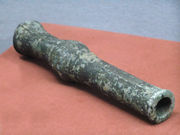
A bronze hand cannon from the Yuan Dynasty (1271–1368), one of the oldest in the world; the oldest specimen dates to about 1288, when the first textual reference to the hand cannon appears in Chinese literature.
|
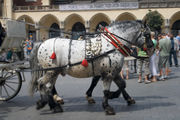
A horse wearing a decorative harness with a horse collar; the Chinese have utilized the horse collar certainly by the 5th century AD, and perhaps earlier.
|

A Sui Dynasty (581–618 AD) cart figurine pulled by a bull
|
- Hand cannon: The earliest metal-barrel hand cannons dating to the 13th century are attested to by archaeological evidence from a Heilongjiang excavation as well as written evidence in the Yuanshi (1370) concerning Li Tang, an ethnic Jurchen commander under the Yuan Dynasty (1271–1368) who in 1288 suppressed the rebellion of the Christian prince Nayan with his "gun-soldiers" or chongzu, this being the earliest known event where this phrase was used.[339][340] The bronze Yuan Dynasty gun from Heilongjiang which dates to about 1288 is a little over 0.3 m (1 ft) in length and weighs 3.6 kg (8 lbs).[340] It has a small touch hole for ignition and an even bore except for the bulbous enlargement around the explosion chamber, a design which allowed the weapon to brace the force of the internal explosion.[340]
- Heavy moldboard iron plow: Although use of the simple wooden ard in China must have preceded it, the earliest discovered Chinese iron plows date to roughly 500 BC, during the Zhou Dynasty (1122–256 BC) and were flat, V-shaped, and mounted on wooden poles and handles.[341][342] By the 3rd century BC, improved iron casting techniques led to the development of the heavy moldboard plow, seen in Han Dynasty (202 BC–220 AD) artwork such as tomb carved bricks.[341] The moldboard allowed the Chinese to turn farm soil without clogging the plowshare with dirt, which was flung off the wheelbarrow via slanted wings on both sides.[343] While the frame of excavated plowshares dating to the Warring States Period (403–221 BC) were made mostly of perishable wood except for the iron blade, the frame of excavated plowshares dating to the Han Dynasty were made entirely of solid iron with the moldboard attached to the top to turn the soil.[344]
- Horse collar: A significant improvement of the ancient breast harness was the horse collar. Robert Temple speculates that a Han Dynasty brick from the 1st century BC shows the first depiction of a horse collar.[345] It was certainly depicted in a Northern Wei (386–534) mural at Dunhuang, China, dated 477–499; the latter artwork does not feature the essential collar cushion behind the cross bar, though, while a later Tang Dynasty (618–907) mural of about 851 AD accurately displays the cushioned collar behind the cross bar.[346][347] An earlier painting of the Sui Dynasty (581–618) accurately depicted the horse collar as it is seen today, yet the illustration shows its use on a camel instead of a horse.[348]
- Horse harness, ("trace" or "breast"): Throughout the ancient world, the 'throat-and-girth' harness was used for harnessing horses that pulled carts; this greatly limited a horse's ability to exert itself as it was constantly choked at the neck.[349][350] A painting on a lacquerware box from the State of Chu, dated to the 4th century BC, shows the first known use of a yoke placed across a horses's chest, with traces connecting to the chariot shaft.[351][352] The hard yoke across the horse's chest was gradually replaced by a breast strap, which was often depicted in carved reliefs and stamped bricks of tombs from the Han Dynasty (202 BC–220 AD).[353] Eventually, the horse collar was invented in China, at least by the 5th century.[346][354]
- Hybrid rice: A team of agricultural scientists headed by Yuan Longping (b. 1930) developed a new type of rice called hybrid rice in 1973 which allows for roughly 12,000 kg (26,450 lbs) of rice to be grown per hectare (10,000 m2).[142] Hybrid rice has proven to be greatly beneficial in areas where there is little arable land, and has been adopted by several Asian and African countries.[142]
I
- India ink: Although named after carbonaceous pigment materials originating from India, Indian ink first appeared in China; some scholars say it was made as far back as the 3rd millennium BC, while others state it was perhaps not invented until the Wei Dynasty (220–265 AD).[355][356][357][358] Although early ink mixtures contained the soot of pine, the scholar-official Shen Kuo (1031–1095) was the first to create an India ink from the soot of petroleum, which Li Shizhen (1518–1593) later wrote was lustrous like lacquer and superior to ink made from pine soot.[359][360][361][362]
- Inoculation, treatment of smallpox: Joseph Needham and Robert Temple state that a case of inoculation for smallpox may have existed in the late 10th century during the Song Dynasty (960–1279), yet they rely on a book Zhongdou xinfa (種痘心法) written in 1808 by Zhu Yiliang for this evidence.[363][364] Wan Quan (1499–1582) wrote the first clear reference to smallpox inoculation in his Douzhen xinfa (痘疹心法) of 1549.[365] The process of inoculation was also vividly described by Yu Chang in his Yuyi cao (寓意草), or Notes on My Judgment published in 1643, and Zhang Yan in his Zhongdou xinshu (種痘新書), or New book on smallpox inoculation in 1741.[366] As written by Yu Tianchi in his Shadou jijie (痧痘集解) of 1727, which was based on Wang Zhangren's Douzhen jinjing lu (痘疹金鏡錄) of 1579, the technique of inoculation to avoid smallpox was not widespread in China until the reign of the Longqing Emperor (r. 1567– 1572) during the Ming Dynasty (1368–1644).[365][367] The Chinese method was to avoid using smallpox material of those who had the full-blown disease (i.e. Variola major) due to the risk of transmitting it; instead they used a cotton plug inserted into the nose of an already inoculated person with minor scabbing (i.e. Variola minor) to obtain their material.[363] Once someone's body builds up an immunity to the minor case of smallpox, that person will never contract the disease again.[368]
J
- Jacob's staff: The Song Dynasty (960–1279) official Shen Kuo (1031–1095), an antiquarian who pursued studies of archaeological finds, unearthed an ancient crossbow-like mechanism from a garden in Jiangsu which had on its stock a graduated sighting scale in minute measurements.[139] He wrote that while viewing the whole of a mountain, the distance on the instrument was long, but while viewing a small part of the mountainside the distance was short due to the device's cross piece that had to be pushed further away from the observer's eye, with the graduation starting on the further end.[139] He wrote that if one placed an arrow on the device and looked past its end, the degree of the mountain could be measured and thus its height could be calculated.[139] Shen wrote that this was similar to mathematicians who used right-angled triangles to measure height.[139] Joseph Needham writes that what Shen had discovered was Jacob's staff, a surveying tool which was not known in Europe until the Jewish mathematician Levi ben Gerson (1288–1344) of Provence, France described it in 1321.[369]

- Jade burial suit: Burial suits made of jade existed in China during the Han Dynasty (202 BC–220 AD). Confirming ancient records about Han royalty and nobility buried in jade burial suits, archaeologists discovered in June 1968 the tombs and jade burial suits of Prince Liu Sheng (d. 113 BC) and his wife Dou Wan in Hebei province.[370] Liu's suit, in twelve flexible sections, comprised 2,690 square pieces of green jade with holes punctured in the four corners of each piece so that they could be sewn together with gold thread.[371] The total weight of the gold thread used in his suit was 1,110 g (39 oz).[372] Princess Dou Wan's suit had 2,156 pieces of jade stitched together with 703 g (24.7 oz) of gold thread.[372] Although jade burial outer wears and head masks appear in tombs of the early Han Dynasty, burial suits did not appear until the reign of Emperor Wen of Han (r. 180–157 BC), with the earliest being found in the Shizishan site. A total of 22 Western Han (202 BC–9 AD) and 27 Eastern Han (25–220 AD) complete and partial jade burial suits were uncovered between 1954 and 1996. They are found mainly in Hebei, Shandong, Jiangsu and Henan, as well as at Yangjiawan, Dongyuan, Guangzhou, Mawangdui, Mianyang and Shizhaishan. The jade burial suit gradually disappeared when it was forbidden in 222 by Emperor Wen of Wei.[373]
- Junk (ship): The Chinese junk, derived from the Portuguese term junco (which in turn was adapted from the Javanese djong meaning "ship"),[374] was a ship design unique to China, although many other ship types in China (such as the towered lou chuan) preceded it.[375][376] Its origins could be seen in the latter half of the Han Dynasty (202 BC–220 AD), when ship designs began to have square-ended bows and sterns with flat bottom hulls.[377] Unlike the earliest shipbuilding traditions of the Western world and South Asia, the junk had a (flat or slightly rounded) carvel-shaped hull which lacked a keel and sternpost (necessitating block and tackle or socket-and-jaw attachment of the Chinese rudder).[378] Since there is no keel in the design, solid transverse bulkheads take the place of structural ribs.[379] As written by Wan Zhen (fl. 3rd century AD) in his Strange Things of the South, by his day the junk employed for-and-aft rigs with lug sails, while the larger four-masted vessels could carry up to 700 people as well as 235,868 kg (260 t) of cargo.[380]
K

- Kite: As written in the Mozi, the philosopher, artisan, and engineer Lu Ban (fl. 5th century BC) from the State of Lu created a wooden bird that remained flying in the air for three days, essentially a kite; there is written evidence that kites were used as rescue signals when the city of Nanjing was besieged by Hou Jing (died 552) during the reign of Emperor Wu of Liang (r. 502–549), while similar accounts of kites used for military signalling are found in the Tang (618–907) and Jin (1115–1234) dynasties; kite flying as a pastime can be seen in painted murals of Dunhuang dating to the Northern Wei (386–534) period, while descriptions of flying kites as a pastime have been found in Song (960–1279) and Ming (1368–1644) texts.[381][382]
L

The 'self-tripped trespass land mine', from the Huolongjing, 14th century
|
|
A pair of Eastern Han Dynasty (25–220 AD) tomb statuettes playing the game liubo
|
|
The Chinese game of majiang (麻將), commonly referred to as mahjong in English, has been played since at least the 19th century and has its roots in earlier Chinese card games
|
|
Engineer Otto Lilienthal on a hang glider in Germany in 1891; the earliest confirmed account of manned flights with kites comes from China during the mid 6th century AD.
|
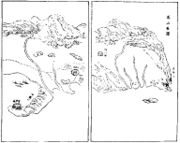
Example of a Chinese printed map in a gazetteer, showing Fengshan County of Taiwan Prefecture, published in 1696; the first known printed map from China comes from a Song Dynasty (960–1279) encyclopedia of the 12th century
|
|
Wooden statues of tomb guardians from the Tang Dynasty (618–907); mechanical-driven wooden statues served as cup-bearers, wine-pourers, and others in this age
|
|
A cross section of a Chinese hall, from the Yingzao Fashi architectural treatise published by Li Jie in 1103, during the Song Dynasty (960–1279); this book explicitly laid out an eight-graded modular system of architecture for timber halls and pavilions of different sizes
|
|
A multistage rocket from the 14th-century military manuscript Huolongjing, Ming Dynasty
|
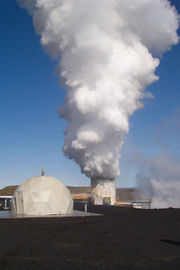
A modern geothermal borehole; the Chinese dug boreholes since the Han Dynasty (202 BC–220 AD) to collect natural gas as fuel for boiling brine in producing salt.
|
|
A naval mine from the Huolongjing, mid-14th century
|

A page from The Nine Chapters on the Mathematical Art, commented on by Liu Hui in 263
|
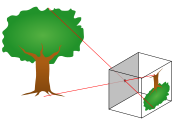
Principle of a pinhole camera; light rays from an object pass through a small hole to form an inverted image.
|
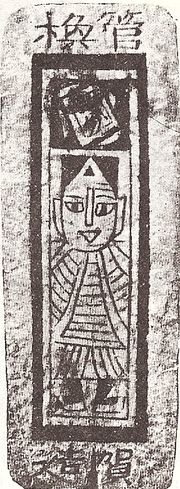
Chinese playing card dated c. 1400 AD, Ming Dynasty
|
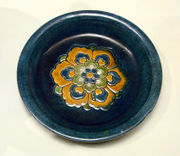
A sancai porcelain dish from the Tang Dynasty, 8th century
|
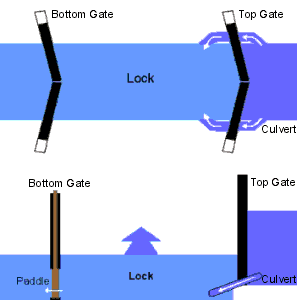
A plan and side view of a canal pound lock, essentially a double-gate canal lock used to regulate water levels in segmented canal chambers for the safe passage of ships, first invented by the 10th century engineer Qiao Weiyo for a section of China's Grand Canal
|
|
Joseph Needham and Robert Temple write that the development of the raised-relief map in China may have been influenced by Han Dynasty (202 BC –220 AD) incense burners and jars such as this, showing artificial mountains as a lid decoration; these were often used to depict the mythical Penglai Island.[383][384]
|
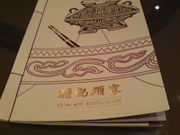
A restaurant menu from Hong Kong; the first menus appeared in China during the Song Dynasty (960–1279).
|
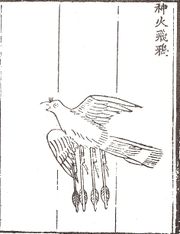
The 'flying crow with magic fire' winged rocket bomb from the Huolongjing, mid 14th century, compiled by Liu Ji and Jiao Yu
|
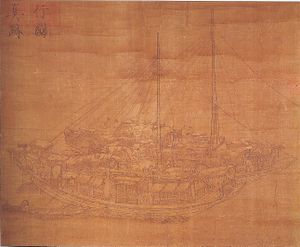
A Song Dynasty painting on silk of two Chinese cargo ships accompanied by a smaller boat; notice the large stern-mounted rudder on the ship shown in the foreground
|
- Land mine: Textual evidence suggests that the first use of a land mine in history was by a Song Dynasty (960–1279) brigadier general known as Lou Qianxia, who used an 'enormous bomb' (huo pao) to kill intruding Mongol soldiers invading Guangxi in 1277.[385] However, the first detailed description of the land mine was given in the Huolongjing text written by Jiao Yu (fl. 14th to early 15th century) and Liu Ji (1311–1375) during the late Yuan Dynasty (1271–1368) and early Ming Dynasty (1368–1644).[386] Jiao and Liu wrote that land mines were spherical, made of cast iron, and their fuses ignited by a mechanism tripped by enemy movement; although Jiao and Liu did not describe this trip mechanism in full detail, a later text of 1606 revealed that enemy movement released a pin that allowed hidden underground weights to fall and spin a chord around an axle that rotated a spinning wheel acting as a flint to spark a train of fuses.[387]
- Leeboard: To avoid leeward drift caused by the force of wind while sailing, the leeboard was invented; it was essentially a board lowered onto the side of the ship opposite to the direction of the wind, helping the ship to stay upright and on course.[388] Paul Johnstone and Sean McGrail state that an odd-looking second paddle on a bronze drum of the Dong Son culture (centered in the Red River Delta of northern Vietnam) may depict a leeboard in use as early as 300 BC.[389] Robert Temple points out that the first written evidence for the leeboard dates to 759 AD, found in the Tang Dynasty (618–907 AD) book Manual of the White and Gloomy Planet of War by Li Quan.[390] Li stated that boards for warships "held the ships, so that even when wind and wave arise in fury, they are neither driven sideways, nor overturn."[390] Leeboards are featured shortly after in 9th century engraved artwork found at the Borobudur monument built during the Sailendra dynasty of Central Java (Indonesia).[389] Leeboards were first used in the West by the Dutch, during the 15th to 16th centuries (possibly used on early Dutch cogs, or perhaps influenced by a Chinese origin).[391][392]
- Liubo: The now defunct board game liubo for the most part remains an enigma for modern scholars still deciphering exactly how it was played; its association with both gambling and divination make it a unique game.[393][394] The earliest two liubo game boards are found in the Zhongshan Tomb 3 at Shijiazhuang, Hebei.[395][396] Similar finds, dating from the mid 4th century BC, are also found in the Chu Tomb 197 and 314 at Jiangling, Hubei.[395][397] Liubo game boards have been found in several Western Han (202 BC–9 AD) tombs; 1 wooden board at Jiangdu in Jiangsu; 1 wooden board in Tomb 8 at Fenghuangshan in Hubei; 1 lacquered set of liubo in Tomb 3 at Mawangdui in Hunan; 1 lacquered board in Tomb 1 at Dafentou in Yunnan; 1 bronze board at Xilin in Guangxi.[398] During the Han Dynasty, an argument over the divination portents of the game as a result of a playing session led to a fight between a Western Han crown prince and Liu Xian (劉賢), where the latter was killed in the scuffle which (in part) prompted his father Liu Pi (劉濞), the King of Wu, to rebel against central Han authority in the Rebellion of the Seven States (154 BC).[393] The historian Michael Loewe asserts that the set pieces of liubo were symbolic of the forces of the Chinese Five Elements, wu xing.[394]
M
- 'Magic mirrors': In about 800 AD, during the Tang Dynasty (618–907), a book entitled Record of Ancient Mirrors described the method of crafting solid bronze mirrors with decorations, written characters, or patterns on the reverse side that could cast these in a reflection on a nearby surface as light struck the front, polished side of the mirror; due to this seemingly transparent effect, they were called 'light-penetration mirrors' by the Chinese.[399] Unfortunately, this Tang era book was lost over the centuries, but magic mirrors were described in the Dream Pool Essays by Shen Kuo (1031–1095), who owned three of them as a family heirloom.[400] Perplexed as to how solid metal could be transparent, Shen guessed that some sort of quenching technique was used to produce tiny wrinkles on the face of the mirror too small to be observed by the eye.[400] Although his explanation of different cooling rates was incorrect, he was right to suggest the surface contained minute variations which the naked eye could not detect; these mirrors also had no transparent quality at all, as discovered by William Bragg in 1932 (after an entire century of them baffling Western scientists).[400] Robert Temple describes their construction: "The basic mirror shape, with the design on the back, was cast flat, and the convexity of the surface produced afterwards by elaborate scraping and scratching. The surface was then polished to become shiny. The stresses set up by these processes caused the thinner parts of the surface to bulge outwards and become more convex than the thicker portions. Finally, a mercury amalgam was laid over the surface; this created further stresses and preferential buckling. The result was that imperfections of the mirror surface matched the patterns on the back, although they were too minute to be seen by the eye. But when the mirror reflected bright sunlight against a wall, with the resultant magnification of the whole image, the effect was to reproduce the patterns as if they were passing through the solid bronze by way of light beams."[400]
- Maglev wind power generators: In 2006, a new type of wind power generator employing magnetic levitation (maglev) was showcased at the Wind Power Asia Exhibition in Beijing.[401][402] Li Guokun was the chief scientific developer of the new maglev wind power generator, in collaboration with the Guangzhou Energy Research Institute under the Chinese Academy of Sciences and the Zhongke Hengyuan Energy Technology Company based in Guangzhou.[401][402] Li Guokun states that traditional wind turbines need high wind speeds to start, due to friction caused by their bearings.[401][402] The new frictionless maglev wind generator requires wind speeds of only 1.5 m per second (or 5 km an hour) to start and are expected to cut operational costs for wind farms by half, i.e. overall cost of roughly 0.4 Chinese yuan per kilowatt hour.[401][402]
- Mahjong: Jelte Rep writes that the gambling game of mahjong (Traditional Chinese: 麻將; Pinyin: májiàng), which employs a set of over a hundred tiles, was first invented in 1846 by Zhen Yumen, a Qing Dynasty (1644–1912) diplomatic official from Ningbo.[403] However, Rep traces the origins of the game to a card game of the Tang Dynasty (618–907) which used thirty-two wood or ivory pieces in the shape of cards.[404] This evolved into the forty-card game of madiao (馬吊) during the Ming Dynasty (1368–1644), which had four suits of cards instead of the three found in modern mahjong.[404]
- Manned flight with kites: Although Ge Hong (284–364 AD) made a hint in his writing about manned flights using kites, the first solid proof dates to the Northern Qi (550–577) era.[405] An ancient Chinese tradition of piety called 'the liberation of living creatures', where fish and birds were released after capture, was corrupted by the notoriously cruel Emperor Wenxuan of Northern Qi (r. 550–559). While executing the entire Tuoba family which had ruled the previous dynasty of Eastern Wei (534–550), Emperor Wenxuan used the concept of 'the liberation of living creatures' when he launched Tuoba family members from the top of the 30 m (100 ft) tall Golden Phoenix Tower (near Ye, China) as test pilots for his manned flying kites.[405] According to the account, Emperor Wenxuan first had the prisoners "harnessed with great bamboo mats as wings, and ordered them to fly to the ground from the top of the tower;" all of these men died.[406] However, Wenxuan wanted a greater spectacle, and by the last year of his reign had the prisoners harnessed into large kites shaped as owls; the former Eastern Wei prince Yuan Huangtou (died 559) reportedly flew about 3.2 km (2 mi) before landing, yet was captured and handed over to Bi Yiyun, head official of the censorate, who shortly after had him executed.[407] Records of this account were preserved in the historical work Zizhi Tongjian compiled by Chancellor Sima Guang (1019–1086) in 1084.[407] The later traveler Marco Polo (1254–1324) remarked that the crews of Chinese merchant ships always had a fool or drunkard who would be a candidate for being placed into a "hurdle" made of willow stems which was flown in the air by eight cords and used as a means of fortune-telling for commercial prospects.[408]
- Match, non-friction: The earliest type of match for lighting fire was made in China by 577 AD, invented by Northern Qi (550–577) court ladies as they desperately looked for materials to light fires for cooking and heating as enemy troops of Northern Zhou (557–581) and the Chen Dynasty (557–589) besieged their city from outside.[409] Early matches in China were designed to be lit by an existing flame and carried to light another fire. They were pinewood sticks impregnated with sulfur and needed only a slight touch from a flame to light.[409] This was written in the Records of the Unwordly and Strange by Tao Gu in 950 (Five Dynasties and Ten Kingdoms Period), who also wrote that they were once called "light-bringing slaves" before they were commercially marketed as the 'fire inch-stick'.[409] The self-striking, friction match was not made until 1827, an invention of John Walker.
- Mechanical theater: The inventors of the field mill mentioned above, Xie Fei and Wei Mengbian of the Later Zhao (319–351 AD), also invented an intricate mechanical theater mounted on a carriage, its figures operated by motive power (i.e. simply advancing the carriage forward).[410] From 335 to 345 AD, they worked at the court of the ethnic-Jie emperor Shi Hu (334–349).[410] The vehicle they crafted was a four-wheeled and 6 m (20 ft) long carriage that was about 3 m (10 ft) wide.[410] On it rested a large golden Buddha statue with a Daoist statue continually rubbing his front with his mechanical hand.[410] The Buddha was also surrounded by ten wooden Daoists who rotated around him in a circuit, periodically bowing to him, saluting him, and throwing incense into a censer.[410] Above the Buddha were nine dragon-headed faucets which spouted water.[410] Like the field mill and the pounding cart of these two inventors, when the carriage halted, so did all of its moving components of mechanical statues and spouting faucets.[411]
- Mechanical cup-bearers and wine-pourers on automatic-traveling boats: The mechanical engineer Huang Gun served the court of Emperor Yang of Sui (r. 604–617) and wrote the book Shuishi Tujing on his inventions, which his colleague Du Bao enlarged and commented on.[412] He constructed seven small boats, called 'wine boats', that were as large as 3 m (10 ft) long and 1.8 m (6 ft) wide which supported a number of mechanical figures of wooden statues called 'hydraulic elegances', each about 0.6 m (2 ft) tall, some of them animals but most in human form consisting of singing girls, musicians playing actual instruments, dancers and tumblers, oarsmen busy rowing, cup-bearers, and wine-pourers all moving simultaneously as if alive.[412] These boats were set to travel at timed intervals along circuits made of winding stone channels and canals in palace courtyards and gardens (designed by Tang Haogui), where guests would gather for special occasions.[412] The cup-bearer stood at the bow of each ship and beside him the wine-pourer; when the ship made automatically-timed periodic stops where guests were seated, the cup-bearer automatically stretched out his arm with a full cup of wine.[412] When the guest was done emptying his cup, he placed the cup back into the figure's hands; the latter then waited as the wine-pourer filled a second cup to be emptied.[412] When this guest had been served, the wine boat automatically moved onwards to the next stop.[412] Joseph Needham speculates that the 'wine boats' may have been paddle-wheel-driven;[413] as Robert Temple notes, the paddle wheel ship was already known in China since the Liu Song Dynasty (420–479).[414] Aside from the partial remains of the Shuishi Tujing, an account of these 'wine boats' was also preserved by Huang Gun's contemporary Yan Shigu (581–645).[415]
- Modular system of architecture, eight standard grades: Although other texts preceded it, such as the 'National Building Law' of the Tang Dynasty (618–907) which was partially preserved in other texts, the Yingzao Fashi published in 1103 by the Song Dynasty (960–1279) scholar-official Li Jie (1065–1110) is the oldest known Chinese architectural treatise that has survived fully intact.[416] It contains descriptions and illustrations detailing the cai fen system (材份制) of eight standard dimensions for module components of timber architecture and structural carpentry.[417] The eight standard grades of module timber components in the Yingzao Fashi, with grade I being the largest and grade VIII the smallest, were used to determine the ultimate proportions and scale of a building as a whole, as all timber hall types—palaces, mansions, ordinary houses, and pavilions—were hierarchically categorized along the lines of which cai fen grade was employed.[418] For example, palace type buildings used only grades I through V, while mansion type buildings never used components larger than grade III and no less than grade VI.[419] In this system of structural carpentry, the smallest grade of VIII is represented by one cai; one cai is equal to the modern equivalent of 15 cm (5.9 in), while one cai is also divided into fifteen fen (hence the title of this modular system).[420]
- Multiple-tube seed drill: The wooden seed drill existed in China by the 3rd century BC, while the multiple-tube iron seed drill was first invented in China by the 2nd century BC, during the Han Dynasty (202 BC–220 AD).[421][422] The seed drill allowed for greater speed and regulation of distributing seeds in lined rows of crops instead of casting them out onto the farm field.[421]
- Multistage rocket: Although there is still some ambiguity as to whether the earliest rockets of the 13th century were first developed in Europe (i.e. 'ignis volantis in aere' in the work of Marcus Graecus around 1232, although Needham and Davis assert it was most likely a fire lance), the Middle East (i.e. 'sahm al-Khitāi' or 'arrows of China' as referred to by Hasan al-Rhammāh in 1280) or China (i.e. 'di lao shu' or 'ground rat' mentioned in 1264 or the 'chong' mortar used by the armies of the Song Dynasty and invading Mongols during the 1270s), during the Yuan Dynasty (1271–1368) the term 'fire arrow' once implied to mean incendiary arrows during the Tang Dynasty was then used to describe the true rocket, producing a headache, as Needham says, for historians;[32][308][423] the Huolongjing written by Jiao Yu (fl. 14th to early 15th century) and Liu Ji (1311–1375) during the early Ming Dynasty (1368–1644) described several types of rockets,[424] one of them being a multistage rocket known as the 'huo long chu shui' or 'fire dragon issuing from the water' which, despite its name, was not launched from beneath the water from a primitive submarine but rather at near water-level maintaining a flat trajectory; defined as a two-stage rocket, it employed booster rockets that, when about to burn out of use, ignited a swarm of smaller rocket arrows fired from the front end of the missile shaped as a dragon's mouth.[425][426]
N
- Natural gas as fuel: Robert Temple asserts that the 4th century BC (Warring States Period) is a conservative estimate for the time in which the Chinese began using natural gas as fuel and light.[163] He states that systematic borehole drilling for brine extraction by the 1st century BC (Han Dynasty) led to the discovery of many "fire wells" in Sichuan which yielded natural gas.[163] As recorded in the 2nd century AD, this led to a systematic search for natural gas.[163] Both brine and natural gas were piped through bamboo tubes; from small boreholes the gas could be piped directly to burners where the brine was emptied into cast iron evaporation pans for boiling and producing salt, but the pungent gas piped from depths of some 2,000 ft (610 m) had to be first mixed with air lest an explosion occur.[322] To remedy this, the Chinese piped the gas first into a large wooden, cone-shaped chamber placed 3 m (10 ft) below ground level where another pipe could convey air, thus turning the chamber into a large carburetor.[322] To avoid fires from a sudden surplus of gas, an additional "sky thrusting pipe" was used as an exhaust system.[427]
- Naval mine: The Huolongjing military manuscript written by Jiao Yu (fl. 14th to early 15th century) and Liu Ji (1311–1375) also describes naval mines used at sea or on rivers and lakes; made of wrought iron and enclosed in an ox bladder, it was a timed device in that a burning joss stick floating above the mine determined when the fuse was to be ignited; the text explicitly mentions that without air and doused in water the fuse would not burn, so the fuse was protected by a long waterproof tube made out of goat's intestine; a later model shown in Song Yingxing's (1587–1666) encyclopedia of 1637 shows the ox bladder replaced with a lacquered leather bag while the mine is ignited by a rip cord pulled from the shore to rotate a flint-and-steel firing mechanism.[428]
- Negative numbers, symbols for and use of: In the Nine Chapters on the Mathematical Art compiled during the Han Dynasty (202 BC–220 AD) by 179 AD and commented on by Liu Hui (fl. 3rd century) in 263,[429] negative numbers appear as black rods and positive numbers as red rods in the Chinese counting rods system.[430] Liu Hui also used slanted counting rods to denote negative numbers.[430] Negative numbers denoted by a "+" sign also appear in the ancient Bakhshali manuscript of India, yet scholars disagree as to when it was compiled, giving a collective range of 200 to 600 AD.[431] Negative numbers were known in India certainly by about 630 AD, when the mathematician Brahmagupta (598–668) used them.[430] Negative numbers were first used in Europe by the Greek mathematician Diophantus (fl. 3rd century) in about 275 AD, yet were considered absurd in the West until The Great Art written in 1545 by the Italian mathematician Girolamo Cardano (1501–1576).[430]
O
- Open-spandrel segmental arch bridge, fully stone: The earliest known fully-stone open-spandrel segmental arch bridge is the Zhaozhou Bridge in southern Hebei province, China, completed in 605 by the Sui Dynasty (581–618) engineer Li Chun.[432][433][434] The bridge span is 37.5 m (123 ft) and the structure relatively light in weight due to the four semi-circular arch spandrels which allow for additional flood waters to pass through.[434] Other Chinese bridges would be influenced by this design, such as the open-spandrel Yongtong Bridge of Zhaoxian, Hebei built in 1130,[435] and the simple segmental arch Lugou Bridge built in 1698 (originally in 1189).[436] The latter, located just west of Beijing, features eleven segmental arches, each with a span of 18.8 m (62 ft) in a total bridge span of 213 m (700 ft).[437]
P
- Pinhole camera: The Greek philosopher Aristotle (384–322 BC) observed that the spaces between the leaves of trees acted as tiny pinholes which cast the image of a partial solar eclipse onto the ground.[438] He also used a metal plate with a small pinhole to project an image of a solar eclipse onto the ground.[438] The ancient Chinese philosopher Mozi (c. 470 BC–c. 391 BC)—founder of Mohism during the establishment of the Hundred Schools of Thought—lived just before the time of Aristotle and it was in his Mojing (perhaps compiled by his disciples) that a pinhole camera was described.[439] The Mojing stated that the "collecting place" (pinhole) was an empty hole "like the sun and moon depicted on the imperial flags," where an image could be inverted at an intersecting point which "affects the size of the image."[439] The Mojing seems to be in line with the Epicurean theory of light traveling into the eye (and not vice versa like in Pythagoreanism),[440] since the Mojing states that the reflected light shining forth from an "illuminated person" becomes inverted when passing through the pinhole, i.e. "The bottom part of the man becomes the top part (of the image) and the top part of the man becomes the bottom part (of the image)."[439] In his Book of Optics (1021), Ibn al-Haytham (965–1039) wrote of his experimentation with camera obscura, which was followed by Shen Kuo (1031–1095), the latter who alluded that the Tang Dynasty (618–907) author Duan Chengshi (died 863)—in his Miscellaneous Morsels from Youyang—described inverted images of Chinese pagodas.[441]
- Playing cards: The first reference to the card game in world history dates no later than the 9th century, when the Collection of Miscellanea at Duyang, written by Su E (fl. 880), described the Wei clan (family of Princess Tongchang's husband) of the Tang Dynasty (618–907 AD) enjoying the "leaf game" in 868.[442][443][444] The Yezi Gexi was a book on the card came which was allegedly written by a Tang woman and commented on by Chinese scholars in subsequent dynasties.[445][446] In his Notes After Retirement, the Song Dynasty (960–1279) scholar Ouyang Xiu (1007–1072) asserted that playing card games existed since the mid Tang Dynasty and associated this invention with the simultaneous evolution of the common Chinese writing medium from paper rolls to sheets of paper that could be printed.[443][445][446] During the Ming Dynasty (1368–1644), characters from popular novels such as the Water Margin were widely featured on the faces of playing cards.[445][446] By the 11th century playing cards could be found throughout the Asian continent.[447] Playing cards were some of the first printed materials in Europe, appearing by the 14th century (i.e. in Spain and Germany in 1377, in Italy and Belgium in 1379, and in France in 1381) and produced by European woodblock printing before the innovation of the printing press by Johannes Gutenberg (c. 1400–1468).[447][448]
- Porcelain: Although glazed ceramics existed beforehand, S.A.M. Adshead writes that the earliest type of vitrified, translucent ceramics that could be classified as true porcelain was not made until the Tang Dynasty (618–907).[449] Nigel Wood states that true porcelain was manufactured in North China from roughly the beginning of the Tang Dynasty in the 7th century, while true porcelain was not manufactured in South China until about 300 years later, during the early 10th century.[450]
- Pound lock: Indirect evidence suggests that pound locks may have been used in antiquity by the Ptolemaic Greeks and the Romans.[451] In China, although the one gate canal flash lock existed beforehand, the two-gate pound lock was invented in 984 by an official of Huainan and engineer named Qiao Weiyo, during the early Song Dynasty (960–1279), so that ships could safely travel along canal waterways having gated and segmented chambers where water levels could be regulated.[452][453][454] The economic and transport benefits of this innovation were described by the polymath official and inventor Shen Kuo (1031–1095) in his Dream Pool Essays.[452][455]
- Puppet theater, waterwheel-powered: The mechanical toys of Roman Egypt, especially the weight-driven puppet theater of Heron of Alexandria (c. 10–70 AD), are well known and discussed by historians such as Beck, Prou, and de Rochas d'Aiglun.[456] In China, Zhang Heng (78–139) wrote of plays with artificial fish and dragons, while a 6th century text Xijing Zaji states that when Liu Bang (reigned as Emperor Gaozu of Han from 202–195 BC) came upon the treasury of the deceased Qin Shihuang (r. 221–210) in 206 BC, he found an entire mechanical orchestra of 1 m (3 ft) tall puppets dressed in silk and playing mouth organs, all powered by pulling ropes and blowing into tubes.[457] As written in the Records of the Three Kingdoms, the engineer Ma Jun (fl. 220–265)—already associated with the differential gear system of the South Pointing Chariot—invented a mechanical theater powered by a rotating wooden waterwheel for the entertainment of Emperor Ming's (r. 226–239 AD) court.[457] With the waterwheel in motion, a number of mechanical puppets performed tricks, such as singing girls who played music and danced, other puppets who would beat drums and sound flutes when one puppet entered the scene, puppets dancing on balls, throwing swords, hanging upside down on rope ladders, etc.[457] Other mechanical puppets dressed as government officials did tasks in their offices, puppets dressed as laborers did jobs of pounding and grinding (trip hammer and millstone), while others watched cockfighting, all moving simultaneously.[457] Water-powered puppet theaters in the tradition of Ma Jun were created in later dynasties as well.[458]
Q
R
- Raised-relief map: In his 1665 paper for the Philosophical Transactions of the Royal Society, John Evelyn (1620–1706) believed that wax models imitating nature and bas relief maps were something entirely new from France.[459] Some later scholars attributed the first raised-relief map to one Paul Dox, who represented the area of Kufstein in his raised-relief map of 1510.[459][460] The 20th century historian G. Sarton pointed to the writing of Ibn Battuta (1304–1368 or 1377), the latter who witnessed a raised-relief map while on Gibraltar in the 14th century.[459][460] However, the raised-relief map may have existed in China since the 3rd century BC, if the accounts in the Records of the Grand Historian (by Sima Qian, 91 BC) about Qin Shi Huang's (r. 221–210 BC) tomb prove correct (when it is excavated).[384] It is known that Ma Yuan (14 BC–49 AD) created a raised-relief map in 32 AD made out of rice, a type of map described in detail during the Tang Dynasty (618–907) by Jiang Fang in his Essay on the Art of Constructing Mountains with Rice (c. 845).[384] Xie Zhuang (421–466) of the Liu Song Dynasty (420–479) created a 0.93 m2 (10 ft2) wooden raised-relief map of the empire (showing mountains and rivers) which could be taken apart and pieced together like a giant jigsaw puzzle.[384] While on a court assignment of inspection along the Song Empire's (960–1279) frontier, the polymath scholar and official Shen Kuo (1031–1095) created a three-dimensional, raised-relief map depicting miniature roads, rivers, mountains and passes composed of wood, glue-soaked sawdust, beeswax, and wheat paste.[461][462][463][464] His wooden model pleased Emperor Shenzong of Song (r. 1067–1085), who later ordered that all the prefects administering the frontier regions should prepare similar wooden maps which could be sent to the capital and stored in an archive.[463] In 1130, Huang Shang made a wooden raised-relief map which later caught the attention of the Neo-Confucian philosopher Zhu Xi (1130–1200), who tried to acquire it but instead made his own map out of sticky clay and wood.[463][464] The map, made of eight pieces of wood connected by hinges, could be folded up and carried around by one person.[463]
- Restaurant menu: During the early Song Dynasty (960–1279), urban shopkeepers of the merchant middle class often had little time to eat at home, so they ventured out to eat at a variety of places such as temples, taverns, tea houses, food stalls, and restaurants which provided business for nearby brothels, singing-girl houses, and drama theatres; this along with traveling foreigners and Chinese who migrated to urban centers from regions with different cooking styles encouraged a demand for a variety of flavors served at urban restaurants, giving rise to the menu.[465][466]
- Rocket bombs, aerodynamic wings and explosive payloads: The first known rockets fitted with aerodynamic wings are described as the 'flying crows with magic fire' in the oldest strata of the Huolongjing (early-to-mid 14th century), compiled by Jiao Yu and Liu Ji during the early Ming Dynasty (1368–1644).[467] The body of the rocket was shaped like a bird (specifically a crow), packed with gunpowder, and made of bamboo laths forming a long basketwork frame that was reinforced with glued paper.[468] A decorative head and tail were attached to the front and back ends, while the wings were nailed to the sides.[468] Under each wing were two slanting rockets to propel the weapon; a main fuse was lit that ignited a fourfold fuse connected to each rocket and running through a drilled hole in the back of the bird.[468] The book then claims that the rocket, after being launched high into the air and aimed at encampments or enemy boats, automatically produced an explosion upon impact that could be seen from considerably long distances.[469] The Wubeizhi, published in 1621, described a weapon called the 'free-flying enemy-pounding thunder-crash bomb', which was another winged rocket secured with oily paper and had a tubed rocket built into the rear of the bomb.[469] When the composition of the rocket was burnt out in flight, the rocket automatically ignited and released a poisonous blast of smoke and caltrops with poisoned tips.[469]
- Rotary fan, manual and water-powered: For purposes of air conditioning, the Han Dynasty (202 BC–220 AD) craftsman and engineer Ding Huan (fl. 180 AD) invented a manually-operated rotary fan having seven wheels that measured 3 m (10 ft) in diameter; in the 8th century, during the Tang Dynasty (618–907), the Chinese applied hydraulic power to rotate the fan wheels for air conditioning, while the rotary fan became even more common during the Song Dynasty (960–1279).[470][471] The first rotary fan used in Europe was for mine ventilation during the 16th century, as illustrated by Georg Agricola (1494–1555).[472]
- Rudder, stern-mounted and vertical axial: Lawrence V. Mott, who defines a steering oar as a rudder, states the ancient Egyptian use of stern-mounted rudders can be traced back to the 6th dynasty (2350-2200 BC).[473] Mott states that the method of attachment for rudders in the Arab, Chinese, and European worlds differed from each other, leading him to doubt the spread of the Chinese system of attachment by socket-and-jaws or block and tackle (versus European pintle-and-gudgeon invented by c. 1180 AD).[473][474] In regards to Mott's definition of a steering oar as a rudder, Joseph Needham, Richard Lefebvre des Noëttes, K.S. Tom, Chung Chee Kit, S.A.M. Adshead, Paul Johnstone and Sean McGrail state that a steering oar is not a rudder; the steering oar has the capacity to interfere with handling of the sails (limiting any potential for long ocean-going voyages) while it was fit more for small vessels on narrow, rapid-water transport; the rudder did not disturb the handling of the sails, took less energy to operate by its helmsman, was better fit for larger vessels on ocean-going travel, and first appeared in China.[181][474][475][476][477] Leo Block writes of the use of the steering oar in the ancient Mediterranean world (specifically in regards to the Phoenicians, 1550–300 BC): "A single sail tends to turn a vessel in an upwind or downwind direction, and rudder action is required to steer a straight course. A steering oar was used at this time because the rudder had not yet been invented. With a single sail, a frequent movement of the steering oar was required to steer a straight course; this slowed down the vessel because a steering oar (or rudder) course correction acts like a break."[478] The oldest depicted rudders at the back of a ship, without the use of oars or a steering oar, comes from several ceramic models of Chinese ships made during both the Western and Eastern eras of the Han Dynasty (202 BC–220 AD).[181][479][480][481] According to the scholars Zhang Zunyan and Vassilios Christides, there is literary evidence to suggest that the axial stern rudder existed in China since the 1st century BC,[482] while Gang Deng asserts the first reference was made in the Huainanzi of the 2nd century BC,[481] and K.S. Tom says the first clear reference dates to the 5th century AD.[181] However, K.S. Tom points to the fact that all Chinese pottery models of ships before this Guangzhou tomb model show steering oars instead of a rudder, which he states is strong evidence for the rudder's invention only by the 1st century AD.[483] Jacques Gernet states that while the Chinese had invented the rudder in the 1st century AD, it was not completely fixed to the sternpost of Chinese ships until the end of the 4th century.[484] The bulkhead ship design of the junk, which appeared roughly the same time as the rudder, provided the essential vertical components for the hinged axial rudder.[379] Deng points out that an Eastern Han (25–220) model distinctly shows a rudder located in its own separate cabin, suggesting that helmsmanship had already become an established profession.[481] Following the invention of the balanced rudder pivoted on an axis, Tom and Deng state that the Chinese then innovated the fenestrated rudder by the Song Dynasty (960–1279), with deliberate puncturing and boring out of holes in shapes such as diamonds, which, according to Tom, made the rudder "easier to steer, reduced turbulence drag, did not affect efficiency and was hydrodynamically sound."[481][485]
S
|
A replica of Zhang Heng's (78–139 AD) seismometer that employed a pendulum sensitive to inertia of ground tremors; while placed in Luoyang in 133, it detected an earthquake 400 to 500 km (250 to 310 mi) away in Gansu
|
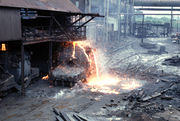
Molten steel; the Chinese produced steel from cast iron in a process of decarburization since the 2nd century BC
|

The Luding Bridge in Sichuan, an iron-chain suspension bridge
|
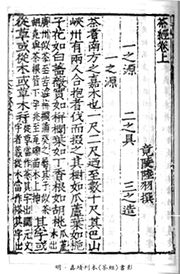
A page of The Classic of Tea by the Tang connoisseur of tea, Lu Yu (733–804)
|
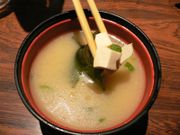
Tofu in miso soup; the Chinese invented tofu as early as the 2nd century BC during the Han Dynasty (202 BC–220 AD) if the traditional accounts about Liu An are correct.
|
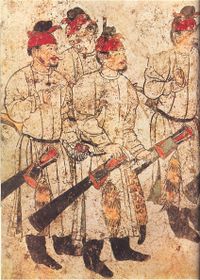
A wall mural of Li Xian's tomb at Qianling Mausoleum (dated 706 AD), where the tomb murals and structural designs corresponded with the appearances and layouts, respectively, of actual residences where the tomb occupants had once lived during the Tang Dynasty
|
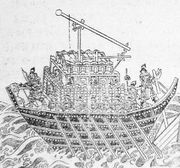
A Chinese Song Dynasty naval river ship with a Xuanfeng traction trebuchet catapult, taken from the Wujing Zongyao, 1044 AD
|
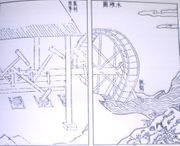
Hydraulic-powered trip hammers, from a Ming Dynasty encyclopedia published in 1637 by Song Yingxing (1587–1666)
|

An ornate bronze bell belonging to Duke Mu of Qin (d. 621 BC) from the Spring and Autumn Period (722–481 BC)
|
- Seismometer: The official, astronomer, and mathematician Zhang Heng (78–139) of the Han Dynasty (202 BC–220 AD) invented the first seismometer in 132, a large metal urn-shaped instrument which employed either a suspended pendulum or inverted pendulum acting on inertia (i.e. ground tremors from earthquakes) to dislodge a metal ball by a lever trip device; this ball would fall out of dragon-shaped metal mouth into the corresponding metal toad mouth indicating the exact cardinal direction of where a distant earthquake had occurred in order for the state to send swift aid and relief to the affected regions; several subsequent recreations of his device were employed by Chinese states up until the Tang Dynasty (618–907), when use of the device fell into obscurity, a fact noted even by the writer Zhou Mi around 1290, during the Yuan Dynasty (1271–1368).[485][486][487][488][489][490][491][492]
- South Pointing Chariot: Although the claim of Wei Dynasty statesman Ma Jun (fl. 220–265) that the South Pointing Chariot was first invented by the mythological Yellow Emperor are dubious, his South Pointing Chariot was successfully designed and tested in 255 AD with many later models recreated in subsequent dynasties; this device was a wheeled vehicle with differential gears that ensured a mounted wooden figurine would always point in the southern direction no matter how the vehicle turned, in essence a non-magnetic compass.[493][494][495] The Book of Song written in the 6th century states that the device was successfully reinvented by the mathematician and astronmer Zu Chongzhi (429–500) during the Liu Song Dynasty (420–479).[496] The Japanese historical text Nihon Shoki, compiled by 720, states that the device was crafted and presented as a gift to Emperor Tenji (661–672) on two different occasions (658 and 666) by the Tang Dynasty (618–907) Chinese Buddhist monks Zhi Yu and Zhi You.[497] The wheeled vehicle device was described in intricate detail in the historical text covering the Song Dynasty (960–1279), i.e. the Song Shi (compiled 1345); for example, it revealed the number of gear teeth on each mechanical gear wheel, the diameter of each gear wheel, and how these gear wheels were properly positioned.[498]
- Steel made from cast iron through oxygenation: The earliest known production of steel is a piece of ironware excavated from an archaeological site in Anatolia (Kaman-Kalehoyuk ) and is about 4,000 years old.[499] Other ancient steel comes from East Africa, dating back to 1400 BC.[500] In the 4th century BC steel weapons like the Falcata were produced in the Iberian Peninsula, while Noric steel was used by the Roman military.[501] The Chinese, who had been producing cast iron from the late Spring and Autumn Period (722–481 BC), produced steel by the 2nd century BC through a process of decarburization, i.e. using bellows to pump large amounts of oxygen on to molten cast iron.[502] This was first described in the Han Dynasty (202 BC–220 AD) book Huainanzi, compiled by scholars under Prince Liu An (179–122 BC).[503] The Chinese called this technique "the hundred refinings method," since the process was repeated over and over to incrementally strengthen the steel.[503] The back of swords were often made of more elastic wrought iron while the cutting edge of the blade itself was made of strong steel.[503] For steel, they used both quenching (i.e. rapid cooling) and tempering (i.e. slow cooling) methods of heat treatment.[503] Much later, the American inventor William Kelly (1811–1888) brought four Chinese metallurgists to Eddyville, Kentucky in 1845, whose expertise in steelmaking influenced his ideas about air injection to reduce carbon content of iron; his invention anticipated the Bessemer process of Henry Bessemer (1813–1898).[504]
- Stirrup: There are authors who point out that it is unclear whether the stirrup was invented by northern nomads or the sedentary Chinese.[505] Liu Han (1961) credited the invention of the stirrup to nomadic invaders of northern China.[506] Archaeologial evidence shows that horse riders in India had a small loop for a single toe to be inserted by roughly the 1st century AD.[507] However, the first true depiction of the stirrup is featured on a Jin Dynasty (265–420) Chinese tomb figurine dated 302 AD, yet this was a single stirrup and was perhaps used only for initially mounting the horse.[508] It should be noted that the latter was found in Changsha, Hunan, far from the northern border.[509] The first validated depiction of a rider with a pair of saddle stirrups for both feet comes from a Jin Chinese tomb figurine dated 322.[508] The first actual specimens of stirrups comes from a Chinese tomb in southern Manchuria that is dated 415.[508] The stirrup was not widely used by Chinese cavalry until the 5th century.[507][510] By the 6th century, the use of the stirrup had spread as far west as the Byzantine Empire, where both the stirrup and Celtic horseshoe were adopted.[507]
- Suspension bridge using iron chains: Although there is evidence that many early cultures employed the use of suspension bridges with cabled ropes, the first written evidence of iron chain suspension bridges comes from a local history and topography of Yunnan written in the 15th century, which describes the repair of an iron chain bridge during the reign of the Yongle Emperor (r. 1402–1424); although it is questionable if Ming Dynasty (1368–1644) Chinese claims that iron chain suspension bridges existed since the Han Dynasty, their existence in the 15th century predates that of anywhere else.[511] K.S. Tom mentions this same repaired Ming suspension bridge described by Needham, but adds that recent research has revealed a document which lists the names of those who allegedly built an iron chain suspension bridge in Yunnan around the year 600 AD.[512]
T
- Tea: The tea plant is indigenous to western Yunnan;[513] by the mid 2nd millennium BC, tea was being consumed in Yunnan for medicinal purposes.[514] It was introduced from Sichuan to the population of northern China and middle and lower Yangtze River around the 2nd century BC. Tea drinking was already an established custom in the daily life in this area as shown by the Contract with a Slave, written by Wang Bao in 59 BC.[515] This written record also reveals that tea, used as a drink instead of a medicinal herb, emerged no later than the 1st century BC.[516] Early Chinese tea culture began from the time of Han Dynasty (202 BC–220 AD) to the Southern and Northern Dynasties (420–589) when tea was widely used by Chinese gentry, but only took its initial shape during the Tang Dynasty (618–907).[517] Utensil like handle-less tea bowl which first appeared in the Eastern Jin Dynasty (317–420), became popular among the tea drinkers of Tang.[518] The first book about tea was written by Lu Yu (733–804) in his The Classic of Tea.[519]
- Thyroid hormones to treat goiters: In 239 BC, Master Lu's Spring and Autumn Annals stated that where water is too light, people suffer widespread baldness and goiter.[520] It was not until the 1860 that Gaspard Adolphe Chatin (1813–1901) linked goiter with the lack of iodine in soil and water; iodine was discovered in the thyroid gland in 1896 by Eugen Baumann, while thyroid extract was used to treat patients in 1890.[520] Long before this the Tang Dynasty (618–907) physician Zhen Quan (d. 643 AD), in his Old and New Tried and Tested Prescriptions, stated that the thyroid glands taken from gelded rams were used to treat patients with goiter; the thyroid hormones could be swallowed in pill form (the body of the pill made from crushed jujube pulp) or as a solid thyroid gland with the fat taken off.[521] Another prescription by Wang Xi used air-dried glands ground into powder and taken with wine.[522] Zhen's contemporary Cui Zhiti (fl. 650 AD) distinguished in his written work between a tumor, which he described as an incurbale solid neck swelling, and a real goiter, which he described as curable and movable in the neck.[522] The Chinese also used the thyroid glands of pigs, water buffalo, and sika deer with success in treating goiter.[522] The Pharmacopoeia of the Heavenly Husbandman asserted that iodine-rich sargassum was used to treat goiter by the 1st century BC (Ge Hong, 284–364, also suggested using a tincture derived from sargassum seaweed in about 340 AD),[523] a treatment unknown in the West until Roger of Palermo wrote his Practica Chirurgiae in 1180 AD.[524]
- Tofu: Although both popular tradition and Song-dynasty (960–1279 AD) scholars like Zhu Xi (1130–1200 AD) credit the invention of tofu—along with soymilk— to Liu An (179–122 BC), a Han-Dynasty King of Huainan, no mention of tofu is found in the extant Huainanzi (compiled under Liu An).[525][526][527] Attempts to show on the basis of tomb reliefs and excavated objects that tofu already existed in the Han Dynasty are still not entirely convincing.[528] The earliest known mention of tofu was made in Records of the Extraordinary (Qingyi lu 清異錄), which reported that tofu was sold at Qingyang (Anhui).[529] Sun Ji (1998) argues that although this book is attributed to Tao Gu (陶穀, 903–970 AD), it was probably compiled by someone else early in the northern Song dynasty.[530] The earliest explanation of how to make tofu is found in the Bencao Gangmu, written by Li Shizhen (1518–1593).[527] According to Shurtleff and Aoyagi (2001), modern historians suppose that Liu An's tofu, like modern tofu, was made to coagulate with either seawater or nigari, the latter of which is called lushui (卤水) in Chinese.[525] According to Liu Keshun (1999), Liu An's process for making tofu was essentially the same as today: "Basically, soybeans are washed, soaked, and ground with water. The slurry is then filtered to make raw soymilk. The milk is heated before a coagulant is added to form a curd. The curd is finally pressed to separate whey from tofu."[531]
- Toilet paper: Toilet paper was first mentioned by the official Yan Zhitui (531–591) in the year 589 during the Sui Dynasty (581–618), with full evidence of continual use in subsequent dynasties.[532][533] In the year 851 during the Tang Dynasty (618–907), a Muslim Arab traveler from the Middle East commented that the Chinese used paper instead of water to clean themselves while going to the bathroom.[532] By the mid 14th century during the Yuan Dynasty (1271–1368), it was written that ten million packages of 1,000 to 10,000 sheets of toilet paper were manufactured annually in Zhejiang province alone.[532] It is also written that emperors of the Ming Dynasty (1368–1644) used perfumed toilet paper.[532]
- Toothbrush: See Bristle toothbrush (above)
- Traction trebuchet catapult: The earliest type of trebuchet catapult was the traction trebuchet, developed first in China by the 5th or 4th century BC, the beginning of the Warring States Period (403–221 BC); to operate the trebuchet, a team of men pulled on ropes attached to the butt of the shorter segment of a long wooden beam separated by a rotating axle fixed to a base framework, allowing the longer segment of the beam to lunge forward and use its sling to hurl a missile; by the 9th century a hybrid of the traction and counterweight trebuchet, employing manpower and a pivoting weight, was used in the Middle East, Mediterranean Basin, and Northern Europe; by the 12th century, the full fledged counterweight trebuchet was developed under the Ayyubid dynasty of Islamic Syria and Egypt (described by Mardi bin Ali al-Tarsusi) and used in the Third Crusade; by the 13th century, the counterweight trebuchet found its way into Song Dynasty (960–1279) China via the Mongol invaders under Kublai Khan (r. 1260–1294) who used it in the Siege of Xiangyang (1267–1273).[534][535][536]
- Trip hammer: The ancient Chinese used pestle and mortar to pound and decorticate grain, which was superseded by the treadle-operated tilt hammer (employing a simple lever and fulcrum) perhaps during the Zhou Dynasty (1122–256 BC) but first described in a Han Dynasty (202 BC–220 AD) dictionary of 40 BC and soon after by Yang Xiong (53 BC–18 AD) in his Fangyan dictionary written in 15 BC; the next stage in this evolution of grain-pounding devices was to apply hydraulic power, which the author Huan Tan (43 BC–28 AD) mentioned in his Xinlun of 20 AD, although he also described trip hammers powered by the labor of horses, oxen, donkeys, and mules.[537] After Huan Tan's book was written, numerous references to trip hammers powered by waterwheels were made in subsequent Chinese dynasties and in Medieval Europe by the 12th century.[538] However, trip hammers were also attested by both literary (Pliny, Natural History 18.97) and archaeological evidence in fairly widespread use in the Roman Empire by the 1st century AD.[539][540]
- Tuned bells: The earliest complete set of tuned bells, sixteen in all, were found in Tomb 8 of Marquis Su of Jin at Qucun, southern Shanxi.[541] A 355-character inscription on all sixteen bells collectively describes Marquis Su's participation in a military campaign led by the Zhou king.[542][543] The tomb has been dated by AMS radiocarbon techniques to 815–786 BC.[544] Tuned bells which could produce two precise musical pitches (if struck at the center or struck on one side near the edge) existed in China during the Zhou Dynasty (c. 1050–256 BC).[545] Of the sixty-four bronze bells found in the tomb of Marquis Yi of Zeng interred by 433 BC, forty-seven of them produce two notes with minor third intervals while sixteen produce two notes with major third intervals.[546] Metal bells in China had their origins in metal grain scoops and measures; after the 6th century BC, the entire ancient Chinese system of measurement in standard length, width, weight, and volume was based on musical pitches of the tuned zhong vessel weighing 120 catties, as described in the Guoyu.[546] A 2.1 m (7 ft) long stringed tuner known as a jun was used to gauge the standard measure of length of the metal zhong.[546] Bells in ancient China served essentially as tuning forks in a standard set of twelve bells (one for each note), which were eventually replaced by twelve pitch pipes (easier to manufacture).[545] In order to craft properly-tuned bells, a set of conditions had to be met: specific proportions of different metals in the alloy; elasticity and thickness of material; the specific gravity; diameters at different points; the contours of the bells' curves; the temperature reached in casting the bell and the cooling rate, etc.[547]
U
- Underwater salvage operations: In 333 BC, the Nine Tripod Cauldrons, important symbols of power in ancient China, were lost in the Si River in present day Shandong;[548] in 219 BC, Qin Shihuang (r. 221–210 BC) assembled an expedition to salvage them from the river bed using a system of ropes, but it was unsuccessful (this was even made a subject of art in a bas-relief of the period).[549] In the 11th century AD, a successful underwater salvage operation in Song China (960–1279) would employ the use of buoyancy.[550] The Chinese understood the concept of buoyancy by at least the 3rd century AD; the short-lived child prodigy Cao Chong (196–208) weighed a large elephant by placing it on a boat in a pond and measuring the rise of the water level, then matching this weight with a boat loaded with numerous heavy objects which could be measured separately.[551] Between 1064 and 1067, the Pujin Bridge near Puzhou, a floating pontoon bridge built some 350 years earlier across the Yellow River, was destroyed in a flood.[190] This bridge was made of boats secured by iron chains which were attached to eight different cast iron statues located on each river bank, cast in the shape of recumbent oxen.[190] The flood pulled the oxen from the sandy banks into the river, where they sunk to the bottom; after this loss, the local officials issued a proclamation for submission of ideas on how to recover the statues.[190] The plan of the Buddhist monk Huaibing was accepted, which Robert Temple describes: "On his instructions, workers filled two large boats with earth, and divers attached cables from them to the oxen in the river bed. Then earth was gradually removed from the boats, which caused them to float higher and higher in the water. To everyone's delight, the buoyancy thus created lifted the oxen from the river bed. They were then dragged into shallower water simply by sailing the boats towards the shore."[550] This same technique was applied to salvage parts of the modern ocean liner SS Andrea Doria after it sank in the Atlantic Ocean in 1956; instead of filling boats with dirt, water was used and progressively leaked out of ore ships which lifted the hulk from 68.5 m (225 ft) below the surface.[549]
V
None
W

One-wheeled Chinese wheelbarrow, from Zhang Zeduan's (1085–1145) painting Along the River During Qingming Festival, Song Dynasty
|
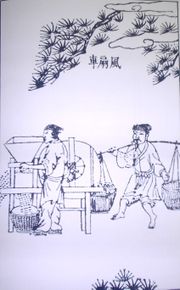
Chinese rotary fan winnowing machine, from an encyclopedia published in 1637 by Song Yingxing
|

Xiangqi board game
|
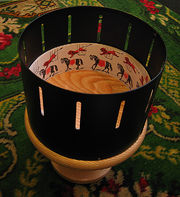
A modern replica of a Victorian zoetrope
|
- Wheelbarrow: There is evidence that wheelbarrows (i.e. the hyperteria monokyklou, or 'one-wheeler') existed in ancient Greece by the late 5th century BC,[552][553] and later re-appeared in Europe by the 13th century AD,[554] while their use in Western Han (202 BC–9 AD) China by the 1st century BC is attested to by written evidence; illustrations of their use were depicted on tomb murals in China by the 2nd century AD, during the Eastern Han (25–220 AD).[555][556]
- Wine server, artificial mountain with a puppet: In the early 8th century, a Tang Dynasty (618–907) engineer created an elaborate artificial mountain carved out of iron that was 0.9 m (3 ft) tall, sitting atop a lacquered-wooden frame shaped as a tortoise.[557] From the mountain, wine flowed down onto cups that tilted by force of gravity and spilled the liquid into an artificial lake of wine; a hydraulic pump siphoned the wine back into a hidden reservoir of the mountain that could store 15 liters (16 quarts) of wine.[557] The same pump was used to siphon wine through dragon-headed faucets which had a mouth with movable parts that could open when the wine was poured.[557] The wine from the faucet poured into a cup which could be left on a large iron platform shaped as a lotus leaf.[557] If the drinker was too slow in consuming the wine and placing the cup back in time, the door of a tiny pavilion on the top of the mountain opened automatically while a small puppet sprang forth holding a menacing bat to taunt the slow drinker.[557] Once the cup was placed back on the lotus leaf, the puppet with the bat returned inside the pavilion while the miniature doors closed behind him.[557]
- Winnowing fan: Contemporary to the rotary air conditioning fan invented by Ding Huan (fl. 180 AD) is a pottery tomb model of a crank-operated rotary winnowing fan from the Han Dynasty (202 BC–220 AD), used for separating chaff from the grain.[558][559] The winnowing fan was first described during the Tang Dynasty (618–907) by Yan Shigu (581–645), in his commentary on the Jijiupian dictionary written earlier in 40 BC by Shi Yu; it was also mentioned in a poem by the Song Dynasty (960–1279) artist Mei Yaochen in about 1060.[560] The earliest known drawn illustration of the winnowing fan comes from the Book of Agriculture published in 1313 by Wang Zhen (fl. 1290–1333).[561]
X
- Xiangqi (See also: List of Chinese inventions#L - Liubo): The exact origins of the Chinese chess board game known as xiangqi are ambiguous. Historian David H. Li asserts that it was first invented by Han Xin (d. 196 BC), a renowned military general of the early Han Dynasty (202 BC–220 AD) who fell victim to a purge instigated by Empress Lü Zhi (d. 180 BC), who accused him of trying to rebel, hence his board game quickly came to be associated with his infamous legacy.[562] However, Li states that it was revived under a different, camouflaged name of xiangxi by Emperor Wu of Northern Zhou (r. 561–578), which to this day has made the two terms synonymous and interchangeable for the same game.[563] Playing of the game was banned during the Sui Dynasty (581–618), yet Emperor Taizong (r. 626–649) of the Tang Dynasty (618–907) became an enthusiast of the game and poets like Bai Juyi (772–846) even dedicated poems to it.[564] Variants of the game include banqi and giog.
Z
- Zoetrope: There is some evidence that the zoetrope, a primitive ancestor of the cinematograph which the Chinese called a "magic lantern", existed amongst the items of the treasury of the deceased Qin Shi Huang (r. 221–210 BC) of the Qin Dynasty (221–206 BC).[565][566] A magician named Shao Ong who staged a seance for Emperor Wu of Han (r. 141–87 BC) may have used a zoetrope in his performance of 121 BC.[566] The first clear evidence of the zoetrope used in China comes from the late Han Dynasty (202 BC–220 AD), when the artisan Ding Huan (丁緩) made a 'nine-storied hill-censer' around 180 AD.[565][566] This featured figures of birds and other animals who moved when the lamp was lit; the convection of rising hot air currents caused the vanes at the top canopy of the lamp to spin, while the painted figures on paper attached to the side of the cylinder gave the impression that they were in movement.[565] This sort of toy was remade in subsequent dynasties as well.[567][568]
See also
- Chinese exploration
- List of Chinese discoveries
- Science and technology of the Han Dynasty
- Technology of the Song Dynasty
- History of science in Classical Antiquity
- History of science and technology in China
- History of typography in East Asia
- List of China-related topics
Footnotes
- ↑ Bowman (2000), 104–105.
- ↑ Levathes (1994), 37–38.
- ↑ Hsu (1988), 96.
- ↑ Bellwood (2006), 106.
- ↑ Needham (2004), Volume 7, Part 2, 201.
- ↑ Bray (1978), 24–26.
- ↑ Bray (1978), 27–28.
- ↑ Buisseret (1998), 12.
- ↑ Needham (1986), Volume 5, Part 1, 1–2, 40–41, 122–123, 228.
- ↑ Bowman (2000), 594.
- ↑ 11.0 11.1 Tom (1989), 99.
- ↑ 12.0 12.1 Day & McNeil (1996), 122.
- ↑ Cotterell (2004), 11–13.
- ↑ Cotterell (2004), 11.
- ↑ Pan (1997), 979–980.
- ↑ Needham (1986), Volume 5, Part 1, 149–150.
- ↑ 17.0 17.1 17.2 Needham (1986), Volume 5, Part 1, 151.
- ↑ Ebrey (1999), 124–125.
- ↑ Needham, Volume 5, Part 1, 201–202.
- ↑ 20.0 20.1 Gernet (1996), 335.
- ↑ 21.0 21.1 Bowman (2000), 599.
- ↑ 22.0 22.1 Day & McNeil (1996), 70.
- ↑ Needham (1986), Volume 5, Part 1, 202.
- ↑ Needham (1986), Volume 5, Part 1, 205–207.
- ↑ Needham, Volume 5, Part 1, 212.
- ↑ 26.0 26.1 Bowman (2000), 601.
- ↑ Needham (1986), Volume 5, Part 1, 203.
- ↑ Needham (1986), Volume 5, Part 1, 227–229.
- ↑ Needham (1986), Volume 5, Part 1, 227.
- ↑ Needham, Volume 5, Part 7, 8–9, 80–82.
- ↑ Needham (1986), Volume 5, Part 7, 70–73, 120–124.
- ↑ 32.0 32.1 32.2 Gernet (1996), 311.
- ↑ Day & McNeil (1996), 785.
- ↑ Needham (1986), Volume 5, Part 7, 24–25, 345–346.
- ↑ 35.0 35.1 Li Shu-hua (1954), 176, 180.
- ↑ Carlson (1975), 753–760.
- ↑ Blanc (1985), 125, 128, 132–133, 136.
- ↑ Knoblock (2001), 218.
- ↑ Rickett (1998), 426.
- ↑ Carlson (1975), 755.
- ↑ 41.0 41.1 Gernet (1962), 77.
- ↑ Tom (1989), 98–99.
- ↑ Lacheisserie (2005), 5
- ↑ Aczel (2002), 80.
- ↑ Needham (1986), Volume 4, Part 1, see 261 footnote. f for ch. 52 on ladle and 232 footnote. d for ch. 47 on magnet (c.f. Lunheng ch. 52 & ch. 47).
- ↑ Sivin (1995), III, 21–22.
- ↑ Needham (1986), Volume 4, Part 1, 279.
- ↑ Elisseeff (2000), 296.
- ↑ Gernet (1996), 328.
- ↑ 50.0 50.1 50.2 Day & McNeil (1996), 636.
- ↑ Needham (1986), Volume 4, Part 1, 252.
- ↑ Sivin (1995), III, 21.
- ↑ Temple (1986), 155–157.
- ↑ 54.0 54.1 Huang (2002), 20–27.
- ↑ Falkenhausen (1994), 132, Appendix I 329, 342.
- ↑ Falkenhausen (1994), 134.
- ↑ 57.0 57.1 Wang (1997), 93–96.
- ↑ Underhill (2002), 106.
- ↑ Legge (2004), 525.
- ↑ Watson (2003), 101.
- ↑ Mair (1997), 336.
- ↑ 62.0 62.1 62.2 62.3 Luan (2006), 49–55.
- ↑ More about Excavations at the Tomb of Marquis Yi. nga.gov. Retrieved on 2008-08-03.
- ↑ Di Cosmo (2002), 274.
- ↑ 65.0 65.1 65.2 Lu (2006), 123–124.
- ↑ Liang (2004),35&38
- ↑ Chen (2003), 24.
- ↑ Ma (1987), 122.
- ↑ Gabriel, 143.
- ↑ Wang(1982),123
- ↑ Liu (2007),123
- ↑ Sterckx (2002), 125.
- ↑ Porter (1996), 53.
- ↑ Liu(2007),122
- ↑ Hanson, David J. (1995). Preventing Alcohol Abuse: Alcohol, Culture, and Control. Greenwood Publishing Group. ISBN 9780275949266.
- ↑ McNamee (2008), 156
- ↑ Angier (2007), 142.
- ↑ E. McGovern (2007), 314.
- ↑ 79.0 79.1 E. McGovern et al. (2004), 17593.
- ↑ Oldest Wine Comes From China. About.com. Retrieved on 2008-7-4
- ↑ Chinese People Were Drinking Wine 9,000 Years Ago. Physorg.com. Retrieved 2008-7-4
- ↑ Needham (1986), Volume 6, Part 5, 105–108
- ↑ Loewe (1968), 170–171.
- ↑ Stark (2005),30
- ↑ 85.0 85.1 85.2 Wang (1982),80
- ↑ Loewe (1999),178.
- ↑ Temple (1986), 75.
- ↑ Loewe (1968), 186–187.
- ↑ Murphy (2007), 114, 184.
- ↑ Sagart (2005), 21.
- ↑ Bellwood (2004), 121.
- ↑ Murphy (2007), 186–187.
- ↑ BBC News. (October 12, 2005). Oldest noodles unearthed in China. News.bbc.co.uk. Retrieved on 2008-08-02.
- ↑ Deng (1997), 22.
- ↑ Nelson (1995), 85.
- ↑ The Japan Times. (February 10, 1999). Oldest oar unearthed from Ishikawa ruins. Retrieved on 2008-08-13.
- ↑ Liu (2007), 65.
- ↑ Wu (1990), 349–365
- ↑ Liu (2007), 126.
- ↑ Liu (2007), 66.
- ↑ Harris (1996), 427–428.
- ↑ You (1999), 1–8.
- ↑ Murphy (2007), 187.
- ↑ Murphy (2007), 187–188.
- ↑ Brook (2004), 81–85.
- ↑ Origins and evolution of the Western diet: health implications for the 21st century. American Journal of Clinical Nutrition. Retrieved on 2008-7-5.
- ↑ Rowan Flad et al. (2005), 12618–12622.
- ↑ A seasoned ancient state: Chinese site adds salt to civilization's rise. Sciencenews.org. Retrieved on 2008-7-5.
- ↑ 109.0 109.1 Schoeser (2007), 17.
- ↑ Simmons (1950), 87.
- ↑ Murphy (2007), 121.
- ↑ Siddiqi (2001), 389
- ↑ Murphy (2007), 122–123.
- ↑ Murphy (2007), 135.
- ↑ Chen (1995), 198.
- ↑ Cheng (2005), 102–107.
- ↑ Underhill (2002), 156 & 174.
- ↑ Underhill (2002), 30.
- ↑ Underhill (2002), 215 & 217.
- ↑ 3000-Year-Old Boat Coffin Contents Suggest Owner of Prominence. epochtimes.com. Retrieved on 2008-08-03.
- ↑ Hu (2005), 159.
- ↑ Liu (2007), 132.
- ↑ Red Pottery Urn Coffin. cultural-china.com. Retrieved on 2008-08-03
- ↑ Legge (2004), 108.
- ↑ Zheng (2005), 48.
- ↑ Omura (2003), 15.
- ↑ Omura (2003), 19 & 22.
- ↑ Helmer (2006), 51, 107, & 120.
- ↑ 129.0 129.1 129.2 Trigger (2006), 74–75.
- ↑ Zhao (2000), 6–9.
- ↑ 131.0 131.1 Loewe (1999), 847.
- ↑ Sterckx (2002), 66–67.
- ↑ 133.0 133.1 133.2 Clunas (2004), 95.
- ↑ Ebrey (1999), 148.
- ↑ 135.0 135.1 135.2 135.3 Trigger (2006), 74.
- ↑ 136.0 136.1 Rudolph (1963), 171.
- ↑ Rudolph (1963), 170.
- ↑ 138.0 138.1 138.2 138.3 138.4 Fraser & Haber (1986), 227.
- ↑ 139.0 139.1 139.2 139.3 139.4 Needham (1986), Volume 3, 574.
- ↑ Clunas (2004), 97.
- ↑ Trigger (2006), 75–76.
- ↑ 142.0 142.1 142.2 China Daily (February 10, 2007). 4 Great Modern Inventions Selected. Chinadaily.com.cn. Retrieved on 2008-06-18.
- ↑ Croft (1997), 5007–5008.
- ↑ Williams (2004), 131.
- ↑ Lasater (2008), 193 & 202.
- ↑ Needham (1986), Volume 4, Part 2, 30 & 479 footnote e.
- ↑ Crespigny (2007), 1050.
- ↑ Morton & Lewis (2005), 70.
- ↑ Loewe (1968), 107.
- ↑ 150.0 150.1 Bowman (2000), 595.
- ↑ Temple (1986), 37.
- ↑ 152.0 152.1 152.2 152.3 152.4 Needham (1986), Volume 4, Part 2, 162.
- ↑ Johnson (1999), 126.
- ↑ Temple (1986), 120–121.
- ↑ Ebrey, Walthall, and Palais (2006), 156.
- ↑ 156.0 156.1 Bowman (2000), 105.
- ↑ 157.0 157.1 Gernet (1962), 80.
- ↑ Ch'en (1965), 615–621.
- ↑ Temple (1986), 117.
- ↑ Gernet (1962), 80–81.
- ↑ Temple (1986), 77 & 103.
- ↑ 162.0 162.1 162.2 162.3 Temple (1986), 77.
- ↑ 163.0 163.1 163.2 163.3 Temple (1986), 78.
- ↑ Temple (1986), 77–78.
- ↑ Wagner (2001), 77–80.
- ↑ Crespigny (2007), 184.
- ↑ Needham (1986), Volume 4, Part 2, 370–376.
- ↑ Day & McNeil (1996), 225.
- ↑ Temple (1986), 54.
- ↑ Temple (1986), 54–55.
- ↑ Needham (1986), Volume 4, Part 2, 107–;108.
- ↑ Needham (1986), Volume 4, Part 2, PLATE CXLVII.
- ↑ 173.0 173.1 Needham (1986), Volume 7, Part 2, 214.
- ↑ 174.0 174.1 Wagner (2001), 7, 36–37, 64–68.
- ↑ Pigott (1999), 183–184.
- ↑ Needham (1986), Volume 5, Part 7, 170–174.
- ↑ 177.0 177.1 Needham (1986), Volume 5, Part 7, 171.
- ↑ Needham (1986), Volume 5, Part 7, 173–174.
- ↑ Needham (1986), Volume 5, Part 7, 170.
- ↑ Loewe (1968), 194.
- ↑ 181.0 181.1 181.2 181.3 181.4 Tom (1989), 103.
- ↑ Loewe (1968), 191.
- ↑ Wang (1982), 105.
- ↑ "Who invented the toothbrush and when was it invented?". The Library of Congress. 2007-04-04. http://www.loc.gov/rr/scitech/mysteries/tooth.html. Retrieved 2008-04-12.
- ↑ Kendall (2006), 2.
- ↑ Needham (1986), Volume 4, Part 3, 391, 422, 462–463.
- ↑ Ebrey, Walthall, and Palais (2006), 159.
- ↑ Needham (1986), Volume 4, Part 3, 420–422.
- ↑ Gernet (1996), 327.
- ↑ 190.0 190.1 190.2 190.3 190.4 Temple (1986), 72.
- ↑ 191.0 191.1 You (1994), 80.
- ↑ 192.0 192.1 192.2 Deng (2005), 67.
- ↑ Asiapac Editorial (2004), 132.
- ↑ Deng (2005), 67–69.
- ↑ Needham (1986), Volume 3, 109–110.
- ↑ Ho (2000), 105.
- ↑ Restivo (1992), 32.
- ↑ Ebrey, Walthall, and Palais (2006), 30.
- ↑ Gernet (1996), 69.
- ↑ Wagner (1993), 335.
- ↑ Pigott (1999), 177.
- ↑ Wagner (1993), 336.
- ↑ Wang (1982), 1982.
- ↑ 204.0 204.1 Dewar (2002), 42.
- ↑ Wood (1999), 75–76.
- ↑ Ceccarelli (2004), 69.
- ↑ Campbell (2003), 7.
- ↑ Soedel & Foley (1979), 124–125.
- ↑ Needham (1986), Volume 4, Part 2, 109–111.
- ↑ Needham (1986), Volume 4, Part 2, 344.
- ↑ Fry (2001), 11.
- ↑ Needham (1986), Volume 4, Part 2, 111, 165, 456–457.
- ↑ 213.0 213.1 Gernet (1996), 341.
- ↑ 214.0 214.1 214.2 Temple (1986), 215.
- ↑ 215.0 215.1 215.2 Temple (1986), 217.
- ↑ Lu (2004), 209–216.
- ↑ Le due leggende sulle bacchette cinesi cri.cn. Retrieved on 2008-7-20
- ↑ The National Museum of Mongolian History. washington.edu. Retrieved on 2008-7-20.
- ↑ Needham (1986), Volume 6, Part 5, 104, footnote 161.
- ↑ Cotterell (2004), 102.
- ↑ Ling (1991), 12–23.
- ↑ 222.0 222.1 Leibs (2004), 30.
- ↑ 223.0 223.1 Leibs (2004), 30–31.
- ↑ Leibs (2004), 31.
- ↑ Crespigny (2007), 1222 & 1232.
- ↑ Bielenstein (1980), 9 & 19.
- ↑ Wang (1949), 152.
- ↑ Loewe (1968), 45.
- ↑ Ebrey (2006), 97.
- ↑ Gasciogne and Gasciogne (2003), 95.
- ↑ Hartwell (1982), 416–420.
- ↑ Ebrey (1999), 145–146.
- ↑ Fairbank (2006), 94.
- ↑ Gernet (1962), 65.
- ↑ 235.0 235.1 235.2 235.3 235.4 Temple (1986), 68.
- ↑ 236.0 236.1 Needham (1986), Volume 4, Part 2, 34.
- ↑ Temple (1986), 68–69.
- ↑ Ebrey, Walthall, and Palais (2006), 158.
- ↑ Ebrey (1999), 144.
- ↑ Hobson (2004), 53.
- ↑ 241.0 241.1 Temple (1986), 182.
- ↑ Temple (1986), 182–183.
- ↑ Needham (1986), Volume 4, Part 2, 118 & PLATE CLVI.
- ↑ Temple (1986), 46.
- ↑ Needham (1986), Volume 4, Part 2, 116–119.
- ↑ Gurstelle, William (2004).The Art of the Catapult. Chicago Review Press. ISBN 1-5565-2526-5, p. 49
- ↑ Diod. Sic. 14.42.1
- ↑ Duncan Campbell: Greek and Roman Artillery 399 BC-AD 363, Osprey Publishing, Oxford 2003, ISBN 1841766348, p.3
- ↑ Wagner (1993), 153, 157–158.
- ↑ A Crossbow Mechanism with Some Unique Features from Shandong, China. Asian Traditional Archery Research Network. Retrieved on 2008-08-20.
- ↑ Mao (1998), 109–110.
- ↑ Wright (2001), 159.
- ↑ Lin (1993), 36.
- ↑ Wright (2001), 42.
- ↑ Needham (1986), Volume 5, Part 6, 124–128.
- ↑ Lewis (2000a), 45.
- ↑ Di Cosmo (2002), 203.
- ↑ Campbell (2003), 3–6
- ↑ Needham (1986)Volume 5, Part 6, 170–172
- ↑ Brodie & Brodie (1973), 20 & 35.
- ↑ DeVries (2003), 127–128.
- ↑ Campbell (2003), 4.
- ↑ 263.0 263.1 263.2 263.3 Speak (1999), 32.
- ↑ Watson (1961 II), 178.
- ↑ Pigott (1999), 191.
- ↑ Wagner (2001), 75–76.
- ↑ Pigott (1999), 177 & 191.
- ↑ 268.0 268.1 268.2 268.3 268.4 268.5 268.6 Temple (1986), 131.
- ↑ 269.0 269.1 269.2 269.3 269.4 269.5 Lo (2000), 401.
- ↑ 270.0 270.1 270.2 Temple (1986), 132.
- ↑ Medvei (1993), 49.
- ↑ 272.0 272.1 272.2 272.3 Temple (1986), 133.
- ↑ Pickover (2002), 141.
- ↑ 274.0 274.1 Fletcher (1996), 693.
- ↑ Needham (1986), Volume 4, Part 3, 100.
- ↑ 276.0 276.1 276.2 Broudy (1979), 124.
- ↑ Forbes (1987), 218 & 220.
- ↑ 278.0 278.1 Beaudry (2006), 146.
- ↑ Broudy (1979), 130–133.
- ↑ Temple (1986), 128–129.
- ↑ Temple (1986), 127.
- ↑ Temple (1986), 130.
- ↑ Lewis (2000b), 343–369 (356f.)
- ↑ Needham (1986), Volume 4, Part 2, 89, 445–456, 473–475.
- ↑ Fry (2001), 10.
- ↑ Bodde (1991), 140.
- ↑ Day & McNeil (1996), 781, 786–787.
- ↑ Needham (1986), Volume 4, Part 2, 473–474.
- ↑ Needham (1986), Volume 4, Part 2, 460–462.
- ↑ 290.0 290.1 290.2 Needham (1986), Volume 4, Part 2, 460.
- ↑ David Landes: “Revolution in Time: Clocks and the Making of the Modern World”, rev. and enlarged edition, Harvard University Press, Cambridge 2000, ISBN 0674002822, p.18f.
- ↑ Ricardo Duchesne: “Asia First?”, The Journal of the Historical Society, Vol. 6, No. 1 (March 2006), pp. 69-91 (77f.)
- ↑ Needham (1986), Volume 5, Part 7, 264.
- ↑ Cowley (1996), 49.
- ↑ Needham (1986), Volume 4, Part 2, 159–160, 256–257.
- ↑ 296.0 296.1 Needham (1986), Volume 4, Part 2, 256.
- ↑ Needham, Volume 4, Part 2, 255.
- ↑ Needham (1986), Volume 4, Part 2, 255–256.
- ↑ 299.0 299.1 299.2 Pigott (1999), 186.
- ↑ Pigott (1999), 186–187.
- ↑ Wagner (2001), 80–83.
- ↑ Wagner (2001), 80.
- ↑ Needham (1986), Volume 5, Part 7, 224–225, 232–233, 241–244.
- ↑ Embree (1997), 185.
- ↑ Cowley (1996), 38.
- ↑ Gernet (1962), 186.
- ↑ Kelly (2004), 2.
- ↑ 308.0 308.1 Crosby (2002), 100–103.
- ↑ Needham (1986), Volume 5, Part 7, 485–489.
- ↑ Birrell (1993), 185.
- ↑ Hucker (1975), 206.
- ↑ Ronan (1994), 41.
- ↑ Temple (1986), 88.
- ↑ 314.0 314.1 314.2 314.3 314.4 314.5 Needham (1986), Volume 4, Part 2, 100 & PLATE CXLVII.
- ↑ Needham (1986), Volume 5, Part 7, 77–78.
- ↑ 316.0 316.1 Needham (1986), Volume 5, Part 7, 81–84.
- ↑ Gernet (1996), 310.
- ↑ 318.0 318.1 Temple (1986), 234.
- ↑ 319.0 319.1 319.2 319.3 319.4 Haskell (2006), 432.
- ↑ 320.0 320.1 320.2 320.3 320.4 320.5 Needham (1986), Volume 4, Part 1, 211.
- ↑ Needham (1986), Volume 4, Part 1, 211–212.
- ↑ 322.0 322.1 322.2 Temple (1986), 78–79.
- ↑ 323.0 323.1 Temple (1986), 79–80.
- ↑ 324.0 324.1 324.2 Temple (1986), 80.
- ↑ Temple (1986), 80–81.
- ↑ Needham (1986), Volume 4, Part 2, 228–229.
- ↑ Needham (1986), Volume 4, Part 2, 229 & 231.
- ↑ Needham (1986), Volume 4, Part 2, 236.
- ↑ Sarton (1959), 349–350.
- ↑ 330.0 330.1 Needham (1986), Volume 4, Part 2, 233.
- ↑ Needham (1986), Volume 4, Part 2, 233–234.
- ↑ Needham (1986), Volume 4, Part 2, 234–235.
- ↑ Needham (1986), Volume 4, Part 2, 234.
- ↑ Lasker (1960), xiii.
- ↑ Shotwell, Yang, and Chatterjee (2003), 133.
- ↑ 336.0 336.1 San Diego Chinese Historical Museum. (May–August 2001). Gu Qin: Traditional Chinese Zithers. Sdchm.org. Retrieved on 2008-08-03.
- ↑ Origins of the Qin. silkqin.com Retrieved on 2008-08-22.
- ↑ Lian (2001), 20.
- ↑ Needham (1986), Volume 5, Part 7, 293–294.
- ↑ 340.0 340.1 340.2 Temple (1986), 245.
- ↑ 341.0 341.1 Greenberger (2006), 11.
- ↑ Bray (1978), 9 & 19–21.
- ↑ Greenberger (2006), 11–12.
- ↑ Wang (1982), 53–54.
- ↑ Temple (1986), 23.
- ↑ 346.0 346.1 Needham (1986), Volume 4, Part 2, 319–323.
- ↑ Schur (1998), 66.
- ↑ Needham (1986), Volume 4, Part 2, 326 & Plate CCXXI.
- ↑ Needham (1986), Volume 4, Part 2, 305.
- ↑ Temple (1986), 20.
- ↑ Needham (1986), Volume 4, Part 2, 310.
- ↑ Temple (1986), 21.
- ↑ Needham (1986), Volume 4, Part 2, 308–312.
- ↑ Needham (1986), Volume 4, Part 2, 22–23.
- ↑ Gottsegen (2006), 30.
- ↑ Smith (1992), 23.
- ↑ Sun & Sun (1997), 288.
- ↑ Woods & Woods (2000), 51–52.
- ↑ Sivin (1995), III, 24.
- ↑ Menzies (1994), 24.
- ↑ Deng (2005), 36.
- ↑ Needham (1986), Volume 5, Part 7, 75–76.
- ↑ 363.0 363.1 Temple (1986), 136.
- ↑ Needham (1986), Volume 6, Part 6, 154.
- ↑ 365.0 365.1 Needham (1986), Volume 6, Part 6, 134.
- ↑ Temple (1986), 136–137.
- ↑ Temple (1986), 137.
- ↑ Temple (1986), 135–137.
- ↑ Needham (1986), Volume 3, 573.
- ↑ Tom (1989), 112.
- ↑ Tom (1989), 112–113.
- ↑ 372.0 372.1 Tom (1989), 113.
- ↑ Shi (2003), 63–65.
- ↑ Block (2003), 123.
- ↑ Turnbull (2002), 4, 15–16.
- ↑ Needham (1986), Volume 4, Part 3, 678.
- ↑ Turnbull (2002), 14.
- ↑ Needham (1986), Volume 4, Part 3, 390–391.
- ↑ 379.0 379.1 Needham (1986), Volume 4, Part 3, 391.
- ↑ Temple (1986), 187.
- ↑ Day & McNeil (1996), 295.
- ↑ Needham (1986), 577–578.
- ↑ Needham (1986), Volume 3, 580–581.
- ↑ 384.0 384.1 384.2 384.3 Temple (1986), 179.
- ↑ Needham (1986), Volume 5, Part 7, 175–176, 192.
- ↑ Needham (1986), Volume 5, Part 7, 24–25, 176, 192.
- ↑ Needham (1986), Volume 5, Part 7, 193 & 199.
- ↑ Temple (1986), 188.
- ↑ 389.0 389.1 Johnstone & McGrail (2001), 218.
- ↑ 390.0 390.1 Temple (1986), 188–189.
- ↑ Block (2003), 119–120.
- ↑ McGrail (2004), 237.
- ↑ 393.0 393.1 Loewe (1986), 141.
- ↑ 394.0 394.1 Loewe (1968), 144–145.
- ↑ 395.0 395.1 Li (2004), 8–9 & 13.
- ↑ Handler (2001), 181.
- ↑ Loewe (1999), 839.
- ↑ Li (2005), 66–68.
- ↑ Temple (1986), 66.
- ↑ 400.0 400.1 400.2 400.3 Temple (1986), 66–67.
- ↑ 401.0 401.1 401.2 401.3 Xinhua News Agency (October 5, 2007). China to mass produce maglev wind power generators. News.xinhua.com. Retrieved on 2008-08-10.
- ↑ 402.0 402.1 402.2 402.3 People's Daily. (July 2, 2006). Chinese company develops high-efficient wind power generator. English.peopledaily.com. Retrieved on 2008-08-10.
- ↑ Rep (2007), 52.
- ↑ 404.0 404.1 Rep (2007), 51.
- ↑ 405.0 405.1 Temple (1986), 175–176.
- ↑ Temple (1986), 175.
- ↑ 407.0 407.1 Temple (1986), 176.
- ↑ Temple (1986), 177–178.
- ↑ 409.0 409.1 409.2 Temple (1986), 98.
- ↑ 410.0 410.1 410.2 410.3 410.4 410.5 Needham (1986), Volume 4, Part 2, 159.
- ↑ Needham (1986), Volume 4, Part 2, 160.
- ↑ 412.0 412.1 412.2 412.3 412.4 412.5 Needham, Volume 4, Part 2, 160.
- ↑ Needham (1986), Volume 4, Part 2, 161 & 417.
- ↑ Temple (1986), 192.
- ↑ Needham (1986), Volume 4, Part 2, 160 (footnote c and d)
- ↑ Guo (1998), 1–3.
- ↑ Guo (1998), 6–7.
- ↑ Guo (1998), 7–8.
- ↑ Guo (1998), 7.
- ↑ Guo (1999), 97.
- ↑ 421.0 421.1 Greenberger (2006), 12.
- ↑ Cotterell (2004), 46.
- ↑ Needham (1986), Volume 5, Part 7, 472–474.
- ↑ Needham, Volume 5, Part 7, 473–505.
- ↑ Needham (1986), Volume 5, Part 7, 505–510.
- ↑ Temple (1986), 240–241.
- ↑ Temple (1986), 79.
- ↑ Needham (1986), Volume 5, Part 7, 203–205.
- ↑ Needham (1986), Volume 3, 24–25.
- ↑ 430.0 430.1 430.2 430.3 Temple (1986), 141.
- ↑ Teresi (2002), 65–66.
- ↑ Needham (1986), Volume 4, Part 3, 177–179.
- ↑ Day & McNeil (1996), 434.
- ↑ 434.0 434.1 Temple (1986), 69.
- ↑ Needham (1986), Volume 4, Part 3, Plate CCCL
- ↑ Temple (1986), 70.
- ↑ Temple (1986), 70–71.
- ↑ 438.0 438.1 Clee (2005), 6.
- ↑ 439.0 439.1 439.2 Needham (1986), Volume 4, Part 1, 82.
- ↑ Needham (1986), Volume 4, Part 1, 85.
- ↑ Needham (1986), Volume 4, Part 1, 97–98.
- ↑ Needham (1986), Volume 5, Part 1, 131–132.
- ↑ 443.0 443.1 Zhou (1997), 34.
- ↑ Lo (2000), 390.
- ↑ 445.0 445.1 445.2 Needham (1986), Volume 5, Part 1, 132.
- ↑ 446.0 446.1 446.2 Temple (1986), 116.
- ↑ 447.0 447.1 Needham (1986), Volume 5, Part 1, 309.
- ↑ Temple (1986), 116–117.
- ↑ Adshead (2004), 80.
- ↑ Wood (1999), 49.
- ↑ Moore, Frank Gardner: "Three Canal Projects, Roman and Byzantine", American Journal of Archaeology, Vol. 54, No. 2 (1950), pp. 97–111 (99)
- ↑ 452.0 452.1 Needham (1986), Volume 4, Part 3, 350–352.
- ↑ Day & McNeil (1996), 582.
- ↑ Temple (1986), 196.
- ↑ Temple (1986), 197.
- ↑ Needham (1986), Volume 4, Part 2, 156.
- ↑ 457.0 457.1 457.2 457.3 Needham (1986), Volume 4, Part 2, 158.
- ↑ Needham (1986), Volume 4, Part 2, 164.
- ↑ 459.0 459.1 459.2 Needham (1986), Volume 3, 579.
- ↑ 460.0 460.1 Temple (1986), 181.
- ↑ Sivin (1995), III, 22.
- ↑ Ebrey, Walthall, and Palais (2006), 162.
- ↑ 463.0 463.1 463.2 463.3 Needham (1986), Volume 3, 580.
- ↑ 464.0 464.1 Temple (1986), 180.
- ↑ West (1997), 70–76.
- ↑ Gernet (1962), 133–134, 137.
- ↑ Needham (1986), Volume 5, Part 7, 498–501.
- ↑ 468.0 468.1 468.2 Needham (1986), Volume 5, Part 7, 500.
- ↑ 469.0 469.1 469.2 Needham (1986), Volume 5, Part 2, 502.
- ↑ Needham (1986), Volume 4, Part 2, 99, 134, 151, 233.
- ↑ Day & McNeil (1996), 210.
- ↑ Needham, Volume 4, Part 2, 154.
- ↑ 473.0 473.1 Mott (1991), 2–3, 92, 84, 95f.
- ↑ 474.0 474.1 Adshead (2000), 156.
- ↑ Needham (1986), Volume 4, Part 3, 627–628.
- ↑ Chung (2005), 152.
- ↑ Johnstone & McGrail (1988), 191.
- ↑ Block (2003), 8–9.
- ↑ Needham (1986), Volume 4, Part 3, 649–650.
- ↑ Fairbank (2006), 192.
- ↑ 481.0 481.1 481.2 481.3 Deng (1997), 42.
- ↑ Christides (1996), 66–67.
- ↑ Tom (1989), 103–104.
- ↑ Gernet (1996), 378.
- ↑ 485.0 485.1 Tom (1989), 104.
- ↑ Minford & Lau (2002), 307.
- ↑ Balchin (2003), 26–27.
- ↑ Needham (1986), Volume 3, 627–635.
- ↑ Krebs (2003), 31.
- ↑ Wright (2001), 66.
- ↑ Huang (1997), 64.
- ↑ Yan (2007), 131–132.
- ↑ Needham (1986), Volume 4, Part 2, 40, 286–298.
- ↑ Day & McNeil (1996), 461.
- ↑ Tom (1989), 98.
- ↑ Needham (1986), Volume 4, Part 2, 287.
- ↑ Needham (1986), Volume 4, Part 2, 289.
- ↑ Needham (1986), Volume 4, Part 2, 291–292.
- ↑ "Ironware piece unearthed from Turkey found to be oldest steel". http://www.hindu.com/thehindu/holnus/001200903261611.htm. Retrieved 2009-03-27.
- ↑ "Civilizations in Africa: The Iron Age South of the Sahara". Washington State University. http://www.wsu.edu/~dee/CIVAFRCA/IRONAGE.HTM. Retrieved 2007-08-14.
- ↑ "Noricus ensis," Horace, Odes, i. 16.9
- ↑ Temple (1986), 49–50.
- ↑ 503.0 503.1 503.2 503.3 Temple (1986), 50.
- ↑ Temple (1986), 49.
- ↑ Dien (1986), 33–56.
- ↑ Dien (1981), 5–66.
- ↑ 507.0 507.1 507.2 Addington (1990), 45.
- ↑ 508.0 508.1 508.2 Graff (2002), 42.
- ↑ Temple (1986), 89.
- ↑ Hobson (2004), 103.
- ↑ Needham (1986), Volume 4, Part 3, 196–197.
- ↑ Tom (1989), 105–106.
- ↑ Martin (2007), 8.
- ↑ Heiss (2007), 4–6.
- ↑ Needham (1986), Volume 6, Part 5, 513.
- ↑ Wang (2005), 2–3, 11.
- ↑ Wang (2005), 17–20.
- ↑ Heiss (2007), 296–297.
- ↑ Needham (1986), Volume 6, Part 5, 506.
- ↑ 520.0 520.1 Temple (1986), 135.
- ↑ Temple (1986), 133–134.
- ↑ 522.0 522.1 522.2 Temple (1986), 134.
- ↑ Medvei (1993), 48.
- ↑ Temple (1986), 134–135
- ↑ 525.0 525.1 Shurtleff & Aoyagi (2001), 92.
- ↑ Liu (1999), 166.
- ↑ 527.0 527.1 Yang (2004), 217–218.
- ↑ Sun (1998), 293-96.
- ↑ Shinoda (1963), 4.
- ↑ Sun (1998), 292—93.
- ↑ Liu (1999), 166–167.
- ↑ 532.0 532.1 532.2 532.3 Needham, Volume 5, Part 1, 123.
- ↑ Hunter (1978), 207.
- ↑ Chevedden (1998), 179–222.
- ↑ Turnbull (2001), 9, 45–46.
- ↑ Chevedden (1999), 36.
- ↑ Needham, Volume 4, Part 2, 183–184, 390–392.
- ↑ Needham, Volume 4, Part 2, 379, 392–395.
- ↑ Wilson (2002), 1–32.
- ↑ Burnham (1997) 333–335.
- ↑ Wang (2007), 8 & 26.
- ↑ Xu (1996), 197 fn. 20, 204.
- ↑ Li (2006), 86.
- ↑ Guo et al. (1996), 1112–1114.
- ↑ 545.0 545.1 Temple (1986), 199–200.
- ↑ 546.0 546.1 546.2 Temple (1986), 199.
- ↑ Temple (1986), 200–201.
- ↑ Sima Qian Records of the Grand Historian Qin Shi Huang Scroll 4
- ↑ 549.0 549.1 Temple (1986), 73.
- ↑ 550.0 550.1 Temple (1986), 72–73.
- ↑ Needham (1986), Volume 4, Part 1, 39.
- ↑ Lewis (1994), 470–427.
- ↑ M. J. T. Lewis, p.470ff.
- ↑ Lewis (1994), 453.
- ↑ Needham (1986), Volume 4, Part 2, 263–267.
- ↑ Greenberger (2006), 13.
- ↑ 557.0 557.1 557.2 557.3 557.4 557.5 Benn (2002), 144.
- ↑ Needham (1986), Volume 4, Part 2, 118, 153–154, PLATE CLVI.
- ↑ Wang (1982), 57.
- ↑ Needham (1986), Volume 4, Part 2, 153–154.
- ↑ Needham (1986), Volume 4, Part 2, 118, 151–153.
- ↑ Li (1998), 214.
- ↑ Li (1998), 215.
- ↑ Li (1998), 215–216.
- ↑ 565.0 565.1 565.2 Needham (1986), Volume 4, Part 1, 123.
- ↑ 566.0 566.1 566.2 Temple (1986), 87.
- ↑ Needham (1986), Volume 4, Part 1, 123–124.
- ↑ Temple (1986), 87–88.
References
- Aczel, Amir D (2002). The Riddle of the Compass: The Invention that Changed the World. San Diego: Harcourt. ISBN 0156007533.
- Addington, Larry H. (1990). The Patterns of War Through the Eighteenth Century. Indiana University Press. ISBN 0253205514.
- Adshead, Samuel Adrian Miles. (2000). China in World History: Third Edition. London: MacMillan Press Ltd. New York: St. Martin's Press. ISBN 0312225652.
- Adshead, S.A.M. (2004). T'ang China: The Rise of the East in World History. New York: Palgrave Macmillan. ISBN 1403934568 (hardback).
- Allan, Sarah (1991). The Shape of the Turtle: Myth, Art and Cosmos in Early China. New York: State University of New York Press. ISBN 0791404595.
- An, Lihua. "The Origin of Golden Crow Bearing Sun Image on Han Dynasty's Painting", in Southeast Culture, 1992, No. 1:66–72. ISSN 1001-179X.
- Angier, Natalie (2007). The Canon: A Whirligig Tour of the Beautiful Basics of Science. Boston: Houghton Mifflin. ISBN 0618242953.
- Asiapac Editorial. (2004). Origins of Chinese Science and Technology. Translated by Yang Liping and Y.N. Han. Singapore: Asiapac Books Pte. Ltd. ISBN 9812293760.
- Balchin, Jon. (2003). Science: 100 Scientists Who Changed the World. New York: Enchanted Lion Books. ISBN 1592700179.
- Beaudry, Mary Carolyn. (2006). Findings: The Material Culture of Needlework and Sewing. New Haven: Yale University Press. ISBN 0300110936.
- Bellwood, Peter (2004). First Farmers: The Origins of Agricultural Societies. Malden, MA: Blackwell Pub. ISBN 0631205667.
- Bellwood, Peter. (2006). "Asian Farming Diasporas? Agriculture, Languages, and Genes in China and Southeast Asia," in Archaeology of Asia, 96–118, edited by Miriam T. Stark. Malden: Blackwell Publishing Ltd. ISBN 1405102128.
- Benn, Charles. (2002). China's Golden Age: Everyday Life in the Tang Dynasty. Oxford University Press. ISBN 0-19-517665-0.
- Bielenstein, Hans. (1980). The Bureaucracy of Han Times. Cambridge: Cambridge University Press. ISBN 0521225108.
- Birrell, Anne (1993). Chinese Mythology: An Introduction. Baltimore : Johns Hopkins University Press. ISBN 0804723532.
- Block, Leo. (2003). To Harness the Wind: A Short History of the Development of Sails. Annapolis: Naval Institute Press. ISBN 1557502099.
- Bodde, Derk (1991). Chinese Thought, Society, and Science. Honolulu: University of Hawaii Press.
- Bowman, John S. (2000). Columbia Chronologies of Asian History and Culture. New York: Columbia University Press. ISBN 0231110049.
- Bray, Francesca. "Swords into Plowshares: A Study of Agricultural Technology and Society in Early China," in Technology and Culture, Vol. 19, No. 1 (Jan., 1978): 1–31.
- Brook, Timothy (2004). The Chinese State in Ming Society. New York: RoutledgeCurzon. ISBN 0415345065.
- Broudy, Eric. (1979). The Book of Looms: A History of Handlooms from Ancient Times to the Present. Hanover: University Press of New England. ISBN 0874516498.
- Buisseret, David. (1998). Envisioning the City: Six Studies in Urban Cartography. Chicago: University Of Chicago Press. ISBN 0226079937.
- Burnham, Barry C. “Roman Mining at Dolaucothi: The Implications of the 1991-3 Excavations near the Carreg Pumsaint”, in Britannia, 1997, Vol. 28:325–336.
- Campbell, Duncan (2003). Greek and Roman Artillery 399 BC-AD 363. Oxford: Osprey Publishing. ISBN 1841766348.
- Carlson, John B. "Lodestone Compass: Chinese or Olmec Primacy?" in Science, New Series, Vol. 189, No. 4205 (Sep. 5, 1975): 753–760.
- Ceccarelli, Marco (2004). International Symposium on History of Machines and Mechanisms. Boston: Kluwer Academic. ISBN 1402022034.
- Chen, Cheng-Yih (1995). Early Chinese Work in Natural Science. Hong Kong: Hong Kong University Press. ISBN 962209385X.
- Ch'en, Jerome. "Sung Bronzes--An Economic Analysis," in Bulletin of the School of Oriental and African Studies, Vol. 28, No. 3, (1965): 613–626.
- Chen, Xuexiang. "On the Buried Jade Unearthed in the Erlitou Site, " in Cultural Relics of Central China, 2003, No. 3:23–37. ISSN 1003-1731.
- Cheng, Shihua. "On the Diet in the Liangzhu Culture," in Agricultural Archaeology, 2005, No. 1:102–109. ISSN 1006-2335.
- Chevedden, Paul E. (1998). "The Hybrid Trebuchet: The Halfway Step to the Counterweight Trebuchet," in On the Social Origins of Medieval Institutions: Essays in Honor of Joseph F. O'Callaghan, 179–222, edited by Donald J. Kagay and Theresa M. Vann. Leiden: Koninklijke Brill. ISBN 9004110968.
- Chevedden, Paul E. (1999). "Fortifications and the Development of Defensive Planning in the Latin East," in The Circle of War in the Middle Ages: Essays on Medieval Military and Naval History, 33–44, edited by Donald J. Kagay and L.J. Andrew Villalon. Woodbridge: The Boydell Press. ISBN 0851156452.
- Christides, Vassilios. (1996). "New Light on the Transmission of Chinese Naval Technology to the Mediterranean World: The Single Rudder," in Intercultural Contacts in the Medieval Mediterranean, 64–70, edited by Benjamin Arbel. London: Frank Cass and Company Ltd. ISBN 0714647144.
- Chung, Chee Kit. (2005). "Longyamen is Singapore: The Final Proof?," in Admiral Zheng He & Southeast Asia. Singapore: Institute of Southeast Asian Studies. ISBN 9812303294.
- Clee, Paul. (2005). Before Hollywood: From Shadow Play to the Silver Screen. New York: Clarion Books, an imprint of Houghton Mifflin Company. ISBN 0618445331.
- Clunas, Craig. (2004). Superfluous Things: Material Culture and Social Status in Early Modern China. Honolulu: University of Hawaii Press. ISBN 0824828208.
- Cotterell, Maurice. (2004). The Terracotta Warriors: The Secret Codes of the Emperor's Army. Rochester: Bear and Company. ISBN 159143033X.
- Cowley, Robert (1996). The Reader's Companion to Military History. Boston: Houghton–Mifflin Company.
- Crespigny, Rafe de. (2007). A Biographical Dictionary of Later Han to the Three Kingdoms (23-220 AD). Leiden: Koninklijke Brill. ISBN 9004156054.
- Croft, S.L. (1997). "The current status of antiparasite chemotherapy," in Molecular Basis of Drug Design and Resistance. Edited by G.H. Coombs, S.L. Croft, and L.H. Chappell. Cambridge: Cambridge University Press. ISBN 0521626692.
- Crosby, Alfred W. (2002), Throwing Fire: Projectile Technology Through History. Cambridge: Cambridge University Press. ISBN 0521791588.
- Day, Lance and Ian McNeil. (1996). Biographical Dictionary of the History of Technology. New York: Routledge. ISBN 0415060427.
- Deng, Gang. (1997). Chinese Maritime Activities and Socioeconomic Development, c. 2100 B.C.-1900 A.D. Westport: Greenwood Press. ISBN 0313292124.
- Deng, Yinke. (2005). Ancient Chinese Inventions. Translated by Wang Pingxing. Beijing: China Intercontinental Press. ISBN 7-5085-0837-8.
- Dewar, Richard. (2002). Stoneware. Philadelphia: University of Pennsylvania Press. ISBN 081221837X.
- Di Cosmo, Nicola (2002). Ancient China and its Enemies: The Rise of Nomadic Power in East Asian History . Cambridge: Cambridge University Press. ISBN 0521770645.
- Dien, Albert E. "A Study of Early Chinese Armor," in Artibus Asiae, 1981, Vol. 43, No. 1/2:5–66.
- Dien, Albert E. "The Stirrup and its Effect on Chinese Military History," in Artibus Asiae, 1986, Vol. 16:33–56.
- Ebrey, Patricia Buckley (1999). The Cambridge Illustrated History of China. Cambridge: Cambridge University Press. ISBN 0-521-66991-X (paperback).
- Ebrey, Patricia Buckley, Anne Walthall, James B. Palais (2006). East Asia: A Cultural, Social, and Political History. Boston: Houghton Mifflin Company. ISBN 0-618-13384-4.
- Elisseeff, Vadime. (2000). The Silk Roads: Highways of Culture and Commerce. New York: Berghahn Books. ISBN 1-57181-222-9.
- Embree, Ainslie Thomas (1997). Asia in Western and World History: A Guide for Teaching. Armonk: ME Sharpe, Inc.
- Fairbank, John King and Merle Goldman (2006). China: A New History; Second Enlarged Edition. Cambridge: MA; London: The Belknap Press of Harvard University Press. ISBN 0-674-01828-1.
- Falkenhausen, Lothar von (1994). Suspended Music: Chime-Bells in the Culture of Bronze Age China. Berkeley: University of California Press. ISBN 0520073789.
- Flad, Rowan et al. (2005). "Archaeological and chemical evidence for early salt production in China," in Proceedings of the National Academy of Sciences, 2005, Vol. 102, No. 35:12618–12622.
- Fletcher, Banister. (1996). Sir Banister Fletcher's a History of Architecture. Oxford: Architectural Press. ISBN 0750622679.
- Forbes, R.J. (1987). Studies in Ancient Technology: The Fibres and Fabrics of Antiquity. Leiden: E.J. Brill. ISBN 9004083073.
- Fraser, Julius Thomas and Francis C. Haber. (1986). Time, Science, and Society in China and the West. Amherst: University of Massachusetts Press. ISBN 0-87023-495-1.
- Fry, Tony (2001). The Architectural Theory Review: Archineering in Chinatime. Sydney: University of Sydney.
- Fu, Xinian. (2002). "The Three Kingdoms, Western and Eastern Jin, and Northern and Southern Dynasties," in Chinese Architecture, 61–90. Edited by Nancy S. Steinhardt. New Haven: Yale University Press. ISBN 0300095597.
- Fu, Xinian. (2002). "The Sui, Tang, and Five Dynasties," in Chinese Architecture, 91–135. Edited by Nancy Steinhardt. New Haven: Yale University Press. ISBN 0300095597.
- Gabriel, Richard A. (2002). The Great Armies of Antiquity. Westport: Praeger Publishers. ISBN 0275978095.
- Gascoigne, Bamber and Christina Gascoigne. (2003). The Dynasties of China: A History. New York: Carroll and Graf Publishers, an imprint of Avalon Publishing Group, Inc. ISBN 0786712198.
- Gernet, Jacques (1962). Daily Life in China on the Eve of the Mongol Invasion, 1250-1276. Translated by H.M. Wright. Stanford: Stanford University Press. ISBN 0-8047-0720-0.
- Gernet, Jacques. (1996). A History of Chinese Civilization. Translated by J.R. Foster and Charles Hartman. Cambridge: Cambridge University Press. ISBN 0521497817.
- Giles, Lionel. (2007). "Preface" and "Introduction" in Sun-Tzu on the Art of War, vii–xxx. Toronto: Global Language Press. ISBN 0973892420.
- Gottsegen, Mark E. (2006). The Painter's Handbook: A Complete Reference. New York: Watson-Guptill Publications. ISBN 0823034968.
- Graff, David A. (2002). Medieval Chinese Warfare, 300-900. New York: Routledge. ISBN 0415239540.
- Greenberger, Robert. (2006). The Technology of Ancient China. New York: Rosen Publishing Group, Inc. ISBN 1404205586.
- Guo, Qinghua. "Yingzao Fashi: Twelfth-Century Chinese Building Manual," Architectural History, Vol. 41, (1998): 1-13.
- Guo, Qinghua. "The Architecture of Joinery: The Form and Construction of Rotating Sutra-Case Cabinets," Architectural History, Vol. 42, (1999): 96-109.
- Guo, Zhiyu et al. "AMS Radiocarbon Dating of Cemetery of Tianma-Qucun Site in Shanxi, China," in Radiocarbon, 2001, Vol. 43, Issue 2:1109–1114. ISSN 0033-8222.
- Handler, Sarah (2001). Austere Luminosity of Chinese Classical Furniture. Berkeley : University of California Press. ISBN 0520214846.
- Harris, David R (1996). The Origins and Spread of Agriculture and Pastoralism in Eurasia . London: UCL Press. ISBN 1857285387.
- Hartwell, Robert M. "Demographic, Political, and Social Transformations of China, 750-1550," Harvard Journal of Asiatic Studies, Volume 42, Number 2 (1982): 365–442.
- Haskell, Neal H. (2006). "The Science of Forensic Entomology," in Forensic Science and Law: Investigative Applications in Criminal, Civil, and Family Justice, 431–440. Edited by Cyril H. Wecht and John T. Rago. Boca Raton: CRC Press, an imprint of Taylor and Francis Group. ISBN 0849319706.
- Heiss, Mary Lou (2007) The Story of Tea: A Cultural History and Drinking Guide. Berkeley, Calif: Ten Speed Press. ISBN 1580087450.
- Helmer, Robert. (2006). Treating Pediatric Bed-wetting with Acupuncture and Chinese Medicine. Boulder: Blue Poppy Press. ISBN 1891845330.
- Ho, Peng Yoke. "Chinese Science: The Traditional Chinese View," Bulletin of the School of Oriental and African Studies, University of London, Vol. 54, No. 3 (1991): 506-519.
- Ho, Peng Yoke. (2000). Li, Qi, and Shu: An Introduction to Science and Civilization in China. Mineola: Dover Publications. ISBN 0486414450.
- Hobson, John M. (2004) The Eastern Origins of Western Civilisation. Cambridge: Cambridge University Press. ISBN 0521547245.
- Howard, Angela Falco (2003). Chinese Sculpture. New Haven: Yale University Press. ISBN 0300100655.
- Hu, Yaowu. "Elemental Analysis of Ancient Human Bones from the Jiahu Site," in Acta Anthropologica Sinica, 2005, Vol. 24, No. 2:158–165. ISSN 1000-3193.
- Huang, Houming. "Prehistoric Music Culture of China," in Cultural Relics of Central China, 2002, No. 3:18–27. ISSN 1003-1731.
- Huang, Ray (1997). China: A Macro History. New York: An East Gate Book, M. E. SHARPE Inc.
- Hucker, Charles O. (1975). China's Imperial Past: An Introduction to Chinese History and Culture. Stanford, Calif. : Stanford University. ISBN 0801845955.
- Hunter, Dard (1978). Papermaking: The History and Technique of an Ancient Craft. Mineola: Dover Publications, Inc. ISBN 0486236196.
- Jin, Songan. "On the Periods and Date of Peiligang Culture," in Cultural Relics of Central China, 2007, No. 6:28–38. ISSN 1003-1731.
- Johnson, Art. (1999). Famous Problems and Their Mathematicians. Greenwood Village: Teacher Ideas Press, a division of Greenwood Publishing Group, Inc. ISBN 1563084465.
- Johnstone, Paul and Sean McGrail. (1988). The Sea-craft of Prehistory. New York: Routledge. ISBN 0415026350.
- Kelly, Jack (2004). Gunpowder: Alchemy, Bombards, and Pyrotechnics: The History of the Explosive that Changed the World. New York: Basic Books, Perseus Books Group.
- Kendall, Bonnie L. (2006). Opportunities in Dental Care Careers. New York: McGraw Hill Co. ISBN 0071458697.
- Knoblock, John (2001). The Annals of Lu Buwei. Stanford: Stanford University Press. ISBN 0804733546.
- Krebs, Robert E. (2003). The Basics of Earth Science. Westport: Greenwood Press of Greenwood Publishing Group, Inc. ISBN 0313319308.
- Lacheisserie, Etienne du Trémolet de (2005). Magnetism: Fundamentals. New York: Springer. ISBN 0387229671.
- Lasater, Brian (2008). The Dream of the West, Pt II. Morrisville: Lulu Enterprises Inc. ISBN 143031382X.
- Lasker, Edward. (1960). Go and Go-Maku: The Oriental Board Games. New York: Dover Publications, Inc. ISBN 0486206130.
- LeBlanc, Charles (1985). Huai-Nan Tzu: Philosophical Synthesis in Early Han Thought. Hong Kong : University of Hong Kong Press. ISBN 9622091695.
- Legge, James (2004). The Li Ki. Whitefish, Mont: Kessinger Pub. ISBN 141916922X.
- Leibs, Andrew. (2004). Sports and Games of the Renaissance. Westport: Greenwood Press. ISBN 0313327726.
- Levathes (1994). When China Ruled the Seas. New York: Simon & Schuster. ISBN 0-671-70158-4.
- Lewis, M.J.T. "The Origins of the Wheelbarrow," Technology and Culture, Vol. 35, No. 3. (Jul., 1994): 453–475.
- Lewis, Mark E. (2000a). "The Han abolition of universal military service," in Warfare in Chinese History, 33–76, edited by Hans J. Van de Ven. Leiden: Koninklijke Brill. ISBN 9004117741.
- Lewis, Michael (2000b), "Theoretical Hydraulics, Automata, and Water Clocks", in Wikander, Örjan, Handbook of Ancient Water Technology, Technology and Change in History, 2, Leiden, pp. 343–369 (356f.), ISBN 90-04-11123-9.
- Li, David H. (1998). The Genealogy of Chess. Bethesda: Premier Publishing Company. ISBN 0963785222.
- Li, Feng (2006). Landscape and Power in Early China: The Crisis and Fall of the Western Zhou 1045-771 BC. Cambridge: Cambridge University Press. ISBN 0521852722.
- Li, Jinmei. "The Ancient Bo Game in China", in Sports Culture Guide, 2005, No. 12:66–68. ISSN 1671-1572.
- Li, Ling. "A Comparison on the Design of Unearthed Liubo Game Boards from the Tomb of Zhongshan King and the Liubo Diagram Found at Yinwan", in Journal of The National Museum of Chinese History, 2004, No. 1:8–16. ISSN 1671-5357.
- Li Shu-hua: “Origine de la Boussole 11. Aimant et Boussole,” Isis, Vol. 45, No. 2 (1954): 175-196.
- Lian, Xianda. "The Old Drunkard Who Finds Joy in His Own Joy -Elitist Ideas in Ouyang Xiu's Informal Writings," Chinese Literature: Essays, Articles, Reviews (CLEAR) Volume 23 (2001): 1–29.
- Liang, Honggang. "A Review of Research on the Bronze Unearthed in the Erlitou Site, " in Cultural Relics of Central China, 2004, No. 1:29–56. ISSN 1003-1731.
- Lin, Yun. "History of Crossbow," in Chinese Classics & Culture, 1993, No. 4:33–37.
- Ling, Hongling. "Verification of the Fact that Golf Originated from Chuiwan," in ASSH Bulletin, 1991, Vol. 14:12–23.
- Liu, Keshun. (1999). Soybeans: Chemistry, Technology, and Utilization. Gaithersburg: Aspen Publishers, Inc. ISBN 0834212994.
- Liu, Li (2007). The Chinese Neolithic: Trajectories to Early States. Cambridge: Cambridge University Press. ISBN 0521010640.
- Lo, Andrew. "The Game of Leaves: An Inquiry into the Origin of Chinese Playing Cards," Bulletin of the School of Oriental and African Studies, University of London, Vol. 63, No. 3 (2000): 389-406.
- Loewe, Michael. (1968). Everyday Life in Early Imperial China during the Han Period 202 BC–AD 220. London: B.T. Batsford Ltd.; New York: G.P. Putnam's Sons.
- Loewe, Michael. (1986). "The Former Han Dynasty," in The Cambridge History of China: Volume I: the Ch'in and Han Empires, 221 B.C.–A.D. 220, 103–222. Edited by Denis Twitchett and Michael Loewe. Cambridge: Cambridge University Press. ISBN 0521243270.
- Loewe, Michael. (1999). The Cambridge History of Ancient China: From the Origins of Civilization to 221 BC. London: Cambridge University Press. ISBN 0521470307.
- Lu, Jianchang. "An Archeological Survey of the Jade Weapons in Pre-Qin Period," in Military Historical Research, 2006, No. 3:120–128. ISSN 1009-3451.
- Lu, Maocun. "An Introduction to Chopsticks," in Agricultural Archaeology, 2004, No. 1:209-216. ISSN 1006-2335.
- Luan, Fengshi. "On the Origin and Development of Prehistoric Coffin and Funeral Custom," in Cultural Relices, 2006, No. 6:49–55. ISSN 0511-4772.
- Luo, Jing (2004). Over a Cup of Tea: An Introduction to Chinese Life and Culture. Dallas: University Press of America. ISBN 0761829377.
- Ma, Shizhi. "On the Shang Civilization, " in Cultural Relics of Central China, 1987, No. 2:119–169. ISSN 1003-1731.
- Mair, Victor H. (1997). Wandering on the Way: Early Taoist Tales and Parables of Chuang Tzu. Honolulu: University of Hawaii Press. ISBN 082482038X.
- Mao, Ying. "Introduction of Crossbow Mechanism," in Southeast Culture, 1998, No. 3:109–117. ISSN 1001-179X.
- Martin, Laura C. (2007) Tea: The Drink That Changed the World. Rutland, VT: Tuttle Pub. ISBN 0804837244.
- McGovern, Patrick E. (2007). Ancient Wine: The Search for the Origins of Viniculture. Oxford: Princeton University Press. ISBN 0691127840.
- McGovern, Patrick E. et al. “Fermented beverages of pre- and proto-historic China”, in Proceedings of the National Academy of Sciences, 2004, Vol. 101, No. 51:17593–17598.
- McNamee, Gregory (2008). Moveable Feasts: The History, Science, And Lore of Food. Lincoln : University of Nebraska Press. ISBN 0803216327.
- Medvei, Victor Cornelius. (1993). The History of Clinical Endocrinology: A Comprehensive Account of Endocrinology from Earliest Times to the Present Day. New York: Pantheon Publishing Group Inc. ISBN 1850704279.
- Menzies, Nicholas K. (1994). Forest and Land Management in Imperial China. New York: St. Martin's Press, Inc. ISBN 0312102542.
- Miksic, John N. et al. (2003). Earthenware in Southeast Asia. Singapore University Press. ISBN 9971692716.
- Minford, John and Joseph S.M. Lau. (2002). Classical Chinese literature: an anthology of translations. New York: Columbia University Press. ISBN 0231096763.
- Morton, W. Scott and Charlton M. Lewis (2005). China: Its History and Culture. New York: McGraw-Hill, Inc.
- Mott, Lawrence V. (1991). The Development of the Rudder: A Technological Tale. College Station: Texas A & M University Press. ISBN 0890967237.
- Murphy, Denis J. (2007). People, Plants and Genes: The Story of Crops and Humanity. New York: Oxford University Press. ISBN 0199207143.
- Needham, Joseph and Wang Ling. "Horner's Method in Chinese Mathematics: Its Origins in the Root-Extraction Procedures of the Han Dynasty," T'oung Pao, Second Series, Vol. 43, No. 5 (1955): 345-401.
- Needham, Joseph. (1986). Science and Civilization in China: Volume 3, Mathematics and the Sciences of the Heavens and the Earth. Taipei: Caves Books, Ltd.
- Needham, Joseph (1986). Science and Civilization in China: Volume 4, Physics and Physical Technology; Part 1, Physics. Taipei: Caves Books Ltd.
- Needham, Joseph. (1986). Science and Civilization in China: Volume 4, Physics and Physical Technology; Part 2, Mechanical Engineering. Taipei: Caves Books Ltd.
- Needham, Joseph. (1986). Science and Civilization in China: Volume 4, Physics and Physical Technology, Part 3, Civil Engineering and Nautics. Taipei: Caves Books Ltd.
- Needham, Joseph and Tsien Tsuen-Hsuin. (1986). Science and Civilization in China: Volume 5, Chemistry and Chemical Technology, Part 1, Paper and Printing. Taipei: Caves Books, Ltd.
- Needham, Joseph. (1986). Science and Civilization in China: Volume 5, Chemistry and Chemical Technology, Part 6, Missiles and Sieges. Taipei: Caves Books, Ltd.
- Needham, Joseph. (1986). Science and Civilization in China: Volume 5, Chemistry and Chemical Technology, Part 7, Military Technology; the Gunpowder Epic. Taipei: Caves Books Ltd.
- Needham, Joseph. (1996). Science and Civilization in China: Volume 6, Biology and Biological Technology, Part 3, Agro-Industries and Forestry. Cambridge: Cambridge University Press. ISBN 0521419999.
- Needham, Joseph. (1986). Science and Civilization in China: Volume 6, Biology and Biological Technology, Part 5, Fermentations and Food Science. Taipei: Caves Books, Ltd.
- Needham, Joseph. (1999). Science and Civilization in China: Volume 6, Biology and Biological Technology, Part 6, Medicine. Cambridge: Cambridge University Press.
- Needham, Joseph. (2004). Science and Civilization in China: Volume 7, The Social Background, Part 2, General Conclusions and Reflections. Edited by Kenneth Girdwood Robinson. Cambridge: Cambridge University Press. ISBN 0521087325.
- Nelson, Sarah M. (1995). The Archaeology of Northeast China: Beyond the Great Wall. New York: Routledge. ISBN 0415117550.
- Omura, Yoshiaki. (2003). Acupuncture Medicine: Its Historical and Clinical Background. Mineola: Dover Publications, Inc. ISBN 0486428508.
- Pan, Jixing. "On the Origin of Printing in the Light of New Archaeological Discoveries," in Chinese Science Bulletin', 1997, Vol. 42, No. 12:976–981. ISSN 1001-6538.
- Pickover, Clifford A. (2002). The Zen of Magic Squares, Circles, and Stars. Princeton: Princeton University Press. ISBN 0691115974.
- Pigott, Vincent C. (1999). The Archaeometallurgy of the Asian Old World. Philadelphia: University of Pennsylvania Museum of Archaeology and Anthropology. ISBN 0924171340.
- Porter, Deborah Lynn (1996). From Deluge to Discourse: Myth, History, and the Generation of Chinese Fiction. New York: State University of New York Press. ISBN 0791430340.
- Rep, Jelte. (2007). The Great Mahjong Book: History, Lore and Play. North Clarendon: Tuttle Publishing. ISBN 0804837198.
- Restivo, Sal. (1992). Mathematics in Society and History: Sociological Inquiries. Dordrecht: Kluwer Academic Publishers. ISBN 1402000391.
- Rickett, W. Allyn (1998). Guanzi. Princeton: Princeton University Press. ISBN 0691048169.
- Ronan, Colin A. (1994). The Shorter Science and Civilisation in China: Volume 4. Cambridge : Cambridge University Press. ISBN 0521329957.
- Rudolph, R.C. "Preliminary Notes on Sung Archaeology," The Journal of Asian Studies (Volume 22, Number 2, 1963): 169–177.
- Sagart, Laurent (2005). The Peopling of East Asia: Putting Together Archaeology, Linguistics and Genetics. New York: RoutledgeCurzon. ISBN 0415322421.=
- Sarton, George. (1959). A History of Science: Hellenistic Science and Culture in the Last Three Centuries B.C. New York: The Norton Library, Norton & Company Inc. SBN 393005267.
- Schoeser, Mary. (2007). Silk. New Haven: Yale University Press. ISBN 0300117418.
- Schur, Nathan. (1998). The Relevant History of Mankind. Brighton: The Alpha Press. ISBN 1898595216.
- Shi, Rongzhuan. "The Unearthed Burial Jade in the Tombs of Han Dynasty's King and Marquis and the Study of Jade Burial System", in Cultural Relics of Central China, 2003, No. 5: 62–72. ISSN 1003-1731.
- Shinoda, Osamu 篠田統. "O-tōfu no hanashi" お豆腐の話し [On tofu]. Gakuaji 樂味, June 1963: 4-8.
- Shotwell, Peter, Huiren Yang, and Sangit Chatterjee. (2003). Go! More Than a Game. North Clarendon: Tuttle Publishing. ISBN 080483475X.
- Shurtleff, William and Akiko Aoyagi. (2001). The Book of Tofu: Protein Source of the Future...Now! Berkeley: Ten Speed Press. ISBN 1580080138.
- Siddiqi, Mohammad Rafiq (2001). Tylenchida: Parasites of Plants and Insects. New York: CABI Pub. ISBN 0851992021.
- Simmons, Pauline. "Crosscurrents in Chinese Silk History," in The Metropolitan Museum of Art Bulletin, New Series, Vol. 9, No. 3 (Nov., 1950): 87–96.
- Sivin, Nathan (1995). Science in Ancient China: Researches and Reflections. Brookfield, Vermont: VARIORUM, Ashgate Publishing.
- Smith, Joseph A. (1992). The Pen and Ink Book: Materials and Techniques for Today's Artist. New York: Watson-Guptill Publications. ISBN 0823039862.
- Soedel, Werner and Vernard Foley. "Ancient Catapults," Scientific American, Vol. 240, No. 3 (March 1979): 120–128.
- Speak, Mike. (1999). "Recreation and Sport in Ancient China: Primitive Society to AD 960," in Sport and Physical Education in China, 20–44. Edited by James Riordan and Robin E. Jones. London: E & FN Spon, an imprint of the Taylor and Francis Group. Simultaneously published in the USA and Canada under New York: Routledge. ISBN 0419247505.
- Stark, Miriam T. (2005). Archaeology of Asia. Malden, MA : Blackwell Pub. ISBN 1405102136.
- Sterckx, Roel (2002). The Animal and the Daemon in Early China. New York: State University of New York Press. ISBN 0791452700.
- Sun, E-tu Zen and Shiou-chuan Sun. (1997). Chinese Technology in the Seventeenth Century: T'ien-kung K'ai-wu. Mineola: Dover Publications. ISBN 0486295931.
- Sun, Ji 孙机. "Doufu wenti" 豆腐问题 [The tofu issue]. Nongye kaogu 农业考古 [Agricultural archeology], 1998, vol. 3: 292-96.
- Tan, Han H. (2002). "Who Was Sun Zi?" in Sun Zi's The Art of War, 16–18. Aspley: H.H. Tan Medical P/L Ltd. ISBN 0958006709.
- Temple, Robert. (1986). The Genius of China: 3,000 Years of Science, Discovery, and Invention. With a forward by Joseph Needham. New York: Simon and Schuster, Inc. ISBN 0671620282.
- Teresi, Dick. (2002). Lost Discoveries: The Ancient Roots of Modern Science–from the Babylonians to the Mayas. New York: Simon and Schuster. ISBN 0684837188.
- Tom, K.S. (1989). Echoes from Old China: Life, Legends, and Lore of the Middle Kingdom. Honolulu: The Hawaii Chinese History Center of the University of Hawaii Press. ISBN 0824812859.
- Trigger, Bruce G. (2006). A History of Archaeological Thought: Second Edition. New York: Cambridge University Press. ISBN 0521840767.
- Turnbull, S.R. (2001). Siege Weapons of the Far East: AD 960-1644. Oxford: Osprey Publishing, Ltd. ISBN 184176339X.
- Turnbull, S.R. (2002). Fighting Ships of the Far East: China and Southeast Asia 202 BC–AD 1419. Oxford: Osprey Publishing, Ltd. ISBN 1841763861.
- Underhill, Anne P. (2002). Craft Production and Social Change in Northern China. New York: Kluwer Academic/Plenum Publishers. ISBN 0306467712.
- Wagner, Donald B. (1993). Iron and Steel in Ancient China: Second Impression, With Corrections. Leiden: E.J. Brill. ISBN 9004096329.
- Wagner, Donald B. (2001). The State and the Iron Industry in Han China. Copenhagen: Nordic Institute of Asian Studies Publishing. ISBN 8787062836.
- Wang, Ling (2005). Tea and Chinese Culture. San Francisco: Long River Press. ISBN 1592650252.
- Wang, Xiao. "On the Early Funeral Coffin in Central China," in Cultural Relices of Central China, 1997, No. 3:93–100. ISSN 1003-1731.
- Wang Yu-ch'uan. "An Outline of The Central Government of The Former Han Dynasty," Harvard Journal of Asiatic Studies, Vol. 12, No. 1/2 (Jun., 1949): 134-187.
- Wang, Zhongshu. (1982). Han Civilization. Translated by K.C. Chang and Collaborators. New Haven and London: Yale University Press. ISBN 0300027230.
- Wang, Zichu. "A Chronology of Bells and Stone Chimes," in Musicology in China, 2007, No. 1:5–36. ISSN 1003-0042.
- Watson, Burton (1961). Records of the Grand Historian: Han Dynasty II. Tran by Burton Watson. York: Columbia University Press. ISBN 0231081677.
- Watson, Burton (2003). Xunzi. New York: Columbia University Press. ISBN 0231129653.
- West, Stephen H. "Playing With Food: Performance, Food, and The Aesthetics of Artificiality in The Sung and Yuan," in Harvard Journal of Asiatic Studies, Vol. 57, No. 1 (1997): 67–106.
- Williams, Henry Smith (2004). A History Of Science. Whitefish, MT: Kessinger Publishing. ISBN 1419101633.
- Wilson, Andrew. “Machines, Power and the Ancient Economy”, in The Journal of Roman Studies, 2002, Vol. 92:1–32.
- Wood, Nigel. (1999). Chinese Glazes: Their Origins, Chemistry, and Recreation. Philadelphia: University of Pennsylvania Press. ISBN 0812234766.
- Woods, Michael and Mary Woods. (2000). Ancient Communication: Form Grunts to Graffiti. Minneapolis: Runestone Press; an imprint of Lerner Publishing Group.
- Wright, David Curtis (2001) The History of China. Westport: Greenwood Press. ISBN 031330940X.
- Wu, Zhao. "The Origins of China's Musical Culture: Jiahu Turtleshell Shakers, Bone Flutes, and the Eight Trigrams," in La Pluridisciplinarité en archéologie musicale Vol. 2 1990:349–365. Paris: Maison des sciences de l'homme. ISBN 2735105784.
- Xu, Jay. "The Cemetery of the Western Zhou Lords of Jin," in Artibus Asiae , 1996, Vol. 56, No. 3/4:193–231.
- Yan, Hong-sen. (2007). Reconstruction Designs of Lost Ancient Chinese Machinery. Dordrecht: Springer. ISBN 1402064594.
- Yang, Jian (杨坚). "Zhongguo doufu de qiyuan yu fazhan" 中国豆腐的起源与发展 [The Origin and Development of Chinese Tofu], in Nongye kaogu 农业考古 [Agricultural Archaeology], 2004, No. 1:217–226. ISSN 1006-2335.
- You, Xiuling. "Liangzhu Culture and Rice Cultivation," in Collected Studies of Agricultural History (1999): 1–8.
- You, Zhanhong. "The Making Technique and Its Application in Military of Bow and Crossbow During Pre-Qin and Han Dynasty," in Journal of Tsinghua University, Vol. 9, No. 3 (1994): 74–86. ISSN 1000-0062.
- Yuan, Jing. "New Zooarchaeological Evidence for Changes in Shang Dynasty Animal Sacrifice," in Journal of Anthropological Archaeology, 2005, No. 24:252–270. ISSN 0278-4165.
- Zhang, Jiangkai. "A Genealogical Study on the Pottery of Peiligang Culture," in Archaeology and Cultural Relics , 1997, No. 5:32–52. ISSN 1000-7830.
- Zhao, Botao (2000). Twelve Animals in Chinese Zodiac. Jinan: Qilu Press. ISBN 7533308999.
- Zhao, Jian. "The Early Warrior and the Birth of the Xia," in NUCB Journal of Language Culture and Communication, 2001, Vol. 3, No. 2:21–42.
- Zheng, Junlei. "The Distributing Western Han's Tombs in Youzhou," in Archaeology and Cultural Relics, 2005, No. 6:47–53. ISSN 1000-7830.
- Zhou, Songfang. "On the Story of Late Tang Poet Li He", in Journal of the Graduates Sun Yat-sen University, 1997, Vol. 18, No. 3:31–35.
|
|||||||||||
|
||||||||
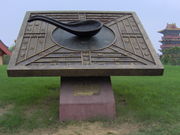
.jpg)
